Sony Group PRS950 Digital Book Reader User Manual
Sony Corporation Digital Book Reader
Contents
- 1. User Manual
- 2. Regulatory section of user manual
User Manual
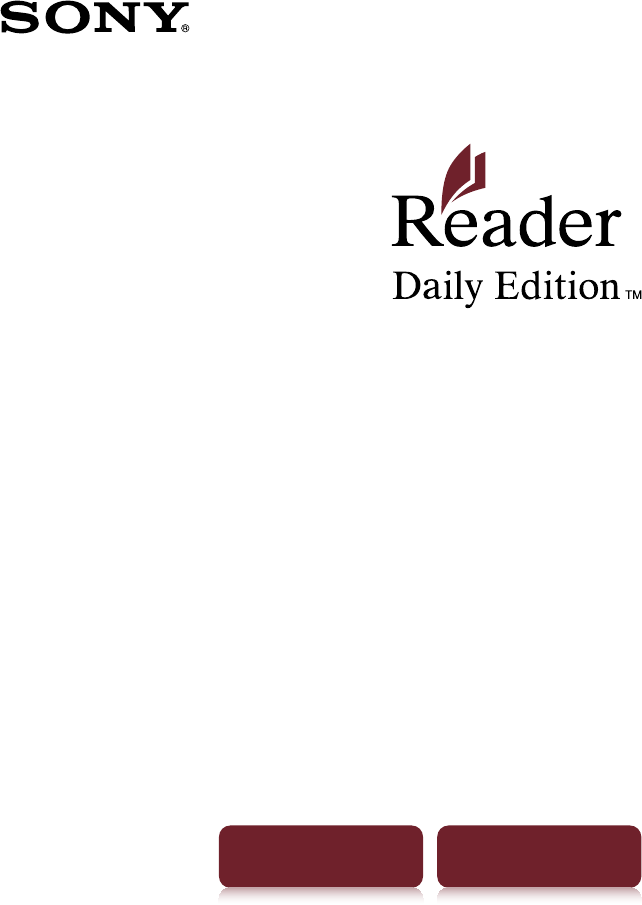
©2010 Sony Corporation 4-260-631-11(1)
PRS-950
User Guide V1.0
Digital Book Reader
Click for instant access!
Table of Contents Index

2
Table of Contents Index
CONGRATULATIONS
Your Reader Daily Edition™ comes with these
useful features:
ˎ
Unplug and unwind – with mobile network
and Wi-Fi connection, you can download
ebooks straight to your Reader™ without a
computer and take your library on the go.
ˎ
7” e-paper with Clear Touch Screen – with on
a high quality screen, all you need is a soft
touch by swiping to turn pages, tap to
bookmark, take notes and highlight.
ˎ
Font Zoom – increase or decrease the text
size to your preference, or zoom into images
to take a closer look.
ˎ
Dictionary and Wikipedia – simply double-
tap a word to see its definition or learn more
from Wikipedia’s website.
Read on. There’s so much more.
ˎ
Personalize the standby screen with your
favorite picture.
ˎ
Use the “Collections” feature to organize your
library on your Reader to find the book you want
to read.
For more details, please refer to this User Guide.
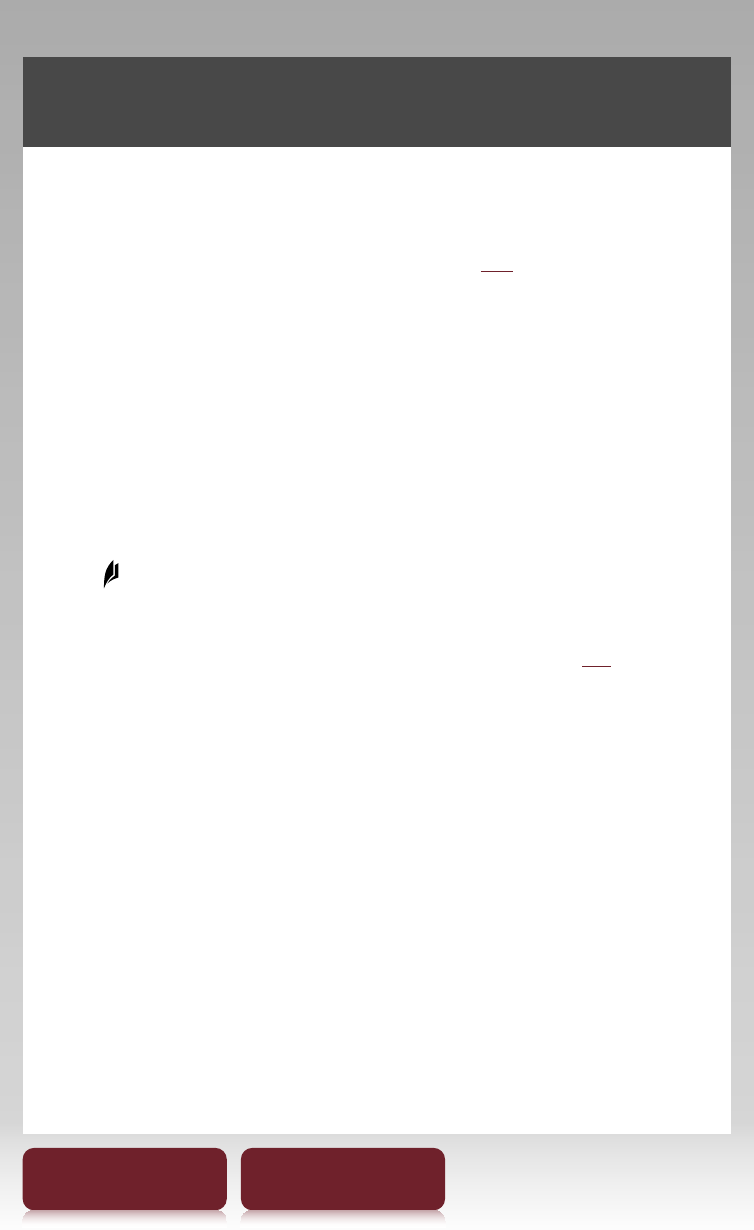
3
Table of Contents Index
Support
Support for the Reader
First, check “Troubleshooting” (r96) and refer to
the Reader Library™ Help to resolve the issue.
Support Web site and contact:
www.sony.com/readersupport
Phone number: 1-866-962-7669
Support for the Reader™ Store
Go to the Reader Store Help and Support page
according to the followings.
Tap [Store] at [Home] menu p press OPTIONS p
tap [Help and Support].
For details about the Reader Store, see rxx.
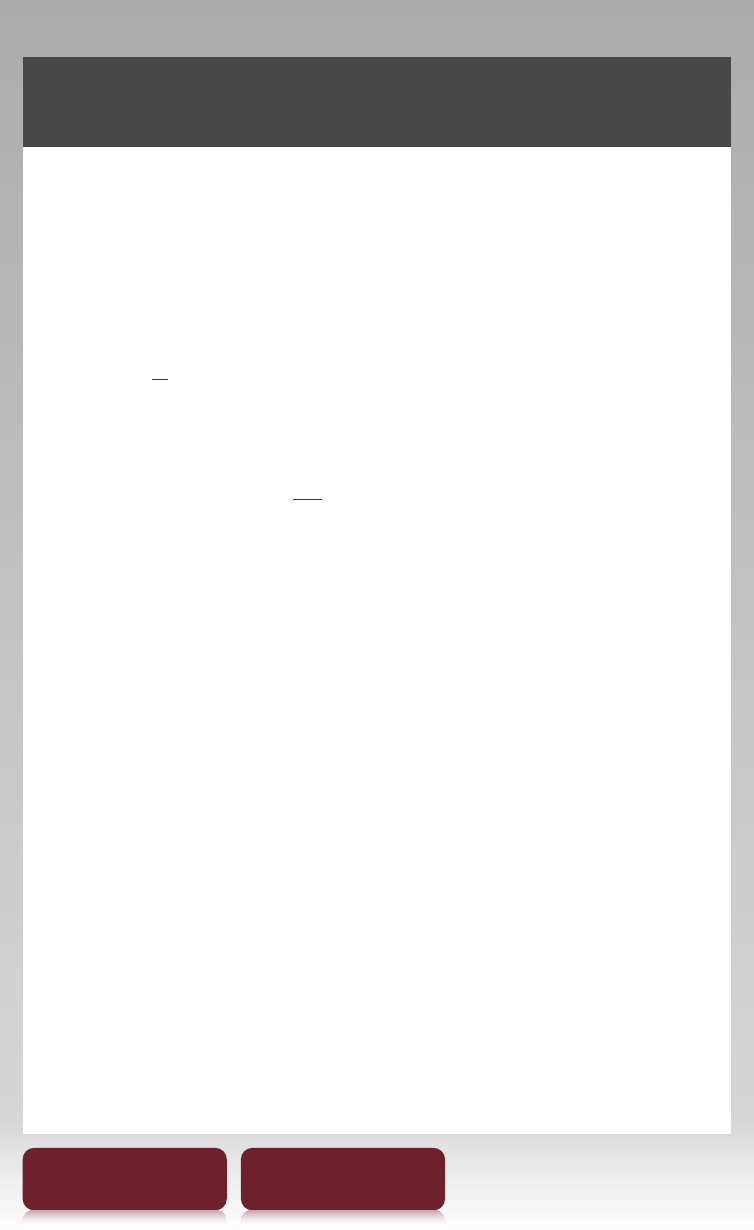
4
Table of Contents Index
About the User Guide
When using your Reader to view this User Guide,
please note the following instructions.
To use the page links
Tap the page link to jump to the page directly
(e.g., r5). To return to the previous page, press
OPTIONS p tap [Go to] p [Previous View].
To enlarge a page
See “Zooming in” (r49).
Screen shots in this manual may be different from the
actual display in the Reader.
To use the link icons
Tap one of icons located at the bottom of the page
to view either “Table of Contents” or “Index”.
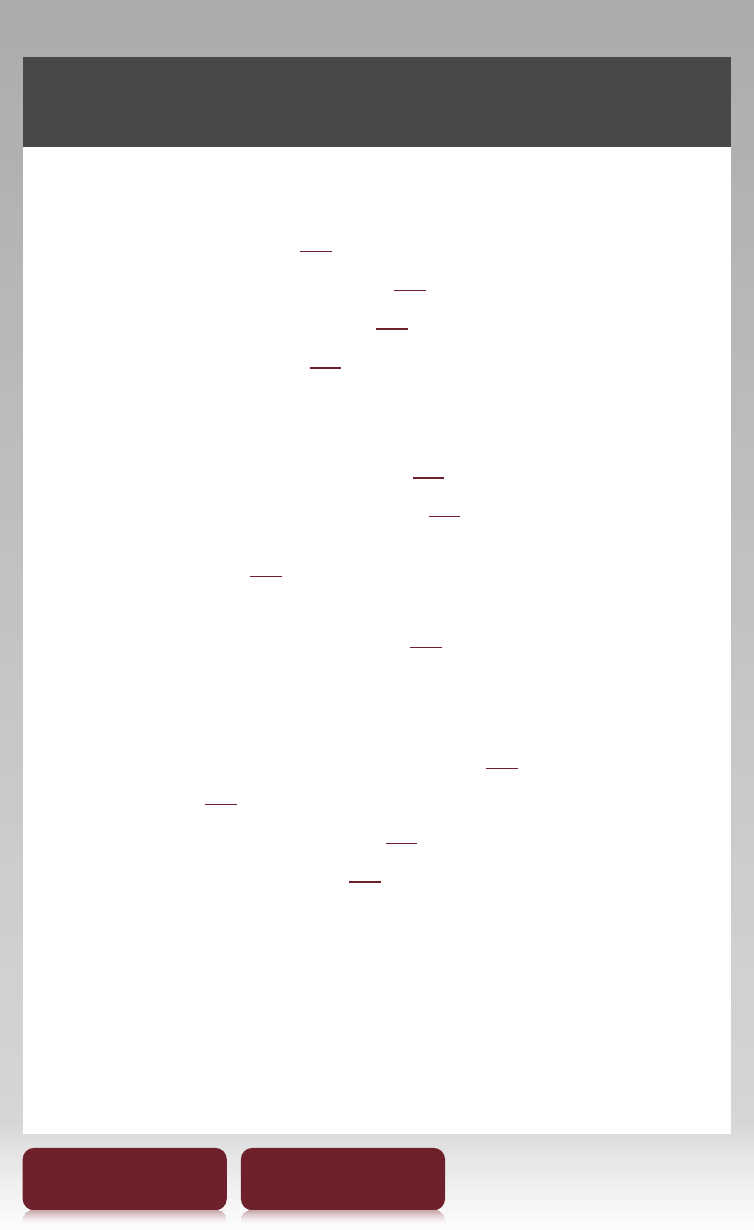
5
Table of Contents Index
Useful Features
Annotation
ˎ
Bookmarking (r39)
ˎ
Highlighting Word(s) (r40)
ˎ
Handwriting a note (r41)
ˎ
Adding a note (r42)
Resizing
ˎ
Adjusting the text size (r47)
ˎ
Changing a page mode (r48)
Zooming in (r49)
Adjusting Content View (r52)
Searching
ˎ
Finding notes within a book (r44), among
books (r46)
ˎ
Searching keywords (r55)
ˎ
Searching a book (r34)
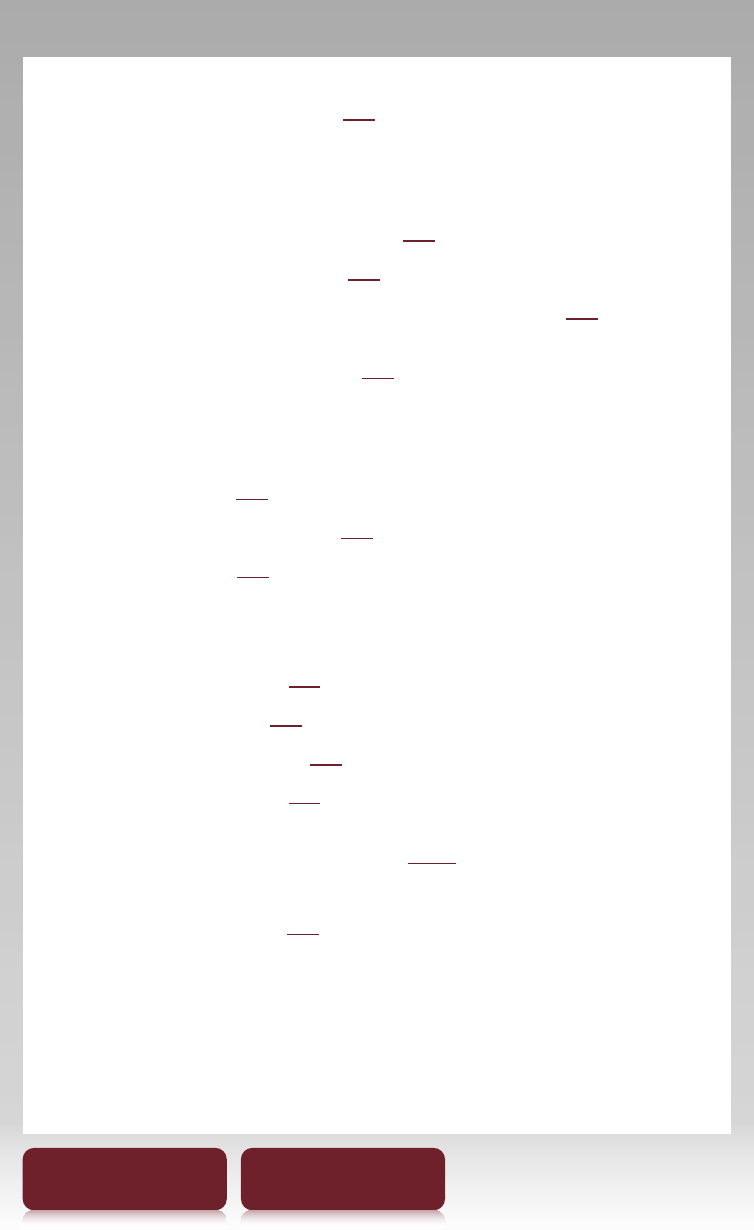
6
Table of Contents Index
Jumping to a page (r57)
Dictionary
ˎ
When reading a book (r60)
ˎ
As an application (r82)
ˎ
List of previously looked up words (r63)
Reading Periodicals (r65)
Collection Management
ˎ
Creating (r68)
ˎ
Adding contents (r70)
ˎ
Deleting (r72)
Other Applications
ˎ
Handwriting (r77)
ˎ
Text Memo (r80)
ˎ
Picture Viewer (r83)
ˎ
Audio Player (r85)
Supported File Formats (r121)
Specifications (r19)

7
Table of Contents Index
Mobile network and Wi-Fi
ˎ
Connecting mobile network (rxx)
ˎ
Connecting Wi-Fi (rxx)
ˎ
Reader Store (rxx)
Browsing Internet Content (rxx)

8
Table of Contents Index
Table of Contents
About the User Guide..............................................4
Useful Features ........................................................5
Chapter 1
Overview
Parts and Controls.................................................................15
Specifications..........................................................................20
Chapter 2
Getting Started
Charging the Reader............................................................23
Power Saving Tips .................................................................25
Basic Operation
Touch Screen...........................................................................28
On-screen keyboard........................................................31
Home Menu.............................................................................33

9
Table of Contents Index
Getting Content
Accessing the Reader Store Wirelessly ..........................36
Creating Reader Store Account........................................39
Making Purchases .................................................................40
Downloading Content.........................................................42
Accessing the Reader Store with your computer ......45
Step 1: Installing Reader Library .................................47
Step 2: Creating an Account and Purchasing
eBooks ...............................................................................49
Step 3: Transferring your eBooks to your Reader..51

10
Table of Contents Index
Chapter 3
Reading Content
Reading Books........................................................................54
OPTIONS Menu ......................................................................56
Annotation...............................................................................60
Bookmarking .....................................................................60
Highlighting word(s).......................................................61
Handwriting a note .........................................................62
Adding a note....................................................................63
Finding a Note........................................................................65
Searching for notes within a book.............................65
Finding the notes in all contents................................67
Resizing.....................................................................................68
Changing a page mode .................................................69
Zooming in.........................................................................70
Adjusting Content View ......................................................73
Screen Orientation................................................................75
Searching .................................................................................76
Jumping to a Page ................................................................78
Using Embedded Dictionaries..........................................81
Listing previously looked up words ..........................84

11
Table of Contents Index
Using Wikipedia .....................................................................85
Reading Periodicals ..............................................................87
Reading from Memory Stick™ or SD Card ....................90
Browsing Internet Content
Browsing Websites (Open Browser)................................92
Browsing Web Site ...........................................................92
Registering sites in bookmark.....................................94
Collections
Collections ...............................................................................98
Creating ...............................................................................98
Adding contents...............................................................99
Deleting a collection....................................................100
Removing contents ......................................................101
Managing Content.............................................................102
Deleting Content........................................................... 102
Protecting Content....................................................... 103
Managing periodicals.................................................. 104

12
Table of Contents Index
Applications
Applications menu............................................................. 106
Using an embedded dictionary ............................... 107
Creating drawings......................................................... 108
Creating text memos ...................................................111
Viewing pictures............................................................ 113
Playing audio files.........................................................115
Settings
Changing Settings .............................................................118
[General Settings]..........................................................120
[Application Preferences] ........................................... 121
[System Management]................................................122
[Initialization]..................................................................124
[Wireless Controls]........................................................125
[Wi-Fi Network Settings].............................................126
Troubleshooting
Troubleshooting .................................................................135
Symptoms........................................................................ 136

13
Table of Contents Index
Appendix
Precautions...........................................................................145
Copyright Notice ................................................................ 155
GNU GENERAL PUBLIC LICENSE............................... 157
Supported File Formats....................................................158
System Requirements.......................................................160
Index ....................................................................................... 162

14
Table of Contents Index
Chapter 1
Overview ................................................... X - XX
Parts and Controls...................................................... 7
Specifications ............................................................22
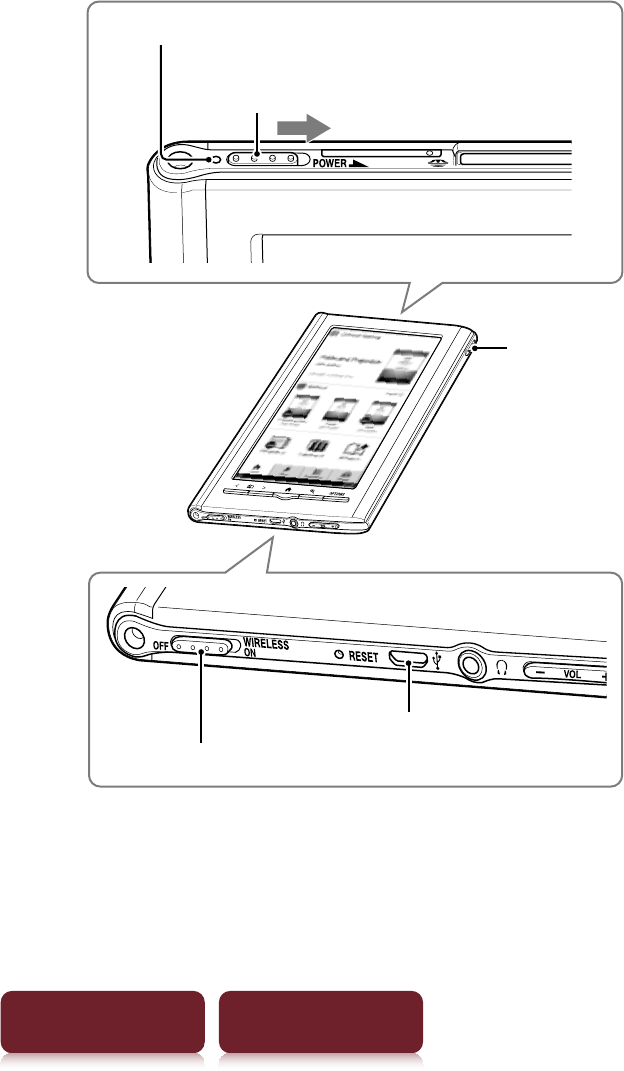
Overview
15
Table of Contents Index
Parts and Controls
Charge/Busy indicator
Power switch Slide to the right and
release quickly
Stylus
WIRELESS switch
Micro USB connector
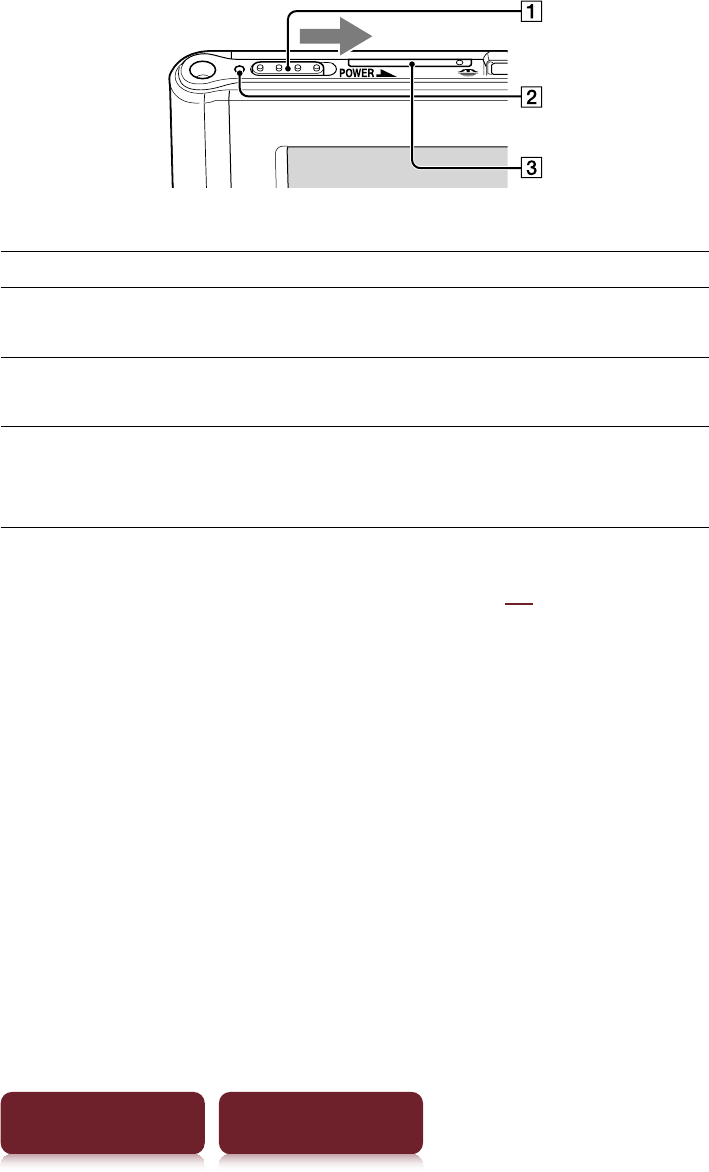
Parts and Controls
16
Table of Contents Index
ȩPower Switch
To Action
Power on or wake up
from sleep mode1
Slide to the right and release quickly.
Enter sleep mode Slide and release quickly. The standby
screen2 appears.
Power off
completely
When not in sleep mode slide and
hold for more than 3 seconds. Follow
the instructions on the screen.
1Battery consumption is minimized in sleep mode.
2For details about [Standby Screen], see r94.
ȪCharge/Busy indicator
Red: Charging in progress
Orange: When booting/shutting down/internal
memory access
Off: Off/Sleep mode/Reader in operation
ȫSIM Card Slot
A SIM card is installed to provide wireless
communication. Please do not remove it.
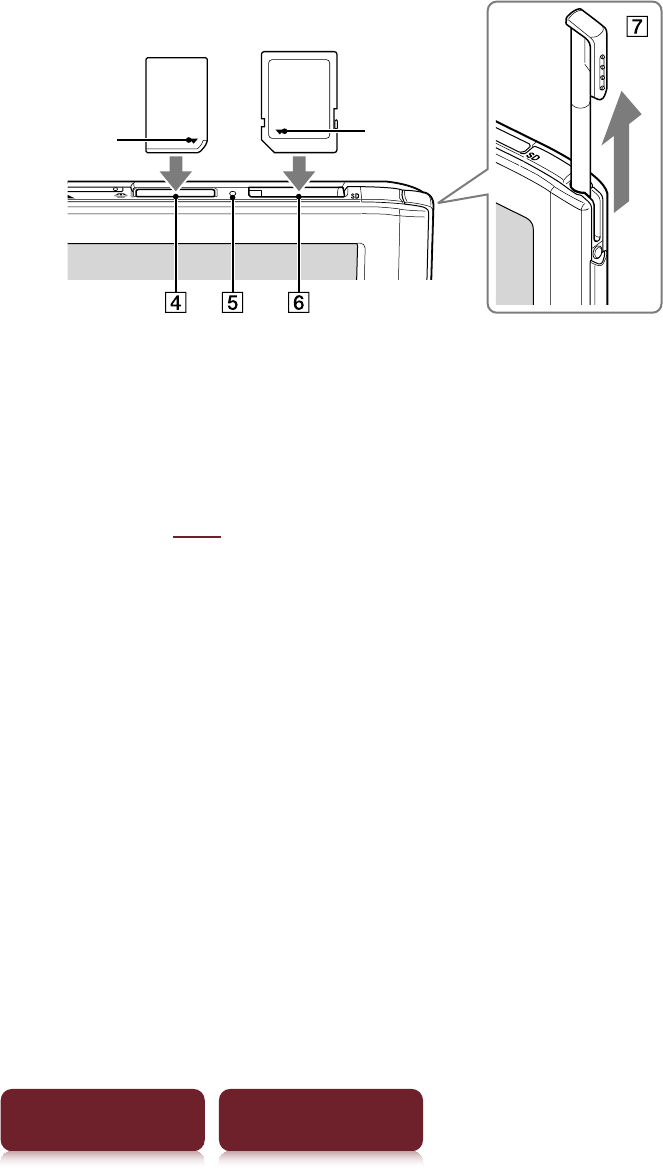
Charging the Reader
17
Table of Contents Index
Memory Stick Duo™
media
SD card
è Mark è Mark
ȬMemory Stick PRO Duo™ slot
ȭMemory card access indicator
Lights up in orange during memory card access.
ȮSD card slot
Please see r122 regarding memory card usage.
ȯStylus
For more precise operations, use the supplied stylus.
Insert fully into the holder when not in use.
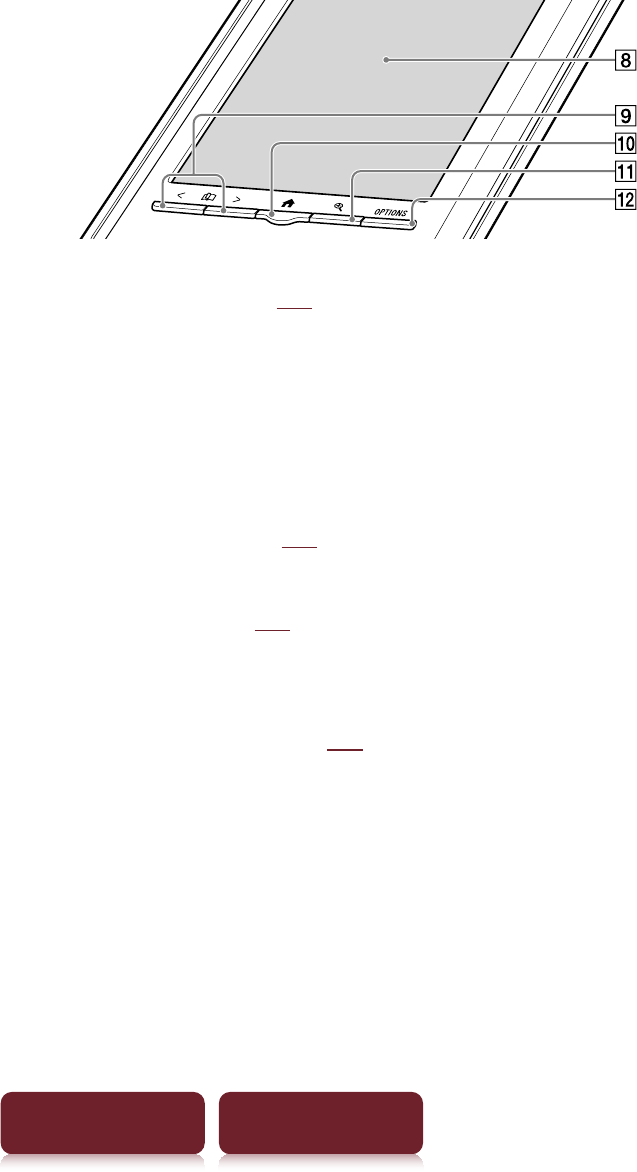
Charging the Reader
18
Table of Contents Index
ȰTouch screen (r23)
Lightly tap the screen either with a finger, or the
supplied stylus to navigate.
ȱPage Turn buttons
Press < (previous) or > (next) to turn the page.
Press and hold < or > to turn pages continuously.
ȲHome button (r29)
Shows the [Home] menu.
ȳSize button (r47)
Shows a utility to change text size, zoom a page and
select a page mode.
ȴOPTIONS button (r31)
Shows the menu for relevant optional functions.
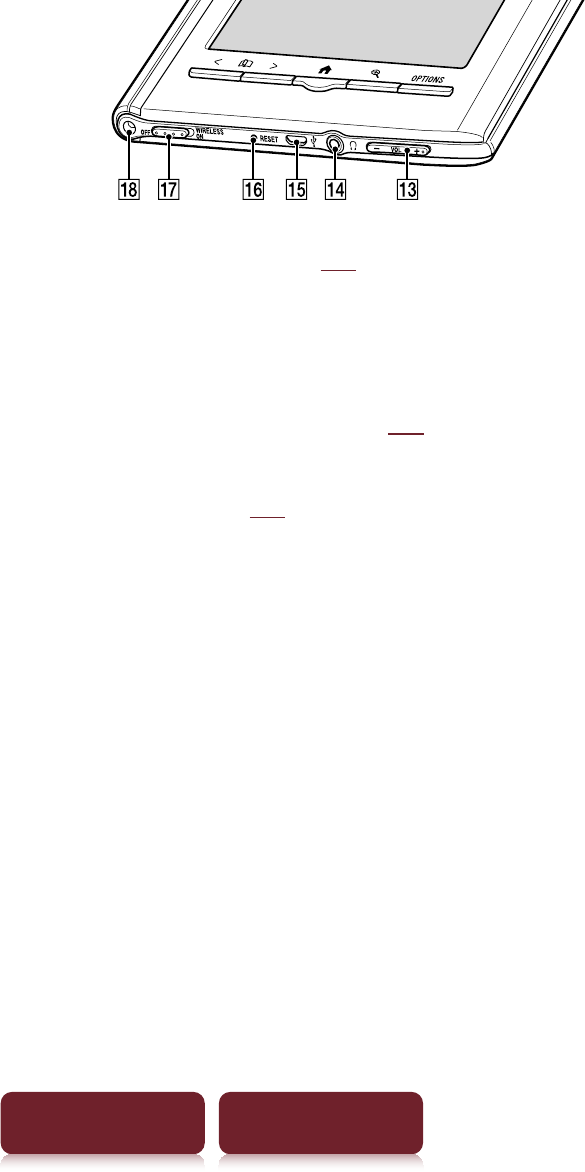
Power Saving Tips
19
Table of Contents Index
ȵVolume button* (r87)
Adjusts the volume when playing an audio file.
* A tactile dot on the + button helps with ease of operation.
ȶHeadphones jack
ȷMicro USB connector (r12)
Used for transferring data and charging the Reader.
ȸRESET hole (r96)
ȹWIRELESS Switch
Sets to ON when using mobile network or Wi-Fi
network.
ȺHoles for optional cover attachment
With the same hole in the left top corner of the Reader,
an optional accessory cover can be attached.

Specifications
20
Table of Contents Index
Specifications
Model name
PRS-950
Power source
Built-in rechargeable battery: 3.7 V DC
AC adapter: 5.0 V DC, 1,500 mA
USB communication: Hi-Speed USB (USB 2.0 compliant)
Battery life (continuous playback)
Maximum Battery: Approx. 12,000 continuous page turns
when reading only *
* Measured using a fully charged battery and counting
consecutive ePub format page-turns at approx 1 page per
sec. Actual battery life may vary based on usage patterns
and specific device.
User available capacity
Approx. 1.6 GB after initial setting
Depending on size of pre-loaded excerpts, available memory
capacity may vary.
Operating/charging temperature
41°F to 95°F (5°C to 35°C)
Dimensions (w/h/d)
Approx. 200 × 128 × 9.6 mm (7 7/8 × 5 1/8 × 13/32 inches)
Mass
Approx. 275 g (9 7/10 oz.)
Display:
7.1” (180.98 mm) diagonal electrophoretic display
600 × 1,024 pixel, 0.151 × 0.153 pixel/mm

Specifications
21
Table of Contents Index
16-level gray scale
Wireless WAN (3G):
HSPA/WCDMA 800/850/900/1900/2100 MHz
GPRS/EDGE 850/900/1800/1900 MHz
Wireless LAN:
802.11b / g compliant
Expansion slots
Memory Stick PRO Duo™ slot, SD card slot
Please see r122 regarding memory card usage.
Design and specifications are subject to change
without notice.

22
Table of Contents Index
Chapter 2
Getting Started......................................... X - XX
Charging the Reader...............................................XX
Power Saving Tips ....................................................XX
Basic Operation ........................................ X - XX
Touch Screen .............................................................XX
Home Menu ...............................................................XX
Getting Content............................................. XX
Accessing the Reader Store wirelessly .............XX
Connection Options................................................XX
Reader Store Registration .....................................XX
Making Purchases....................................................XX
Accessing the Reader Store from your
computer ....................................................................XX
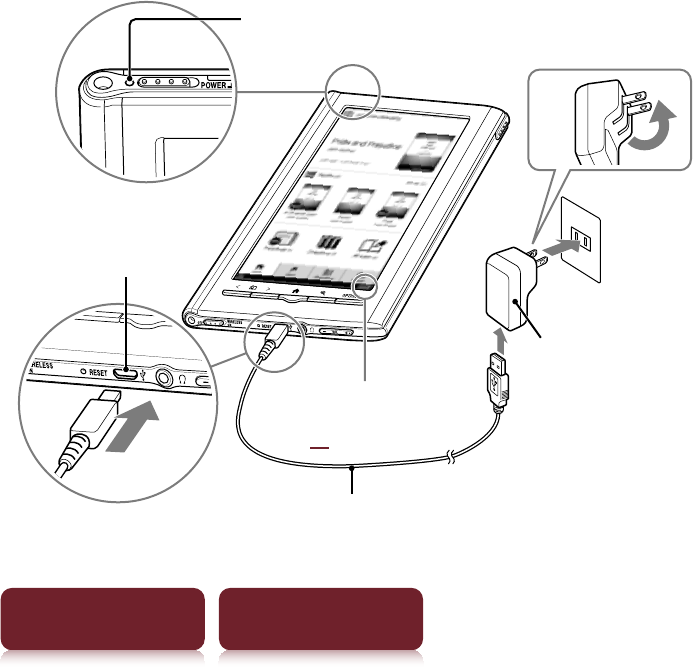
Getting Started
23
Table of Contents Index
Charging the Reader
Charge your Reader by connecting to an AC outlet
using the supplied AC adapter (PRSA-AC1).
The time to completely charge a depleted battery is
about 3 hours.
1Connect one end of the USB cable to the micro
USB connector of the Reader, and the other
end to the AC adapter.
2Connect to an AC outlet.
The indicator on the Reader lights up in red while
charging, and goes off when charging is completed.
Charge/Busy indicator
Micro USB connector
USB cable
AC adapter
(PRSA-AC1)
AC outlet
Battery status indicator
(rxx)
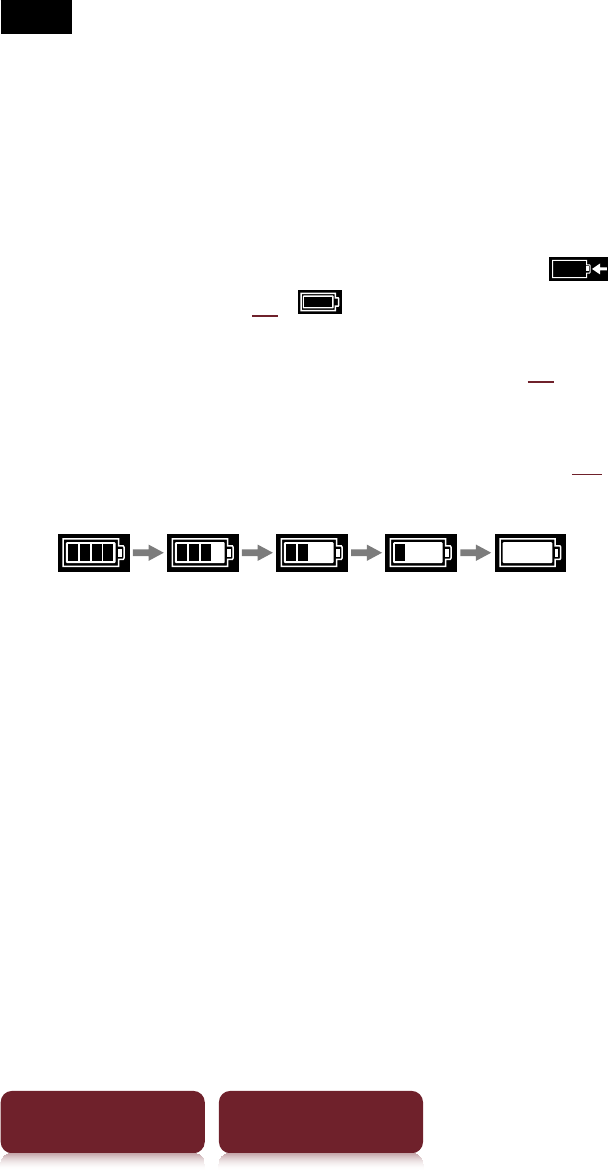
Charging the Reader
24
Table of Contents Index
Notes
ˎ
Do not use an AC adapter other than this one with the
Reader.
ˎ
Connect the AC adapter to an easily accessible AC outlet.
Should you notice an abnormality in the AC adapter,
disconnect it from the AC outlet.
Tips
ˎ
While charging with the optional AC adapter, appears
in the status bar (rxx). appears when fully charged.
ˎ
The Reader can also be charged by connecting it to your
computer with the USB cable (supplied) (rxx). The time to
completely charge a depleted battery is about 5.5 hours.
To check battery status in the status bar (rxx) during
use
Charging battery recommended
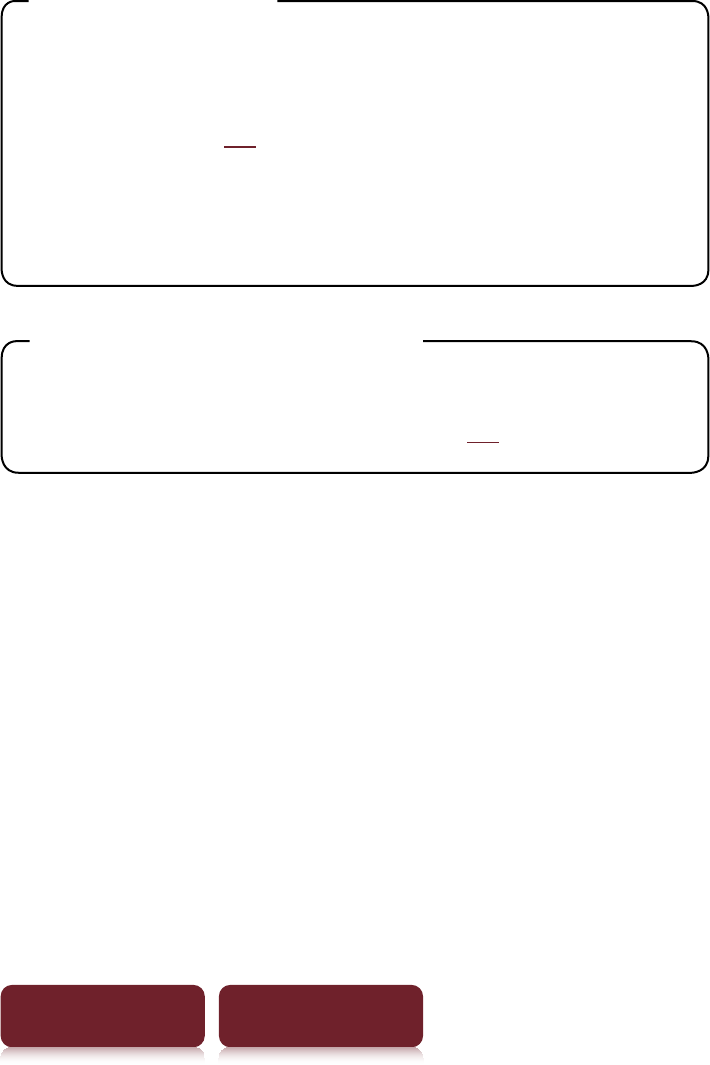
Power Saving Tips
25
Table of Contents Index
Power Saving Tips
Charging Battery
¼To fully charge your Reader, continue
charging until indicator shows completion of
charge (r12).
¼Charging a completely depleted battery will
take 3.75 hours when connected to the
supplied AC adapter (PRSA-AC1).
Recommended Temperature
Please use your Reader within the recommended
operating temperature range (r19).

Power Saving Tips
26
Table of Contents Index
More power requiring operations
The following cases may consume more power.
¼Using mobile network or Wi-Fi network
¼Graphics intensive content
¼Playing audio files
¼Photo slideshow with a short duration
¼Using external memory cards
¼Frequent insertion and ejection of memory
cards
¼An excessive number of contents in a
memory card
¼ePub and PDF files partially conforming to
document standard
¼Annotation, keyword search and dictionary
search functions
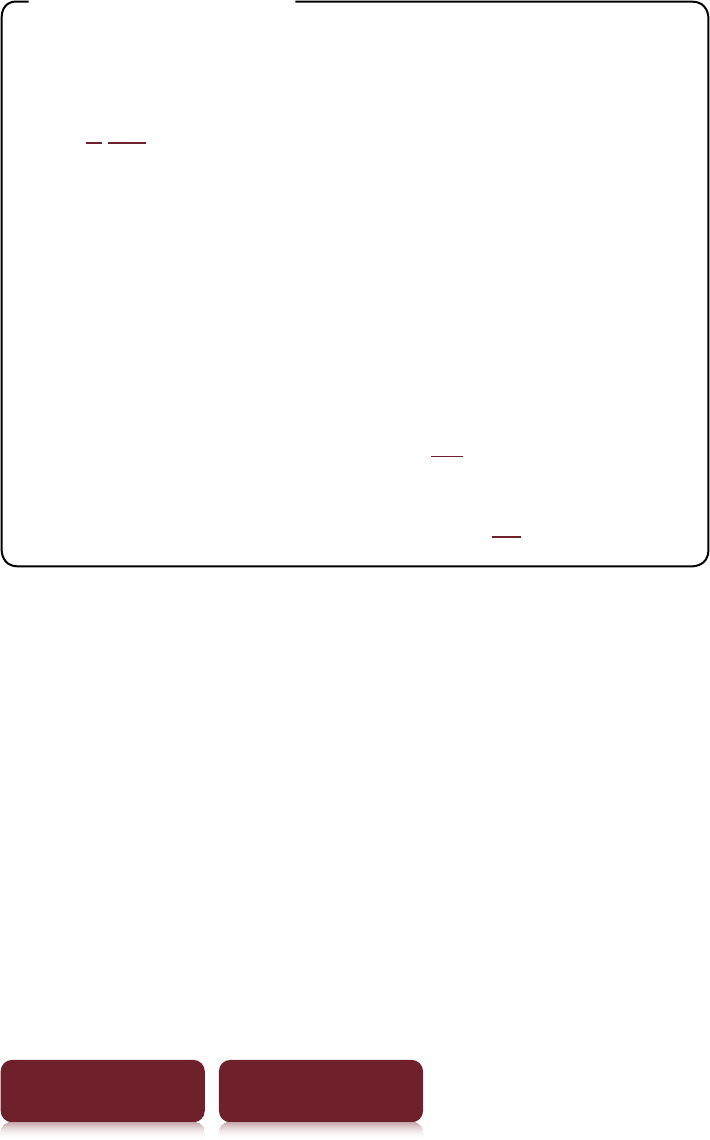
Power Saving Tips
27
Table of Contents Index
Tips to save power
¼If you do not use the Reader for more than
one day, power off the Reader completely (r
8, 89).
¼Do not leave the Reader uncharged for a
prolonged period of time. This may reduce
the charging capability.
¼We recommend the supplied AC adapter
(PRSA-AC1). The performance of any third
party charger is not guaranteed.
¼Please keep the Reader at normal
temperature operation (r19).
¼If you do not use mobile network or Wi-Fi, set
the WIRELESS switch to OFF (rxx).
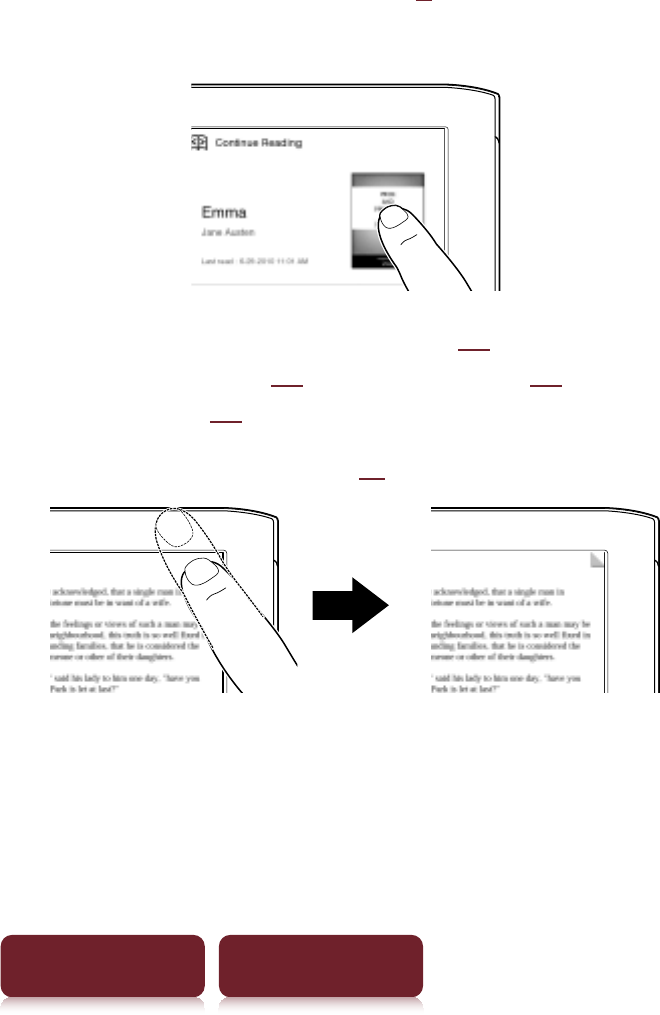
Basic Operation
28
Table of Contents Index
Touch Screen
You can perform various touch operations with a
finger or the supplied stylus. (r9)
Single-tapping: for selecting an item
Double-tapping: for bookmarks (r39), instant
dictionary search (r60), word search (r55),
highlighting (r40), etc.
Example: creating a bookmark (r39)
Tip
To delete a bookmark, double-tap it.
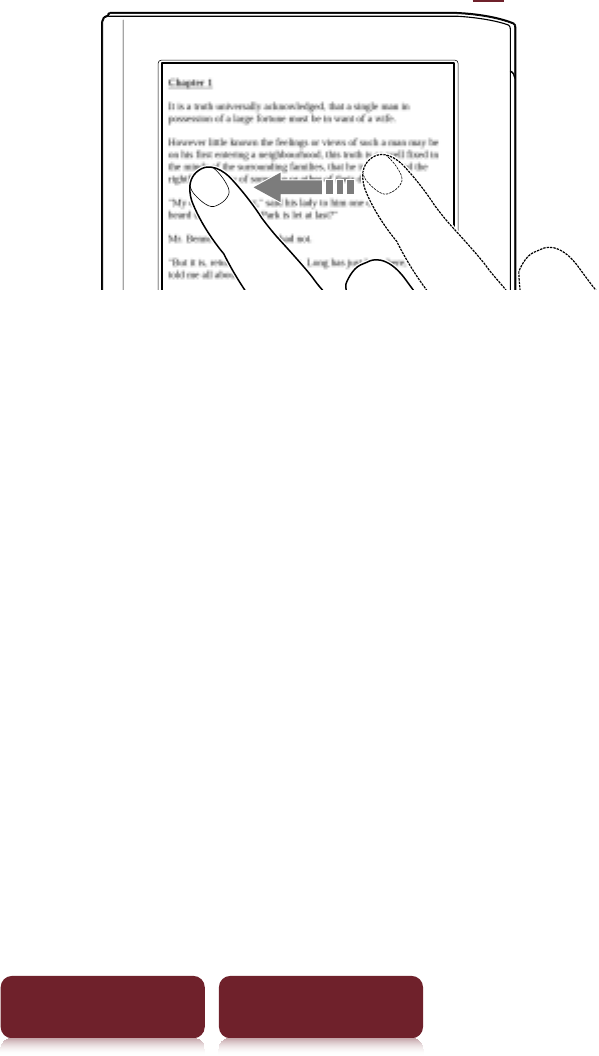
Touch Screen
29
Table of Contents Index
Swiping
In the page view, swiping the screen turns a page. To
change page turn preference, see r90.
Swiping and holding
Swipe and hold the page to turn pages repeatedly.
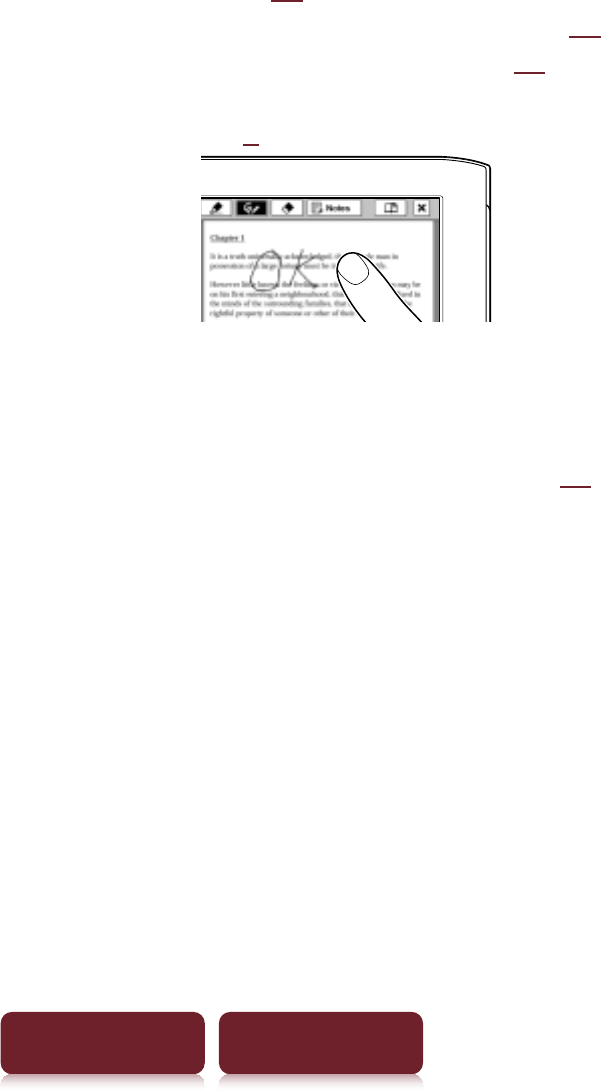
Touch Screen
30
Table of Contents Index
Dragging
In zoom-in mode (r49), tap and drag to reposition
the displayed page. In the [Handwriting] (r77)
application or [Create/Edit] function (r41),
handwriting on the screen can be performed with the
supplied stylus (r9) or a finger.
Double-tapping and dragging
Double-tap the first word, drag to the last word slowly
and release to select consecutive words (r40).
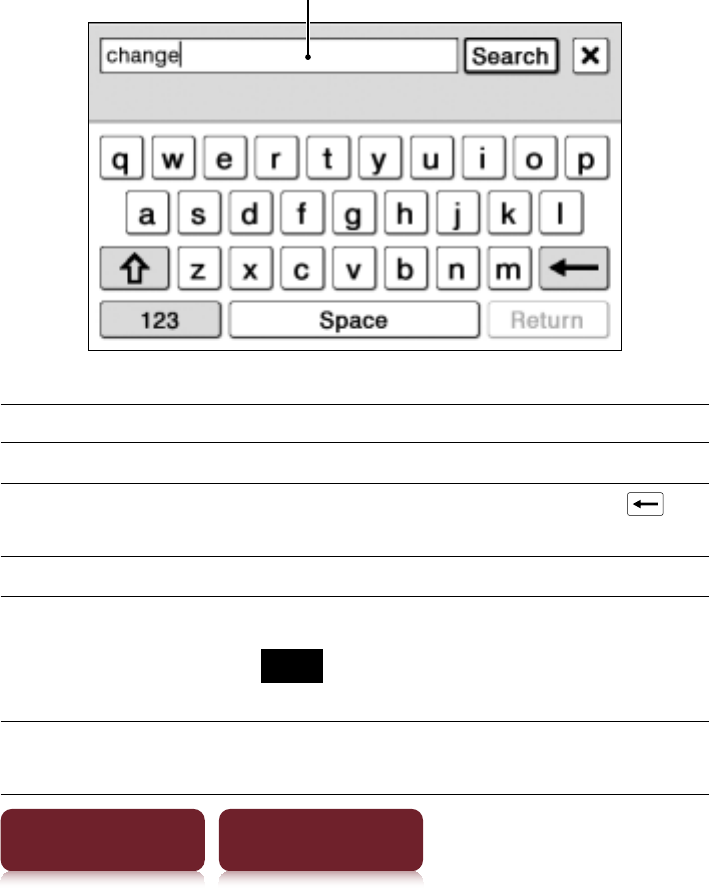
Touch Screen
31
Table of Contents Index
On-screen keyboard
The on-screen keyboard is used for many functions.
Tip
The key array of the keyboard varies depending on the
category of the input text (URL, telephone number,
numerical value, etc.).
Input area
To Perform at input area
Edit Tap to place the cursor.
Delete a character Tap to place the cursor and tap to
delete a character before the cursor.
Finish inputting Tap [OK], [Search] or [Done].
Insert line feed Tap [Return].
Note
[Return] is invalid with [Search].
Switch the keyboard
type
Tap [123] to switch to the symbol
keyboard. To return, tap [Abc].
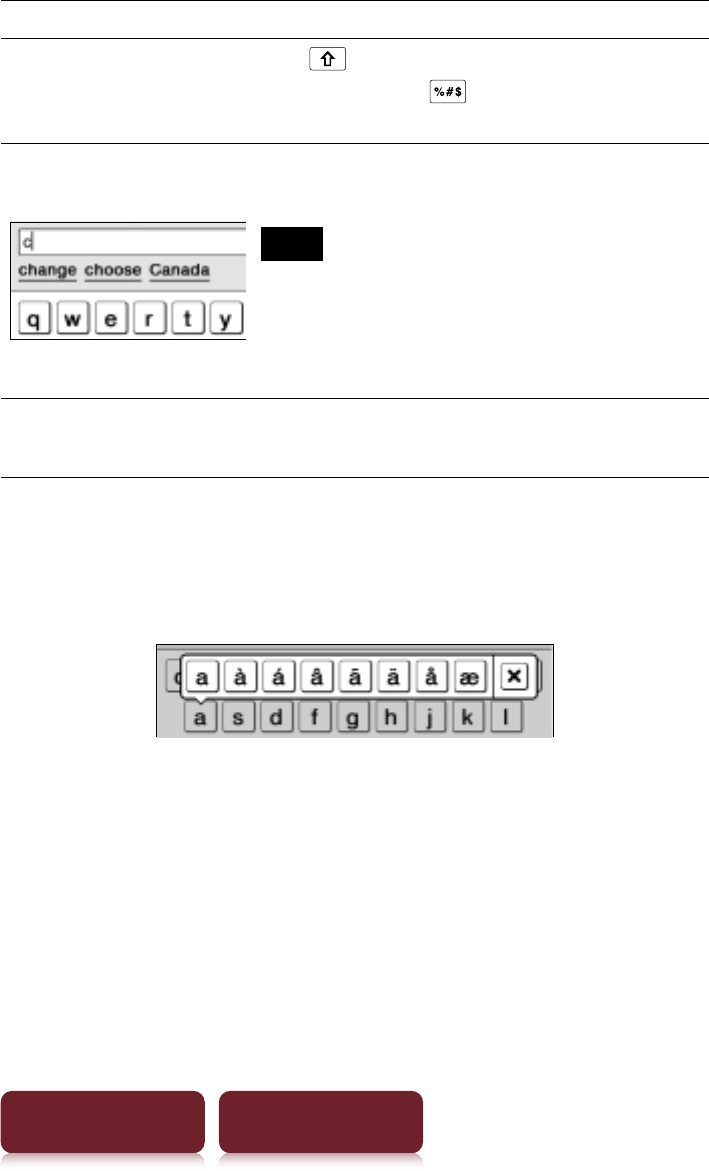
Touch Screen
32
Table of Contents Index
To Perform at input area
Switch the character
type
Tap to switch to the upper-case
keyboard. Tap to switch to
additional characters.
Input previously
entered words
Tap one of previously entered words
shown below the input area.
Note
Keyboard history only records
(hyphened) words of 4 to 15 letters.
Numbers or other symbols are
excluded.
Move the cursor Tap î/Ô to move the cursor in input
area.
To input optional characters
Tap and hold an applicable character key will pop up
optional characters.
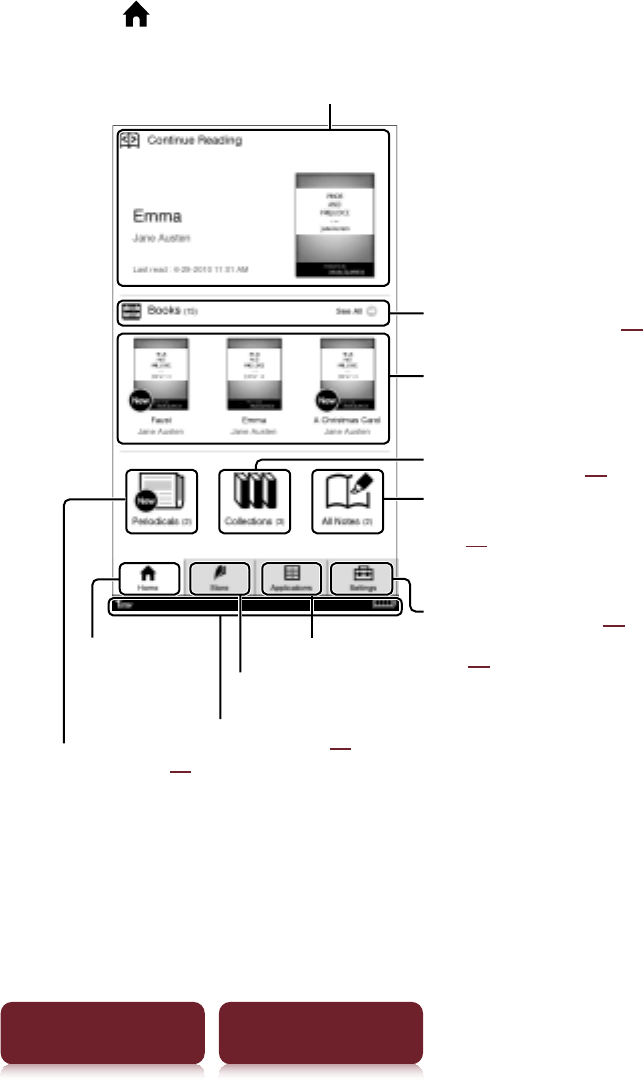
Touch Screen
33
Table of Contents Index
Home Menu
Press the (Home) button to display the [Home]
menu.
Periodicals (r65)
Last read content
Tap to list book(s) (r36)
Newly loaded book(s)
Collection list (r68)
Bookmarks and annotations
(r46)
Reader settings (r88)
More applications (r76)
Status bar (r30)
[Home] menu
Reader Store
Tip
[New Delivery] appears when a periodical is transferred.
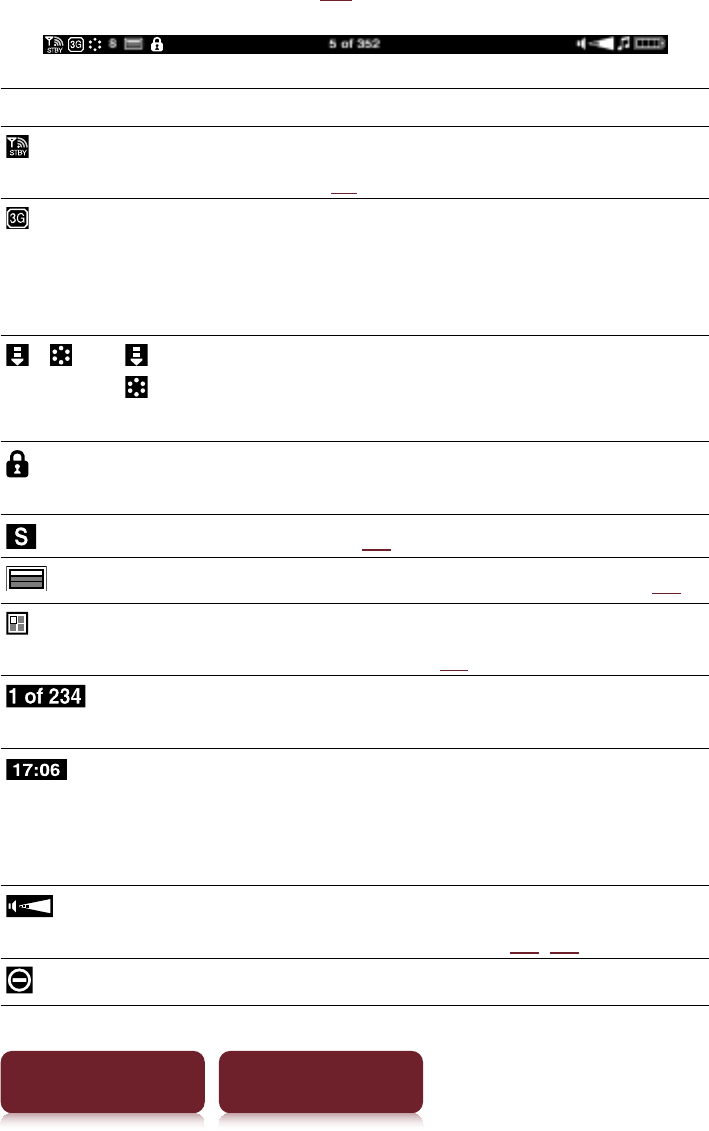
Home Menu
34
Table of Contents Index
About the status bar (r30)
Icon Description
Current status indicator of mobile network and
Wi-Fi network (rxx)
Mobile network (3G) indicator. This appears when
connected to a 3G network, which is faster than a
2G network. The Reader is automatically
connected to a 3G network when available.
/ appears when downloading content.
appears when connecting and downloading a
page in the Reader Store.
SSL compatible site. The current displayed site is
encrypted using SSL.
Current text Size (r47).
Current page position in landscape mode (r54).
Current page position indicator when in either 2
or 3 column split mode (r48).
Page Indicator. Tap this to jump to another page
(r 57).
Current time indicator. Reader shows current time
in the middle of the status bar for 5 seconds after
the OPTIONS button is pressed and returns to the
previous display (either blank or page indicator).
Volume level indicator. This only appears when
the volume button is pressed (r11,87).
An invalid operation.
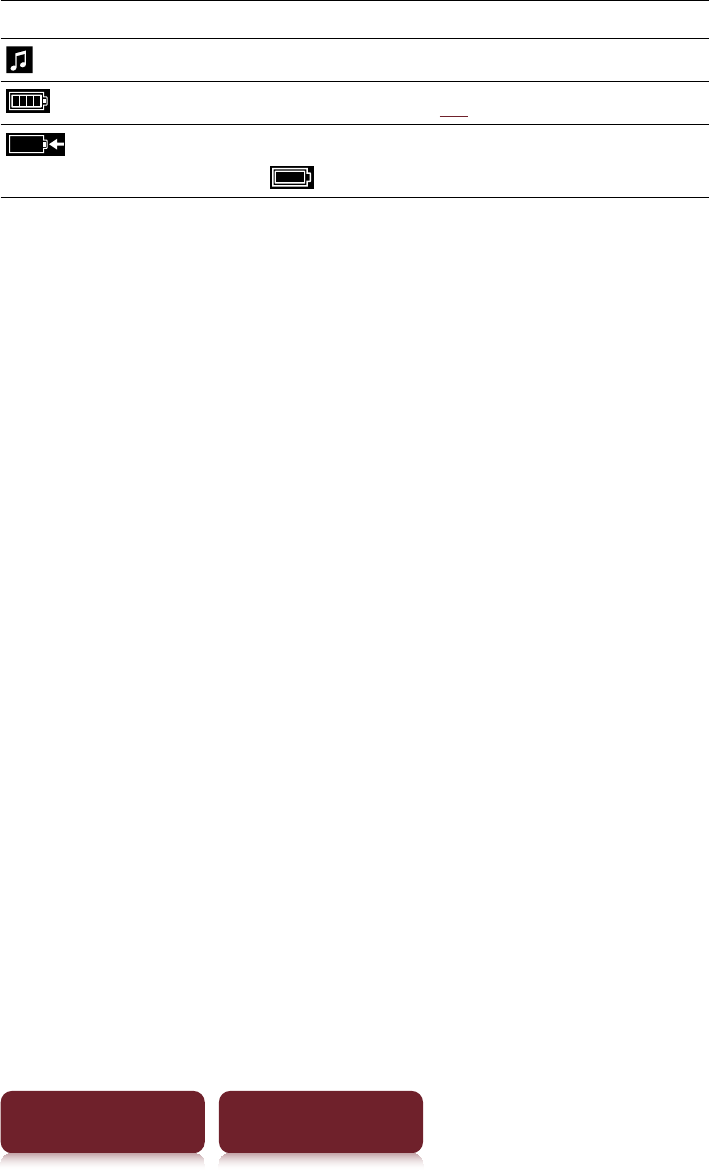
Home Menu
35
Table of Contents Index
Icon Description
Audio playback in background.
Battery status indicator (r13).
While charging with the supplied AC adapter
(PRSA-AC1). appears when fully charged.
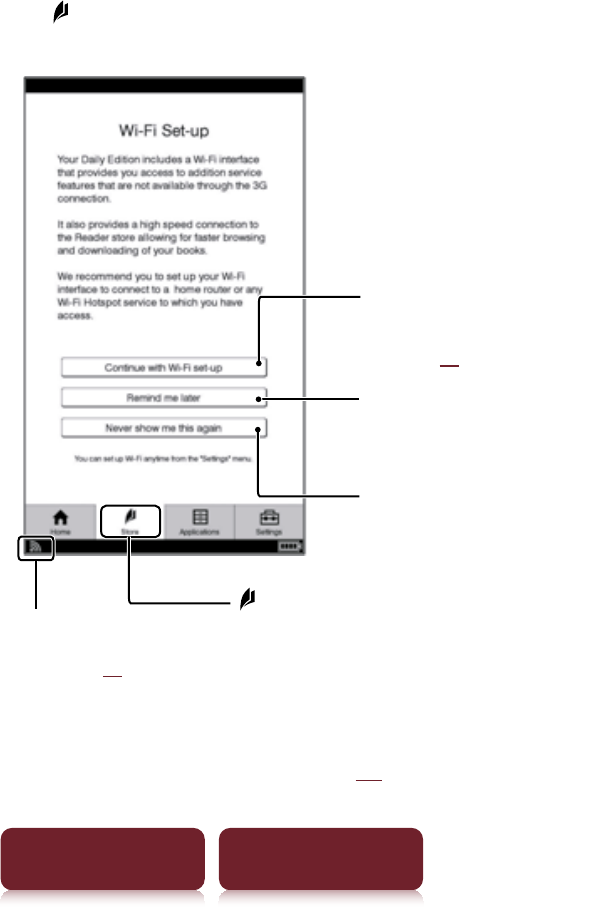
Getting Content
36
Table of Contents Index
Accessing the Reader Store
Wirelessly
With mobile network or Wi-Fi connection, you can
purchase and download eBooks and periodicals
directly from the Reader Store.
Tap [Store] at [Home] menu. [Wi-Fi Set-up] screen
appears.
Connect to a mobile network,
and set the Wi-Fi network later
Connect to a Wi-Fi as preference
network. Follow the on-screen
instruction to set the Wi-Fi network.
For details about the Wi-Fi settings,
see rxx.
Connect to a mobile network without
connecting to Wi-Fi*
Check the network
status (rxx)
[Store]
* To switch the connection between mobile network and Wi-
Fi, see [Wireless Controls] (rxx).
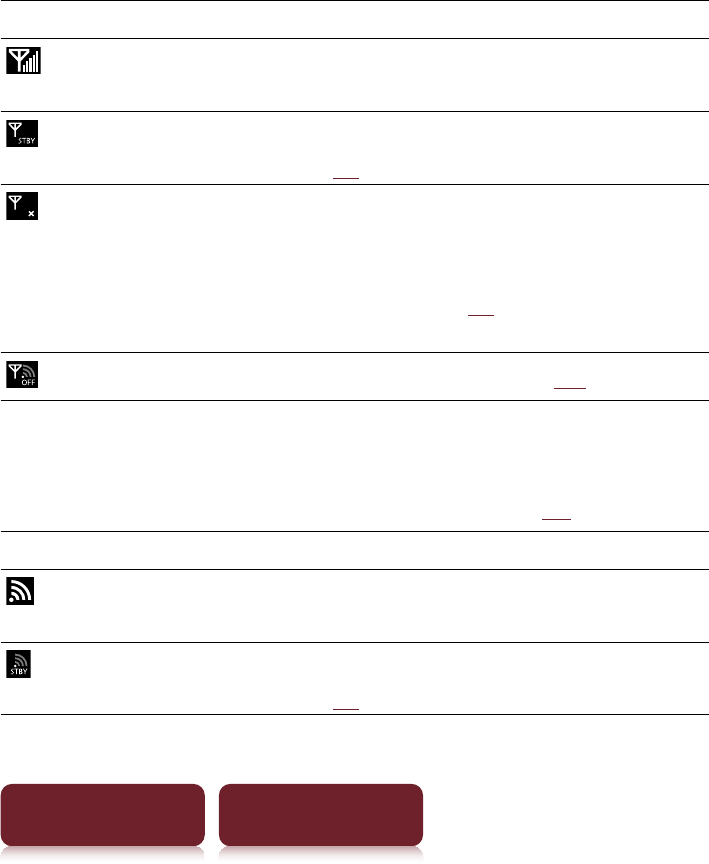
Accessing the Reader Store Wirelessly
37
Table of Contents Index
To check the network status
You can verify the wireless status by the wireless status
icon that is displayed in the bottom left of the screen.
Mobile network status
For information on the network coverage area, please
visit:
http://www.sony.com/readersupport
Icon Status
The Reader is connected to the mobile network.
The more bars, the stronger the signal.
The mobile network feature of the Reader is in
standby mode (rxx).
The Reader cannot receive a mobile network
signal. In this state, you cannot access the Reader
Store. When [Mobile Network] is set to [Off] in the
[Wireless Controls] setting (rxx), this icon is also
displayed
The WIRELESS switch is set to OFF (rXX).
Wi-Fi status (after setting Wi-Fi connection)
For details about the Wi-Fi settings, see rxx.
Icon Status
The Reader is connected to Wi-Fi. The more bars,
the stronger the signal.
The Wi-Fi network feature of the Reader is in
standby mode (rxx).
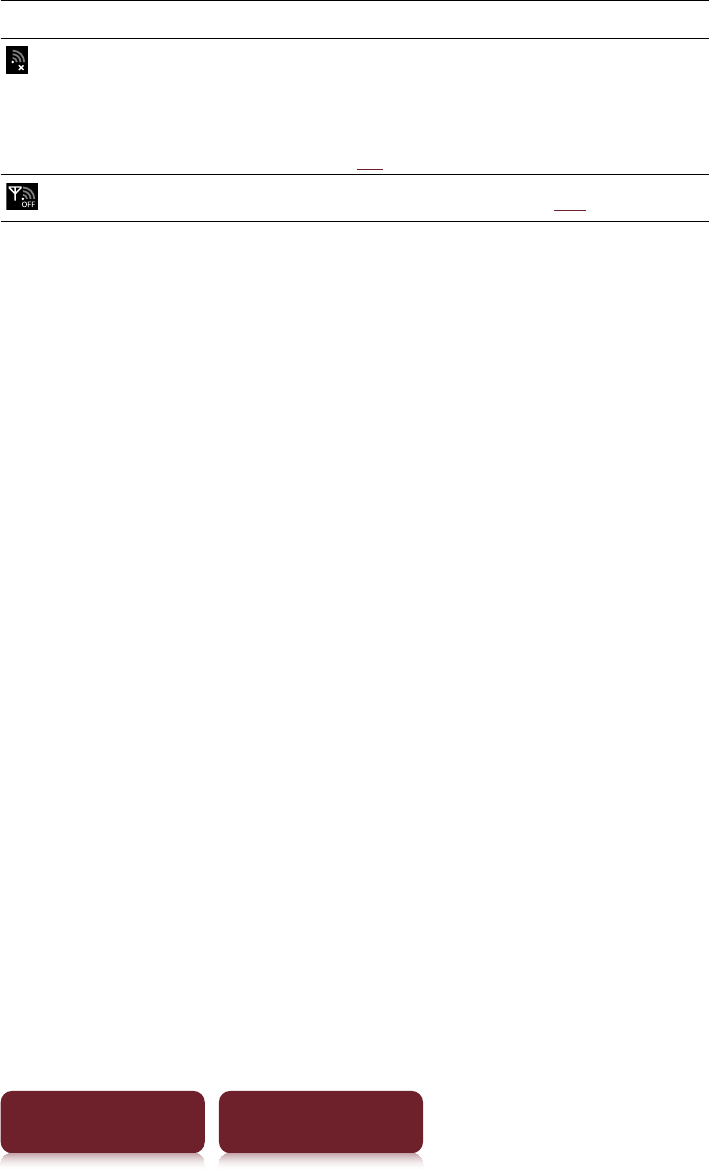
Accessing the Reader Store Wirelessly
38
Table of Contents Index
Icon Status
The Reader cannot receive a mobile network
signal. In this state, you cannot access the Reader
Store. When [Wi-Fi] is set to [Off] in the [Wireless
Controls] setting (rxx), this icon is also displayed
The WIRELESS switch is set to OFF (rXX).
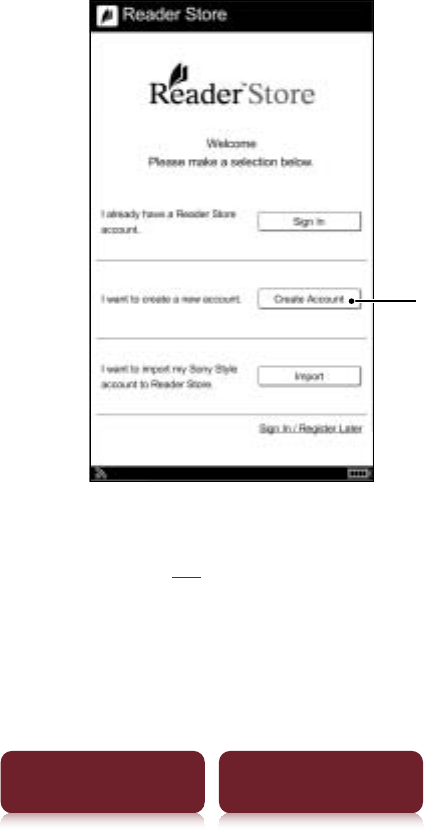
Creating Reader Store Account
39
Table of Contents Index
Creating Reader Store
Account
In order to purchase and download eBooks or
periodicals, you need to register an account at the
Reader Store, or if you already have a Reader Store
account or Sony Style account, sign in via your e-mail
address and password.
Tap [Create Account]
Enter your e-mail address using the on-screen
keyboard (rxx). The Reader will be associated with
your account in the Reader Store.
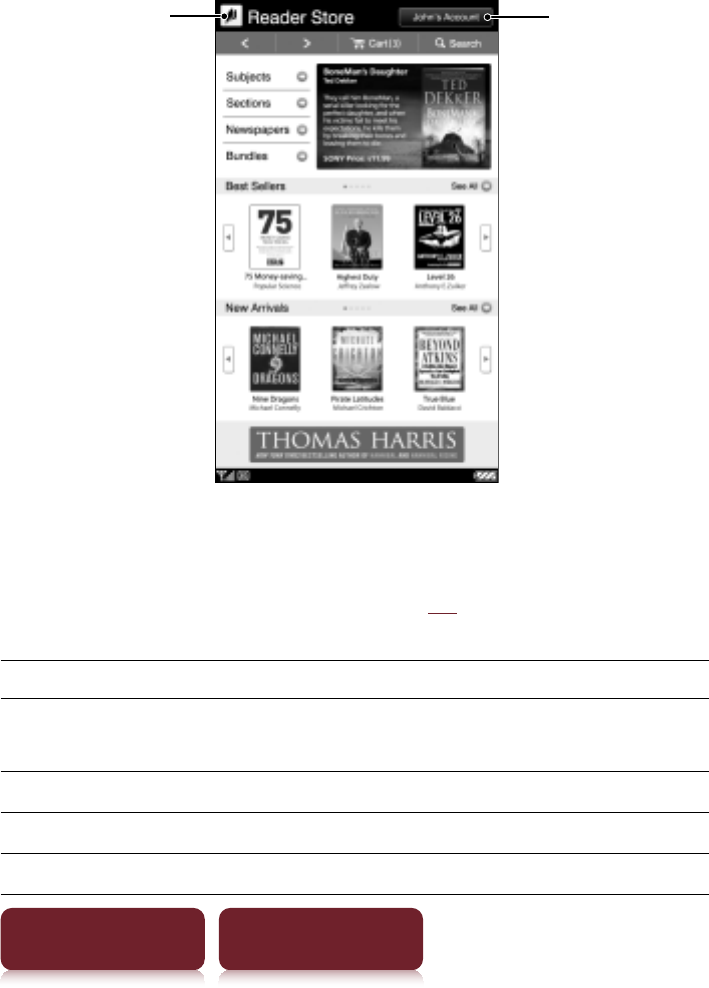
Making Purchases
40
Table of Contents Index
Making Purchases
Browse the Reader Store to find your desired books
and purchase them by following the store instructions.
Display the
information of
the buying
history and the
credit card.
Return to the top
page of the Reader
Store.
OPTIONS menu of the Reader Store
Pressing the OPTIONS button (rxx) will display the
menu for related supplementary functions.
Item Description/Reference page
[Store Home] Displays the top page or the Reader
Store.
[My Account] Displays the [My Account] page.
[Help and Support] Displays the Reader Store Help page.
[Refresh Page] Shows the last read page of the content.

Making Purchases
41
Table of Contents Index
Item Description/Reference page
[Legal Information] Displays the Reader Store Legal
information page.
[Continue Reading] Shows the last read page of the
content.
[Now Playing] Shows audio player (rxx).
[Resume Playing] Resumes audio playback (rxx).
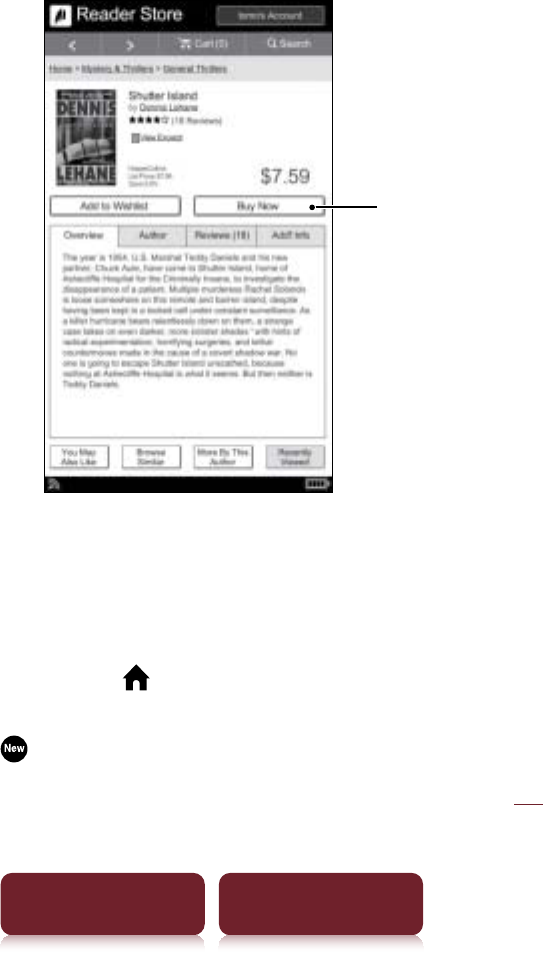
Downloading Content
42
Table of Contents Index
Downloading Content
Select the eBooks that you wish to purchase, and tap
[Buy Now]. Follow the on-screen instructions to
proceed to the purchasing process.
Tap [Buy Now]
At the end of the eBook purchasing process,
[Download completed] is displayed in the status bar
and the purchased eBook can be read from the [Home]
menu.
Press the (Home) button p tap the thumbnail of the
purchased book.
is attached to the newly purchased book.
For details about reading books, see (rxx).

Downloading Content
43
Table of Contents Index
Subscribing to newspapers/magazines
You can subscribe to newspapers/magazines in the
Reader Store.
Go to the periodical menu and follow the store
instructions.
About auto delivery
Once you have subscribed to newspapers/magazines
in the Reader Store, newly published issues will be
delivered to the Reader automatically. To ensure this
process, confirm:
ˎ
The WIRELESS switch is set to ON (rxx).
ˎ
Check that the [Mobile Network] or [Wi-Fi] is set to
[On] in the [Wireless Controls] setting (rxx)
ˎ
The wireless network is available (rxx).
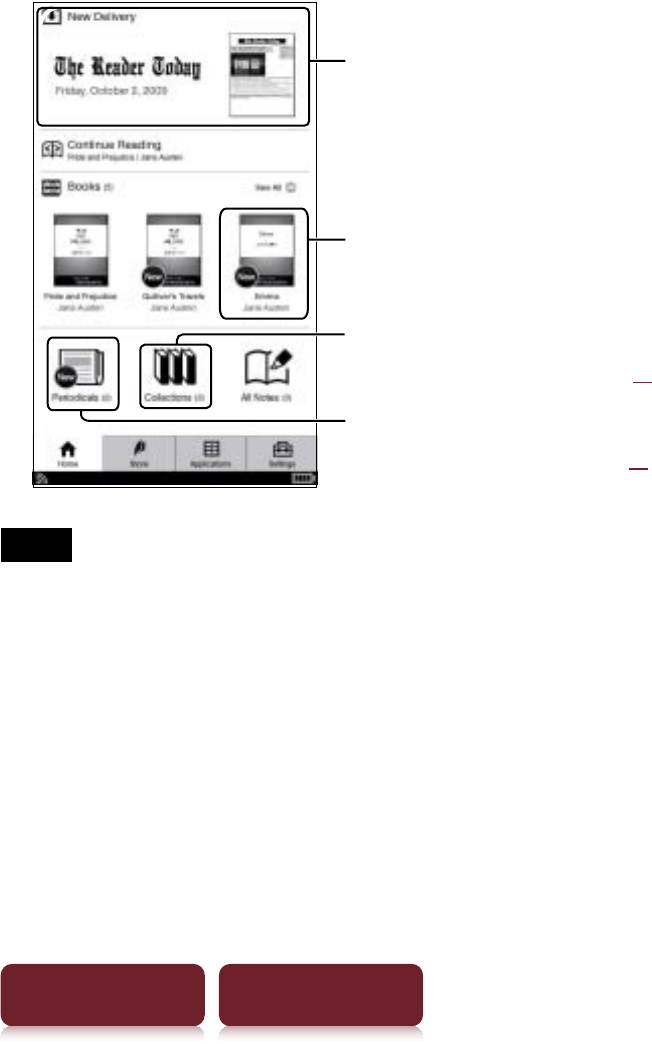
Downloading Content
44
Table of Contents Index
When a new issue is delivered to the Reader, it will be
displayed in the [Home] menu. You can also find the
issue from the [Periodicals] list and [Collections] list.
[Periodicals]:
Opens the [Periodicals] list (rxx)
[New Delivery]:
Most recent delivered issues
Purchased book
[Collections]:
Opens the [Collections] list (rxx)
Notes
ˎ
If you miss any new issues while the wireless feature is off,
download them from the [My Account] page in the Reader
Store, where previous issues are available.
ˎ
While the Reader is connected to your computer via USB,
the wireless network feature (including the auto delivery
feature) is unavailable.
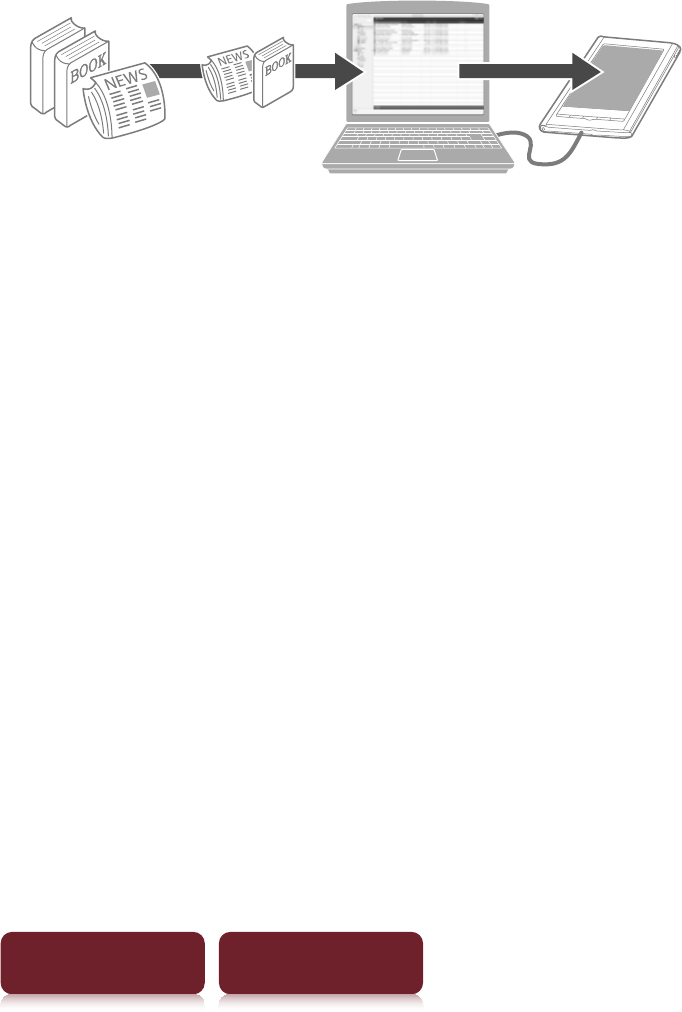
Accessing the Reader Store with your computer
45
Table of Contents Index
Accessing the Reader Store
with your computer
Reader Store
Reader Library software Reader device
Sony Reader Library software (Reader Library) will
allow you to shop and manage eBooks and other
content purchased from the Sony Reader Store (Reader
Store).
Reader Library can also be used to manage eBooks
from other sources such as your local public library or
Google Books. For more details, check the Reader™
Store home page.
To help manage your eBooks, you may need to create
an account. You’ll be asked to do this during the
installation process.

Accessing the Reader Store with your computer
46
Table of Contents Index
Installing Reader Library on to your PC or Mac is easy.
There are 3 simple steps to follow.
Step 1: Installing Reader Library (rxx)
Step 2: Creating an account and purchasing
eBooks (rxx)
Step 3: Transferring your eBooks to your Reader™
(rxx)
Each of these steps is described in more detail in the
next section.
Reader Library has many helpful features. For more
information, refer to the Reader Library [Help] menu.
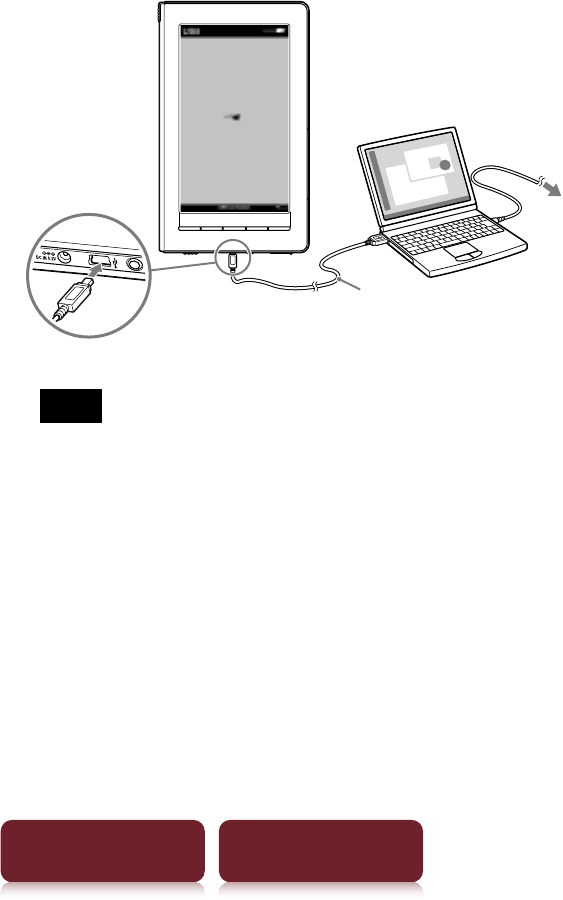
Accessing the Reader Store with your computer
47
Table of Contents Index
Step 1: Installing Reader Library
1Connect your Reader to your computer using
the supplied USB cable.
Ensure that your Reader is turned on and your
computer is switched on, connected to the
Internet, and you have Administrator access.
USB cable (supplied)
To an AC outlet
Note
ˎ
The Reader only charges when the connected
computer is powered on.
ˎ
The wireless feature is unavailable while the Reader is
connected via USB.
ˎ
The Reader cannot be operated when connected to a
computer via USB.
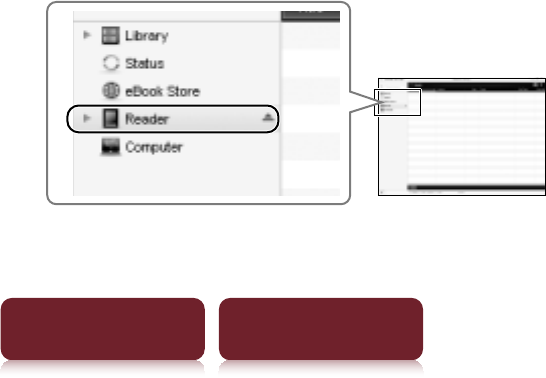
Accessing the Reader Store with your computer
48
Table of Contents Index
2For Windows users, go to the “Start” menu and
click “My Computer” (or “Computer” for
Windows Vista and Windows 7 users). Then
double-click the “SETTING” drive and then
double-click “Setup Reader Library for
Windows”.
To install on Macintosh computers:
When your Reader is connected to your Mac,
“SETTING” and “READER” will appear on the
desktop. Double-click the “SETTING” drive and then
double-click “Setup Reader Library for Mac”.
3Follow the on-screen instructions to complete
the installation of Reader Library.
A shortcut to Reader Library will be added to your
computer desktop (Windows only). Reader Library
may start automatically depending on which
option you choose just before finishing the
installation. If Reader Library does not start
automatically, double-click the shortcut to start
Reader Library.
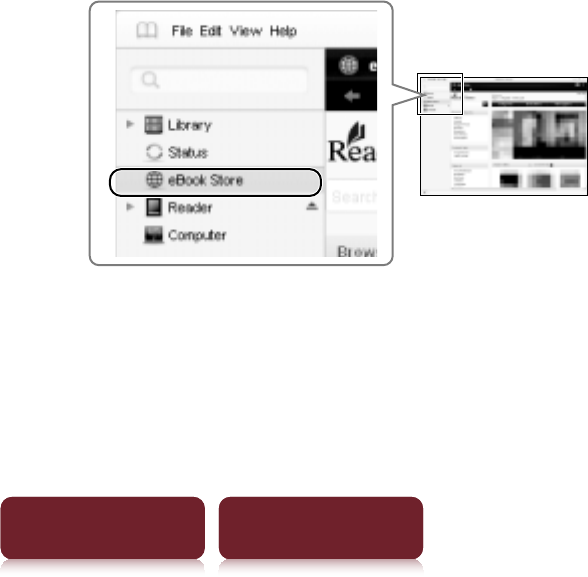
Accessing the Reader Store with your computer
4949
Table of Contents IndexTable of Contents Index
You can navigate around the different sections of
Reader Library using the navigation menu on the
left-hand side. When your Reader is connected to
your computer, you will see [Reader] appear in the
list.
To learn how to create an account and purchase
eBooks, please read the following section.
Step 2: Creating an Account and
Purchasing eBooks
1Visit Reader Store and create an account.
ͦClick [eBook Store] in the left-hand menu
within Reader Library.
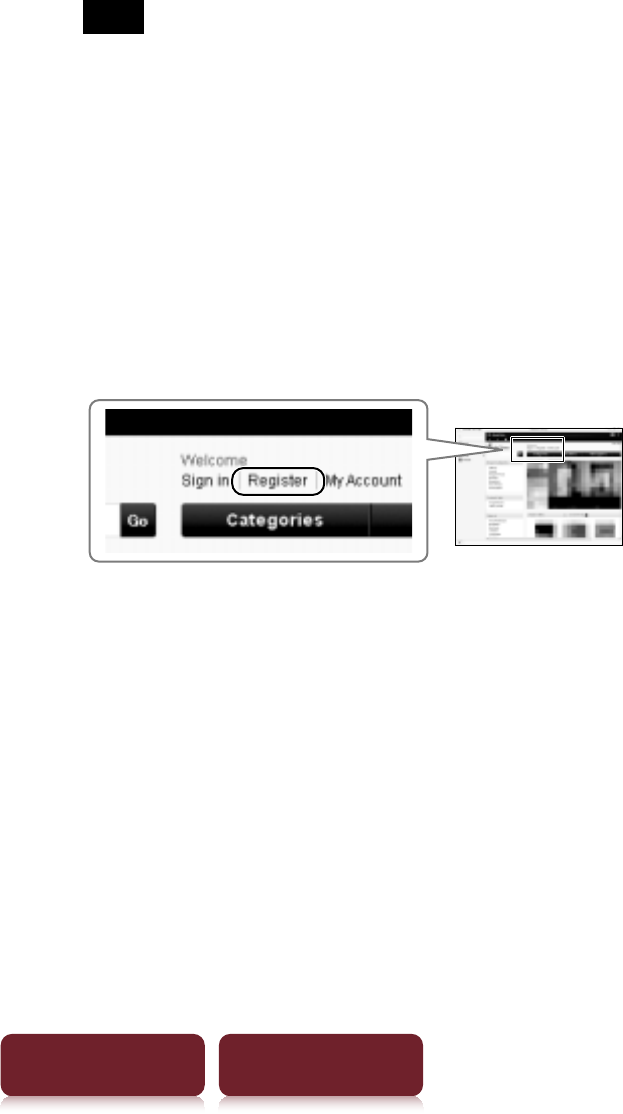
Accessing the Reader Store with your computer
50
Table of Contents Index
ʔCreate an account on the Reader Store.
Note
If you have already created an Adobe Account, use
your Adobe ID (this is usually your email address) and
password when creating your Reader Store account.
Click the [Register] link. Follow the on-screen
instructions to create your Reader Store account
(note that the same account details will also be
automatically used to create an Adobe Account,
which you will need to access eBooks with
DRM).
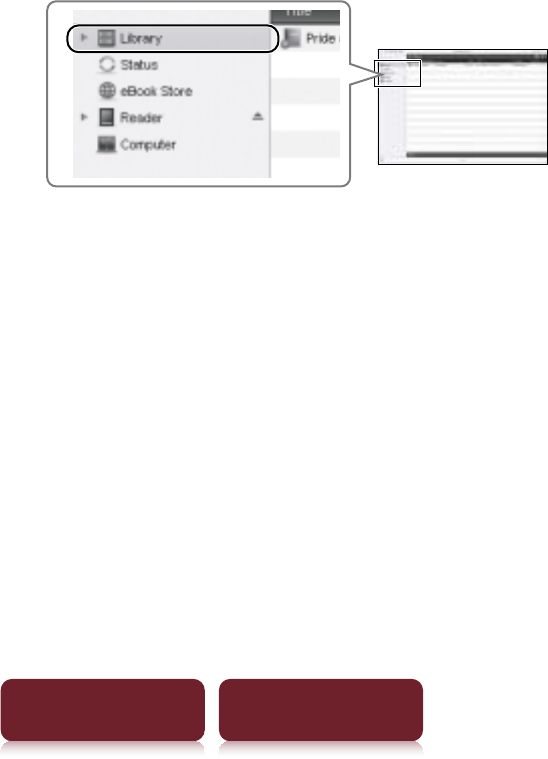
Accessing the Reader Store with your computer
51
Table of Contents Index
2Purchase and download eBooks.
Once you set up your account, you can purchase
eBooks, subscribe to periodicals and search over 1
million titles from Google Books.
You can also borrow eBooks from your local public
libraries. For details, refer to the home page of
Reader Store.
All purchased eBooks, subscribed periodicals and
free downloads can be found in the [Library]
section in the left-hand menu within Reader
Library.
Step 3: Transferring your eBooks to
your Reader
1Click [Library] in the left-hand menu within
Reader Library.
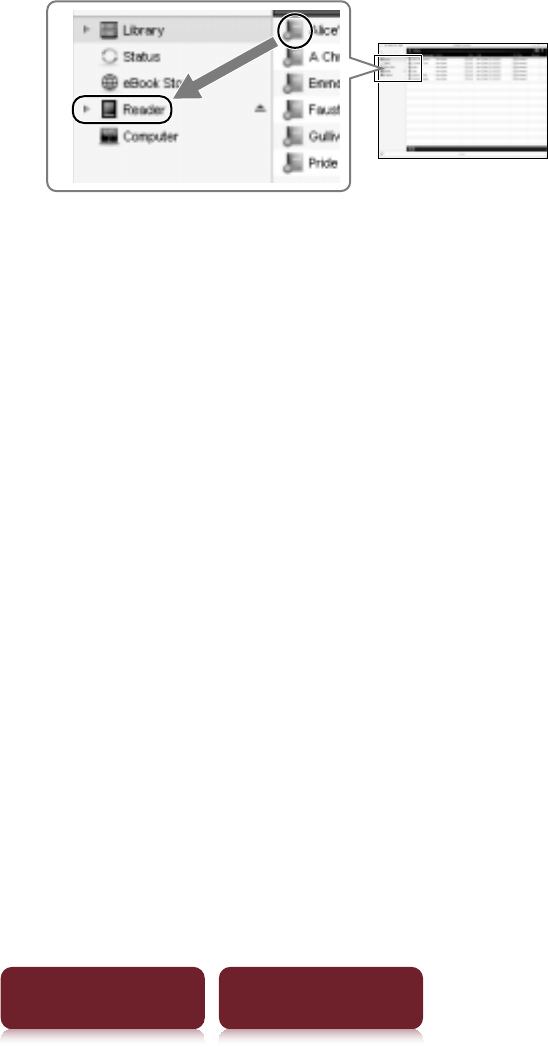
Accessing the Reader Store with your computer
52
Table of Contents Index
2Click on the eBook that you wish to transfer
and drag-and-drop it to [Reader] in the left-
hand menu.
3After a few moments, your eBook will be
transferred.
If the Reader Library does not function as expected,
refer to “Troubleshooting” in the Reader Library
[Help] menu.
4Close Reader Library and disconnect your
Reader from the computer.
Once Reader Library has closed, the on-screen
message on your Reader device will change from
[Do not disconnect] to [USB connected].
Once you see [USB connected], it is safe to
disconnect your Reader from your computer.
For more details about your Reader, refer to the
User Guide found on your Reader.

53
Table of Contents Index
Chapter 3
Reading Content.............................................42
Browsing Internet Content ............................72
Collections.......................................................76
Managing Content......................................... XX
Applications....................................................82
Settings ...........................................................98
Troubleshooting .......................................... 105
Appendix...................................................... 113
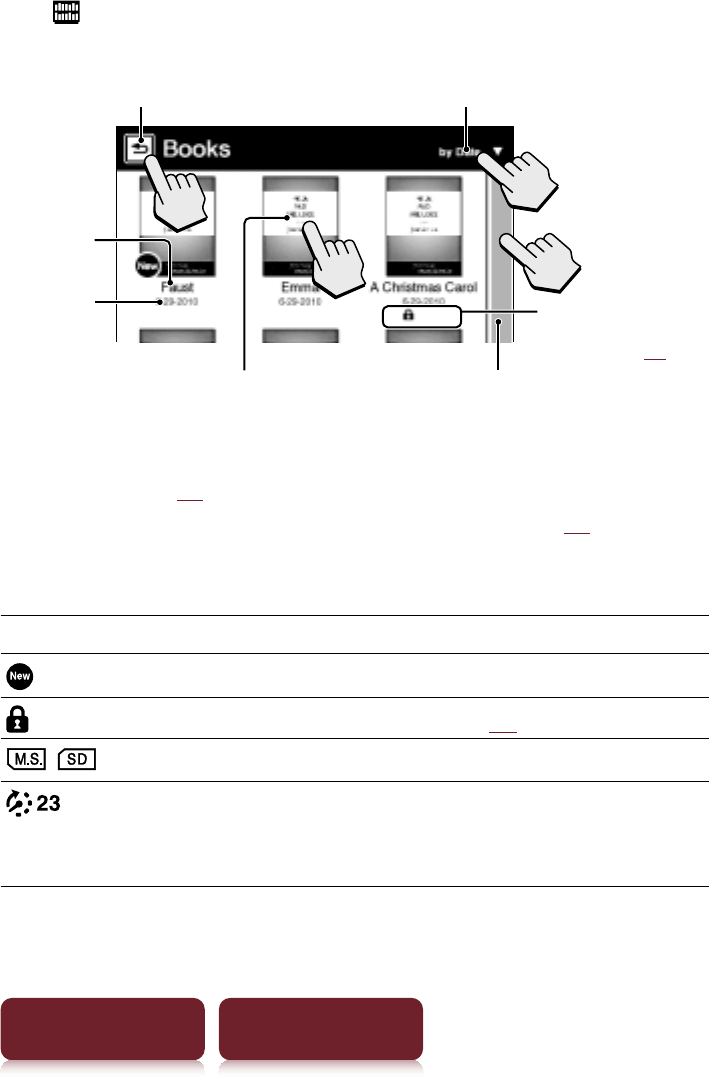
Reading Content
54
Table of Contents Index
Reading Books
Tap [Books] at [Home] menu to view a book list. Tap
a desired book to open.
Tap to open a book
Tap to previous page Tap to change sorting order
Scroll bar
Title
Date of
transfer
to Reader
Conditional icon
display (r37)
Tips
ˎ
Please see rxx regarding OPTIONS menu.
ˎ
To transfer eBooks to the Reader, please see rxx.
Conditional icon
Icon Condition
Newly transferred or unread content.
Protected content (r75).
/Content on a memory card.
Days to the expiration date.
[Expired] is displayed when a book has
expired.

OPTIONS Menu
55
Table of Contents Index
Operation at page view
: An added
note.
Tap to view the
added note.
: Handwritten
memo. Tap to
show its
thumbnail. Tap
the thumbnail to
display in full size.
Swipe the screen to turn page Double-tap
to bookmark
Double-tap to open
dictionary/search/
add highlight
Tap to jump to
another page
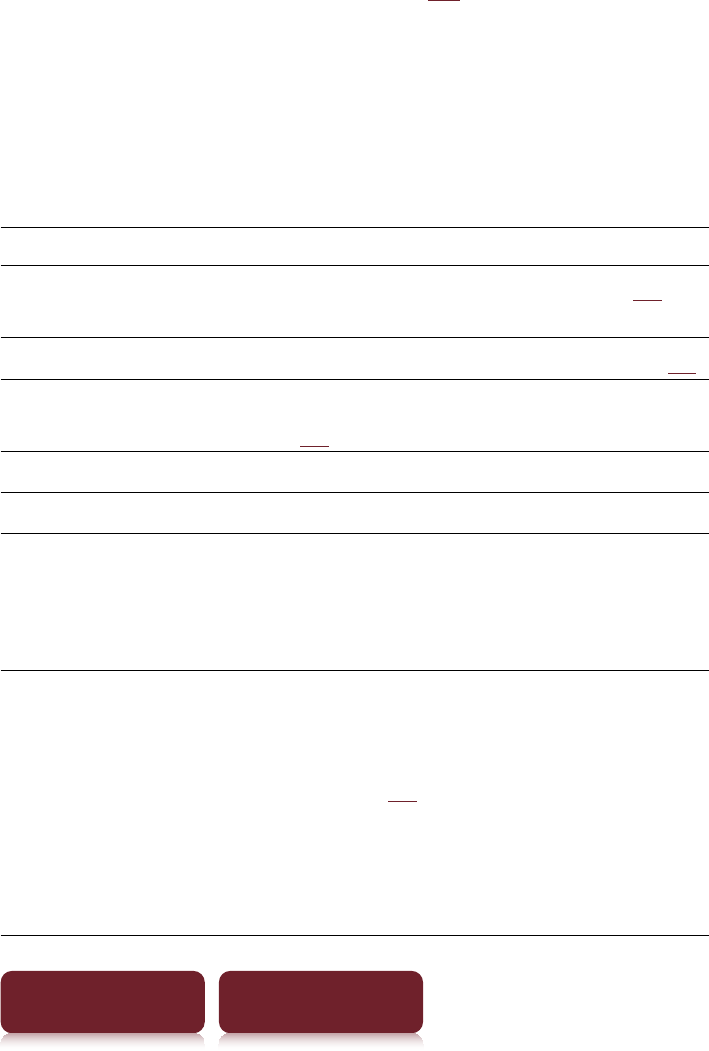
OPTIONS Menu
56
Table of Contents Index
OPTIONS Menu
Pressing the OPTIONS button (r10) will display the
menu for related supplementary functions.
Items in the OPTIONS menu
The following items are listed in alphabetical order.
When displaying the OPTIONS menu, not all items
listed below will be shown in any given circumstance.
Item Description/Reference page
[Add Content],
[Add to Collection]
Adds content to a collection (r70).
[Add Bookmark] Creates a bookmark on the page (r39).
[Adjust View] Adjusts how content is displayed
(r52).
[Change Dictionary] Shows a list of dictionaries to select.
[Continue Reading] Shows the last read page of the content.
[Delete Book],
[Delete Drawing],
[Delete Issue],
[Delete Memo]
Deletes the currently-viewed book,
drawing, issue or text memo from the
Reader.
[Delete Audio],
[Delete Books],
[Delete Collections],
[Delete Drawings],
[Delete Issues],
[Delete Memos],
[Delete Notes],
[Delete Pictures]
Selects and deletes audio, books,
collections, drawings, issues, text
memos, notes or pictures from the
Reader (r74).
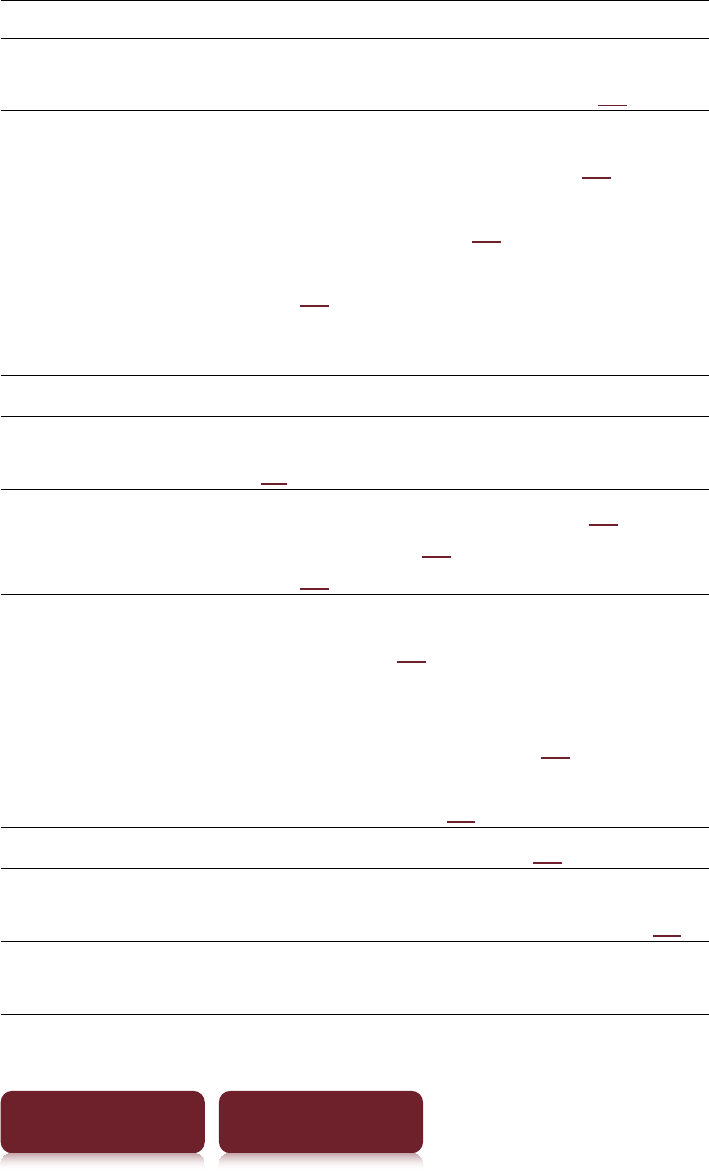
OPTIONS Menu
57
Table of Contents Index
Item Description/Reference page
[Delete Word Logs] Selects and deletes previous
dictionary word searches (r64).
[Go to] [Previous View]: Jumps to the
previously viewed page (r59).
[History]: Navigates previously-
viewed pages. (r59)
[Select Page]: Jumps to another page
(r58).
[Table of Contents]: Displays the
table of contents.
[Info] Displays the content information.
[Manage
Subscription]
Sets to delete issues automatically (r
xx).
[New Collection],
[New Drawing],
[New Memo]
Creates a new collection (r68),
a drawing (r77) or a text memo
(r80).
[Notes] [List]: Displays the [Notes] list in the
content (r44).
[Create/Edit ]: Shows tools to
bookmark, highlight, handwrite and
remove annotations (r41).
[Hide]/[Show]: Toggle displaying
annotations (r59).
[Now Playing] Shows audio player (r86).
[Orientation] Toggles the screen orientation either
in portrait or landscape mode (r54).
[Previous View] Returns to the previously viewed
page.
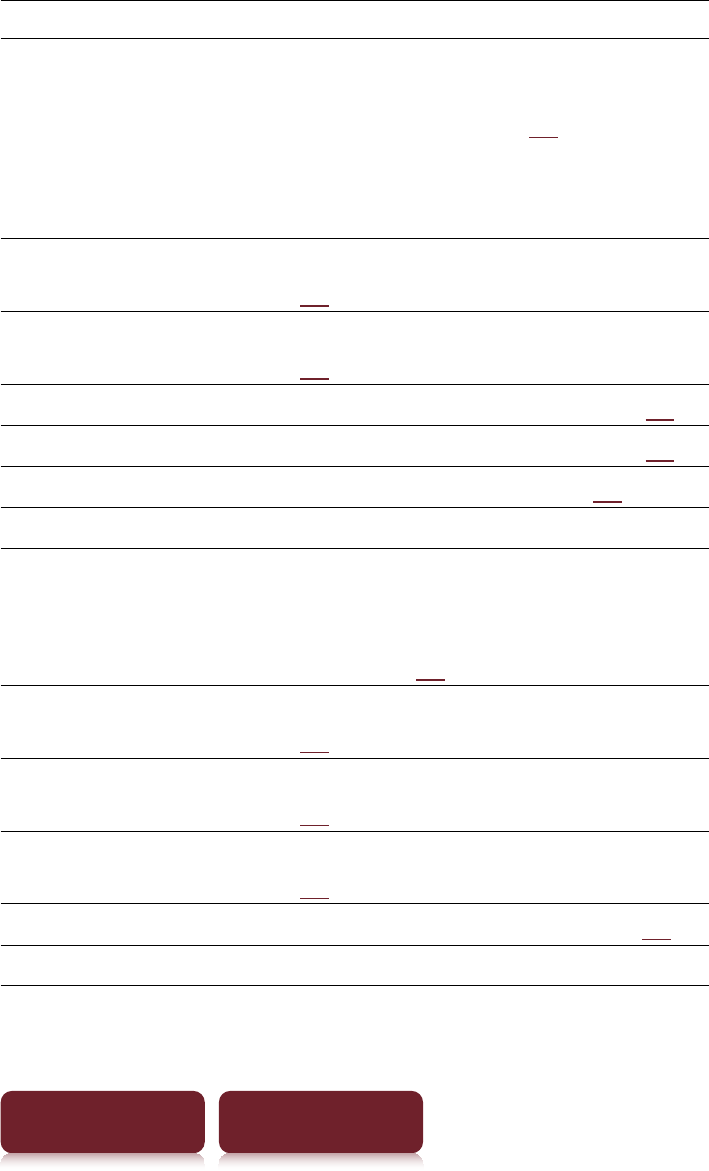
OPTIONS Menu
58
Table of Contents Index
Item Description/Reference page
[Protect Audio],
[Protect Books],
[Protect Drawings],
[Protect Issues],
[Protect Memos],
[Protect Pictures]
Protects audio, books, drawings,
issues, text memos or pictures from
accidental deletion (r75).
[Remove Bookmark] Deletes the bookmark on the page
(r39).
[Remove Content] Removes content from a collection
(r73).
[Rename Collection] Changes the collection name (r69).
[Repeat] Sets repeat play of audio files (r87).
[Resume Playing] Resumes audio playback (r87).
[Return to List] Shows content list.
[Search] Searches for either content title or
words in the contents with the
keyword inputted by on-screen
keyboard (r56).
[Select Standby Screen]
Selects pictures for the standby screen
(r84).
[Shuffle On]/
[Shuffle Off ]
Plays all audio files in a random order
(r87).
[Slideshow On]/
[Slideshow Off]
Starts/Stops a slideshow of pictures
(r83).
[Sort:] Changes sort order of the list (r36).
[View] Changes the appearance of the list.
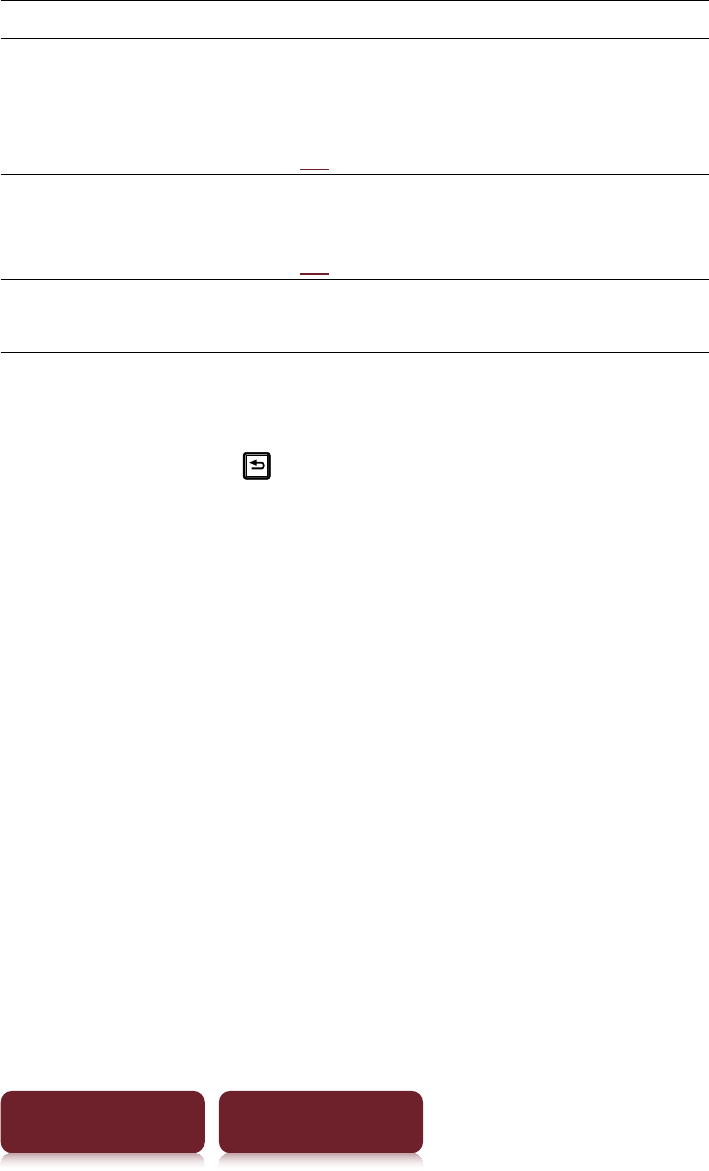
OPTIONS Menu
59
Table of Contents Index
Item Description/Reference page
[Word Logs: Book]
[Word Logs: Periodical]
Within either a book or a periodical,
shows a list of the last 100 words
previously searched in the dictionary
(r63).
[Word Logs: Dictionary]
Within a dictionary, shows a list of the
last 100 words previously searched
(r61).
Ă/èDisplays the previous/next OPTIONS
menu.
Tip
Pressing and holding the OPTIONS button for 2 seconds is
the same as tapping or pressing OPTIONS p tapping
[Return to List].

Annotation
60
Table of Contents Index
Annotation
Bookmarking
Creating:
– Double-tap the upper right corner of page. When
the pages are displayed in [Two Page View] mode,
the bookmark can be created by double-tapping the
left corner of the left page. (rxx).
– From the OPTIONS menu: [Add Bookmark] (r31)
– From the OPTIONS menu: [Notes] p [Create/Edit]
(r41)
Deleting: Double-tap a bookmark.
Adding a note in a bookmark: See r42.
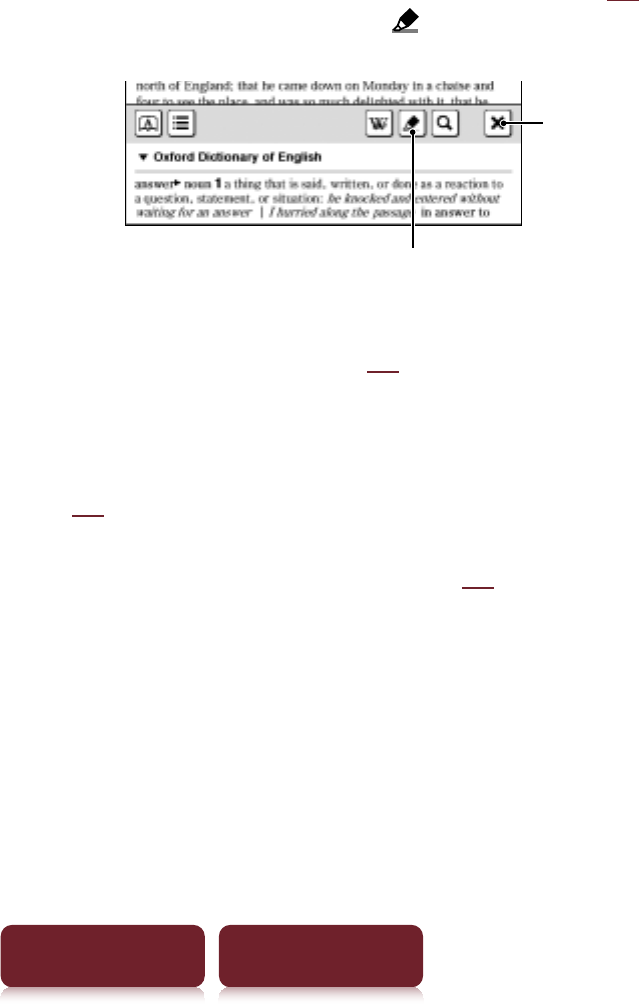
Annotation
61
Table of Contents Index
Highlighting word(s)
Highlighting at page view:
– A word: Double-tap a word.
– Consecutive words: Double-tap and drag (r25).
– At pop-up tool window, tap marker to highlight.
Marker
Quit
– Highlighting can be done in the OPTIONS menu:
[Notes] p [Create/Edit] (r41).
Deleting:
– From the OPTIONS menu: [Notes] p [Create/Edit]
(r41).
Adding a note in a highlight: See r42.
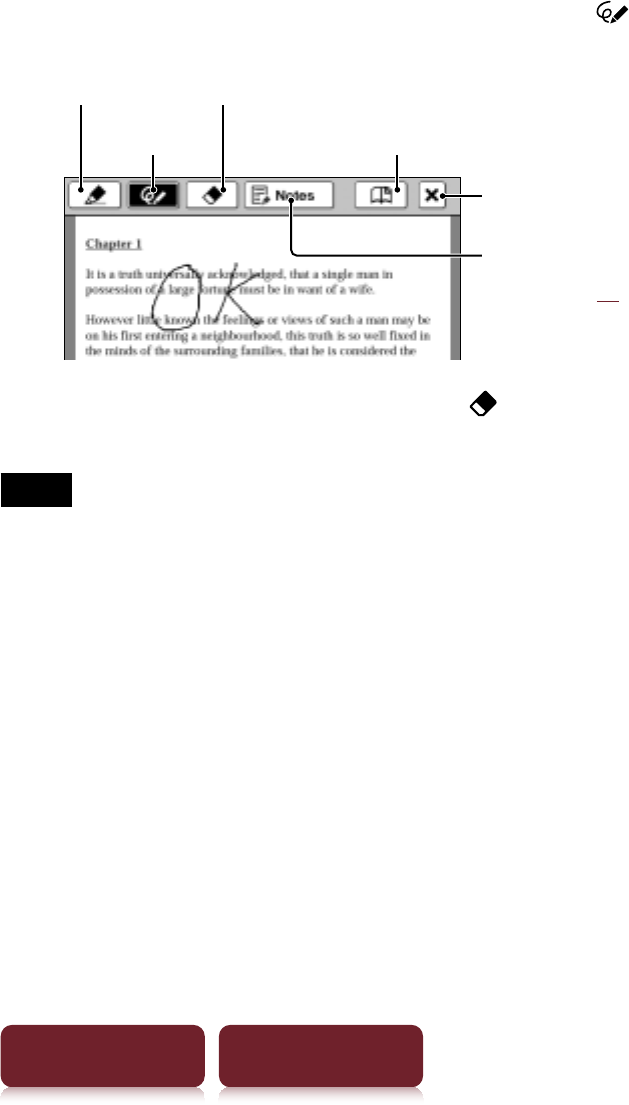
Annotation
62
Table of Contents Index
Handwriting a note
Press OPTIONS p tap [Notes] p [Create/Edit] pp use
a stylus or finger to draw a line.
Pen
Lists notes in the
content (r44)
Marker Eraser
Bookmark
Auto save and quit
Deleting a drawn line/highlight: Tap and stroke
across the drawn line or highlight.
Notes
ˎ
While writing, make sure that you are not touching another
area on the screen – this could affect the notes that you
write with the stylus or your finger.
ˎ
To ensure your notes are correctly saved, do not handwrite
notes too close to the edge of the screen.
ˎ
If you experience difficulties when handwriting or drawing
on your Reader:
– avoid applying excessive pressure to the screen.
– try not to handwrite or draw too quickly.
– the notes functionality is not designed for very detailed
drawings or for writing small characters.
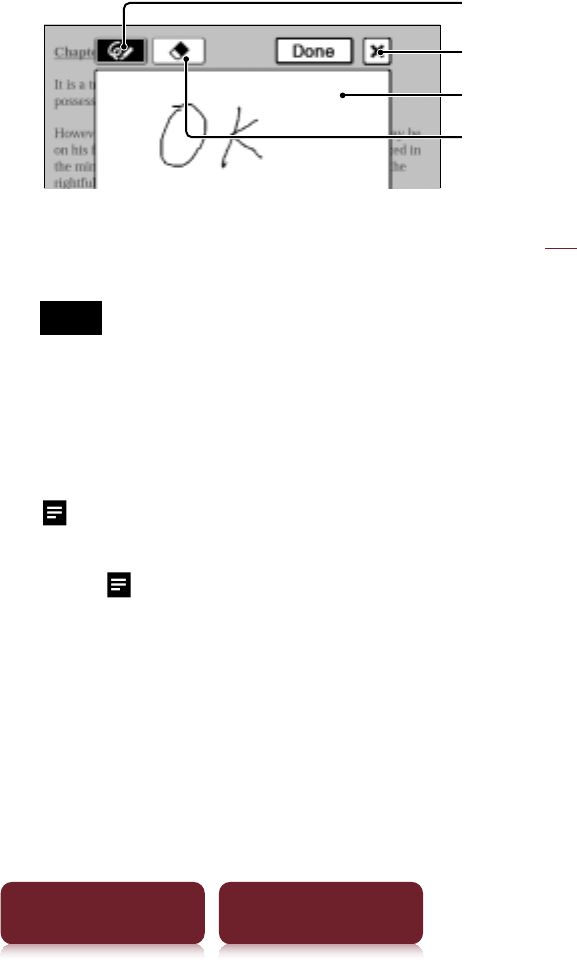
Annotation
63
Table of Contents Index
Adding a note
1Tap a bookmark or highlighted word p [by
Drawing] or [by Keyboard].
To enter a handwritten note, tap [by Drawing].
Pen
Eraser
Quit
Drawing area
To enter a memo with typed in text (r26), tap [by
Keyboard].
Note
When adding a note to the highlighted text in [Create/
Edit], unselect any annotation tool icon and then tap the
highlight.
2Enter a note p tap [Done].
will be attached to the bookmark or highlight. To
view the added note, tap a bookmark or highlight
with .

Finding a Note
64
Table of Contents Index
Notes
ˎ
While writing, make sure that you are not touching another
area on the screen – this could affect the notes that you
write with the stylus or your finger.
ˎ
To ensure your notes are correctly saved, do not handwrite
notes too close to the edge of the screen.
ˎ
If you experience difficulties when handwriting or drawing
on your Reader:
– avoid applying excessive pressure to the screen.
– try not to handwrite or draw too quickly.
– the notes functionality is not designed for very detailed
drawings or for writing small characters.
To edit a note
Tap a bookmark or highlight with p [Edit] p edit a
note p tap [Done].
To delete a note
Tap a bookmark or highlight with p [Delete] p [Yes].
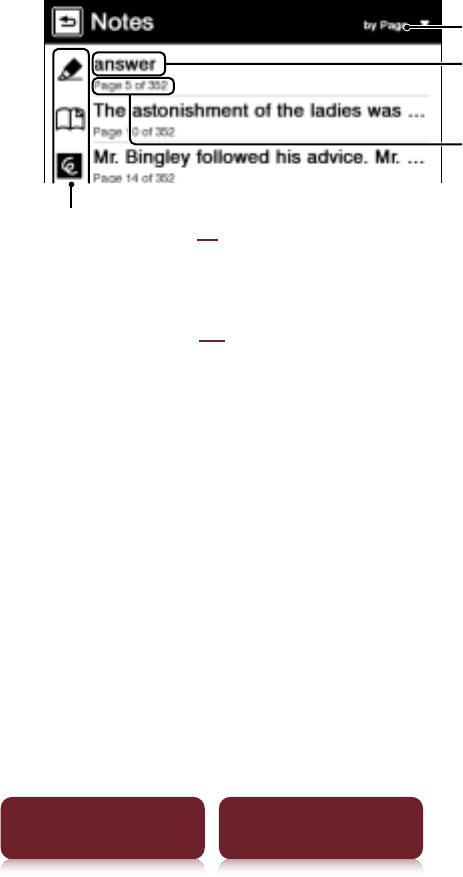
Finding a Note
65
Table of Contents Index
Finding a Note
Searching for notes within a book
1Press OPTIONS p tap [Notes] p [List].
A list of all the bookmarks, highlights, and
handwritten memos in the current book appears.
Headline
Annotated page number
Types of note (r45)
Tap to change sort type
Tip
Please see rxx regarding OPTIONS menu.
2Tap a note.
The page containing the selected note is displayed.
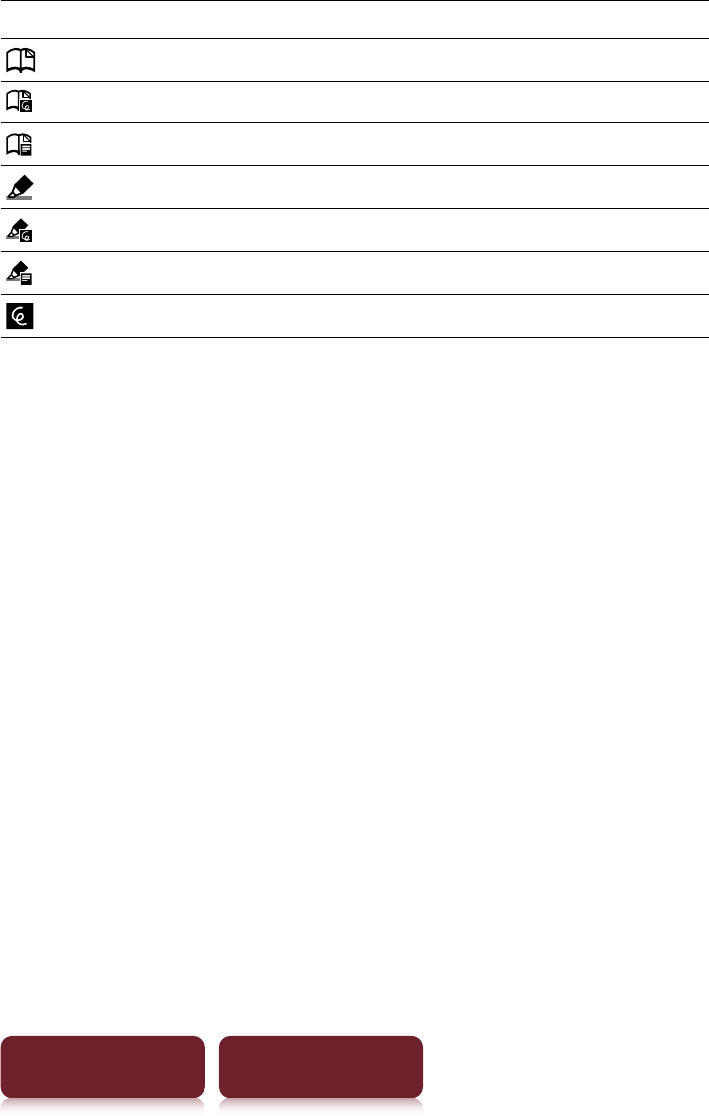
Finding a Note
66
Table of Contents Index
Icons and types of note in the [Notes] list
Icon Types of note
Bookmark
Bookmark with a handwritten note
Bookmark with a text note
Highlight
Highlight with a handwritten note
Highlight with a text note
Handwritten memo
Tip
You can set to merge the notes of the Reader and Reader
Library when synchronizing. For further instructions, refer to
Reader Library Help.
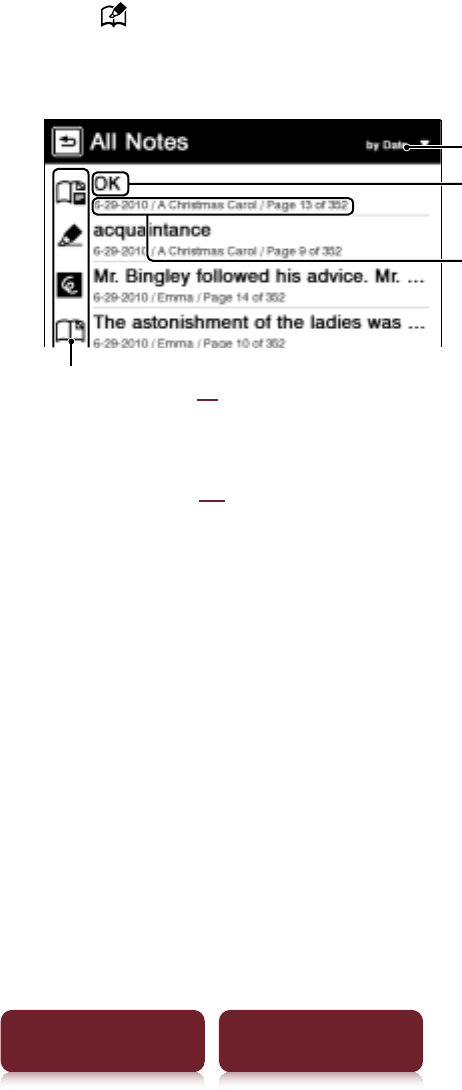
Finding a Note
67
Table of Contents Index
Finding the notes in all contents
1Tap [All Notes] at [Home] menu.
A list of all the bookmarks, highlights, and
handwritten memos in all contents appears.
Headline
Annotated date/Book or
Periodical title/Issue date/
Annotated page number
Types of note (r45)
Tap to change sort type
Tip
Please see rxx regarding OPTIONS menu.
2Tap a note on the list.
The page containing the selected note is displayed.
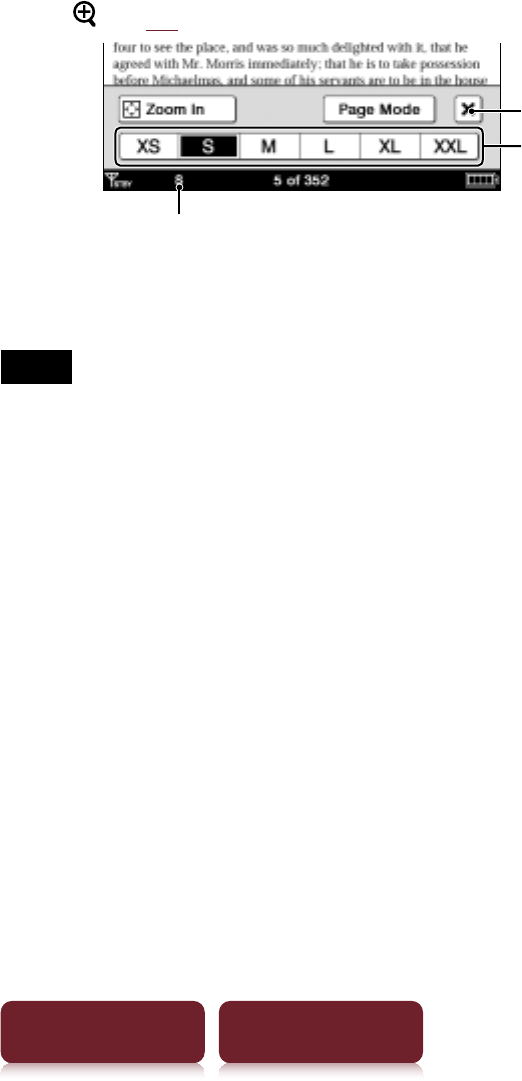
Resizing
68
Table of Contents Index
Resizing
Press (r10) for re-sizing.
Size indicator
Quit
Text sizes
Adjusting the text size: Select one of text size icons and
close.
Notes
When you view PDF files in a size other than [S], the
following may occur.
ˎ
[S] size is the default font size. If another size is selected,
text size may not change correctly.
ˎ
Functions such as highlighting, searching, or temporary
word selection may not work correctly.
ˎ
The table and graphics may not be correctly displayed.
ˎ
A page containing only images cannot be resized.
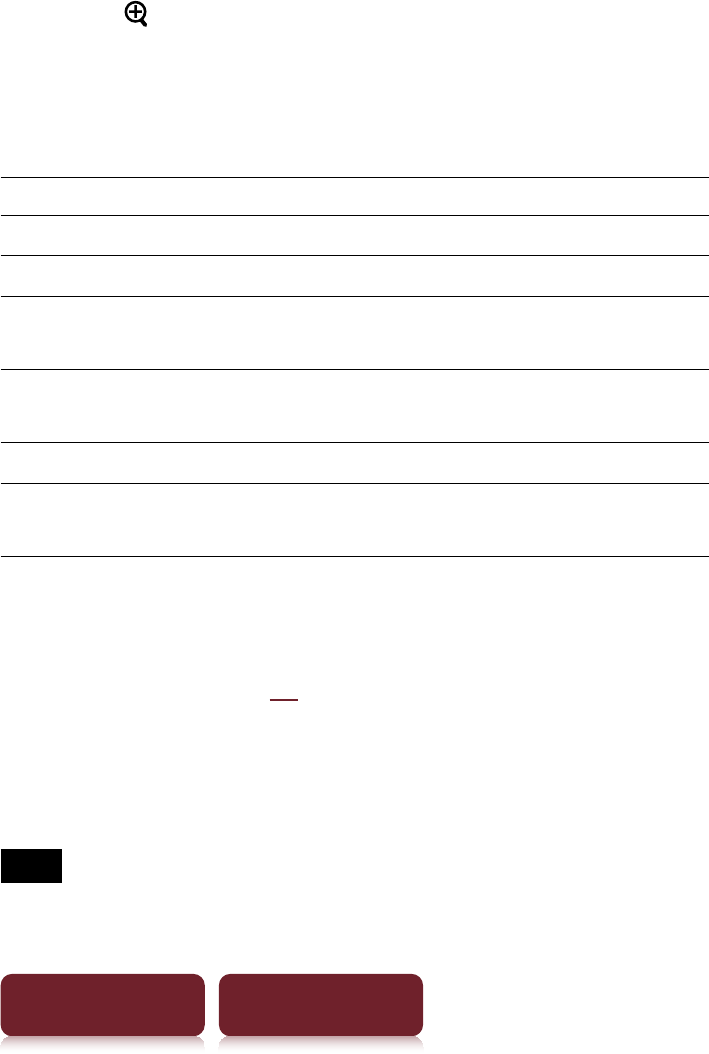
Resizing
69
Table of Contents Index
Changing a page mode
A page can be magnified by selecting the page mode.
1Press p tap [Page Mode].
2Tap a desired item from the following.
[Page Mode] menu
[Page Mode] item Description
[Original] Displays the original page layout.
[Margin Cut]1Removes the margins.
[2-Column Split] Displays the page in numerical order
by dividing the page into four.
[3-Column Split] Displays the page in numerical order
by dividing the page into six.
[Full Page]2Expands the page to a full page.
[Two Page View]3The pages are displayed horizontally,
side by side.
1Depending on the content, you may not be able to enlarge
a page.
2[Full page] mode is only effective when the screen is in
landscape display (r54).
3[Two Page View] is available only in the landscape
(horizontal) mode. When selecting [Two Page View] in the
portrait (vertical) mode, the screen orientation is switched
to the landscape (horizontal) mode automatically.
Note
In order to attach a handwritten memo, the page mode
needs to be restored to [Original].
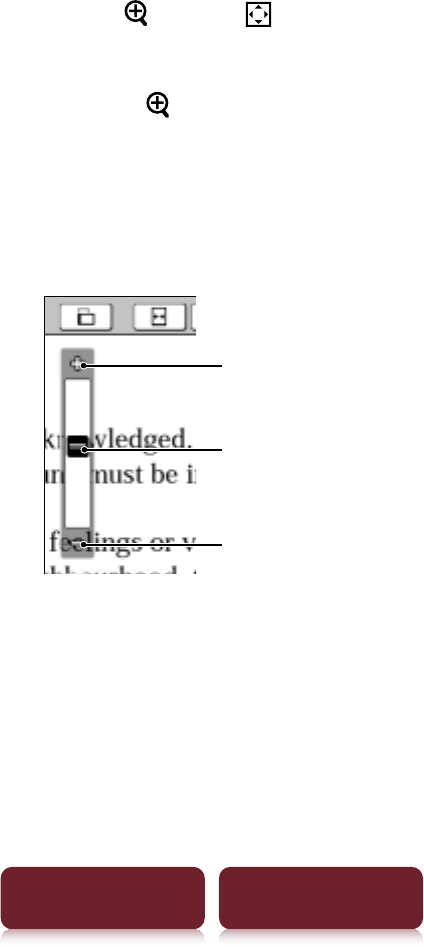
Resizing
70
Table of Contents Index
Zooming in
The current page in view can be magnified. Also, the
magnification can be locked so that the desired setting
can be maintained. This feature is useful when reading
a book containing scanned images.
1Press p tap [ Zoom In].
Tip
Pressing and > simultaneously at the page view screen
instantly magnifies the page by 10%.
2Drag the zoom slider, or tap + or – of the zoom
bar repeatedly until the page is zoomed to the
desired scale.
Zoom in
Zoom slider
Zoom out to the original size
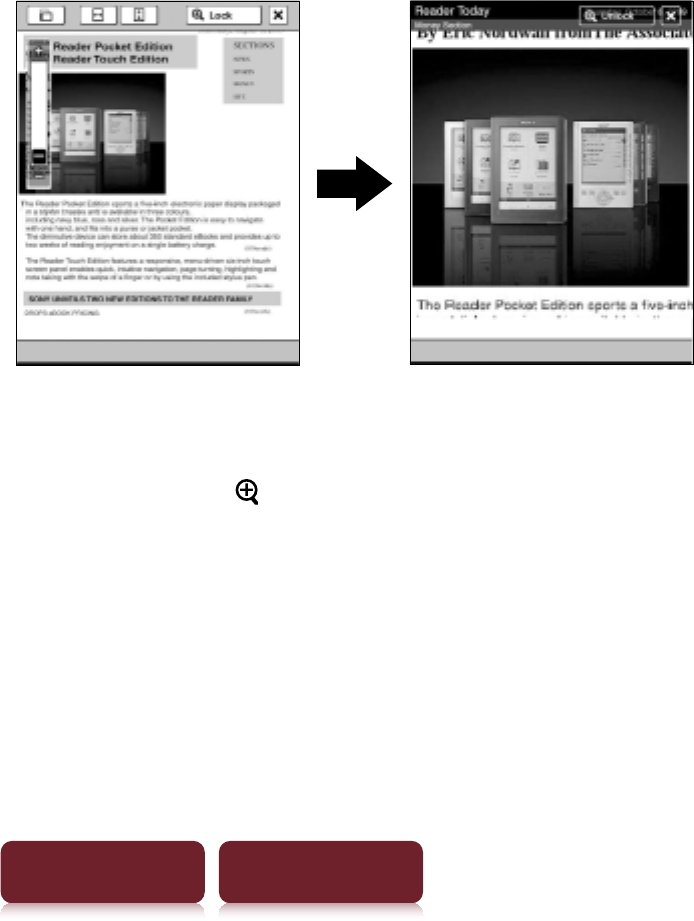
Resizing
71
Table of Contents Index
Zooming a specified image or column to the
screen size
While in zoom-in mode, double-tap an image or
column which you wish to magnify.
The image or column size is magnified automatically to
fit the screen size, and the magnification is locked.
Tip
When in zoom-in mode, you may move to the next/previous
page at zoom lock ([ Lock]) mode.
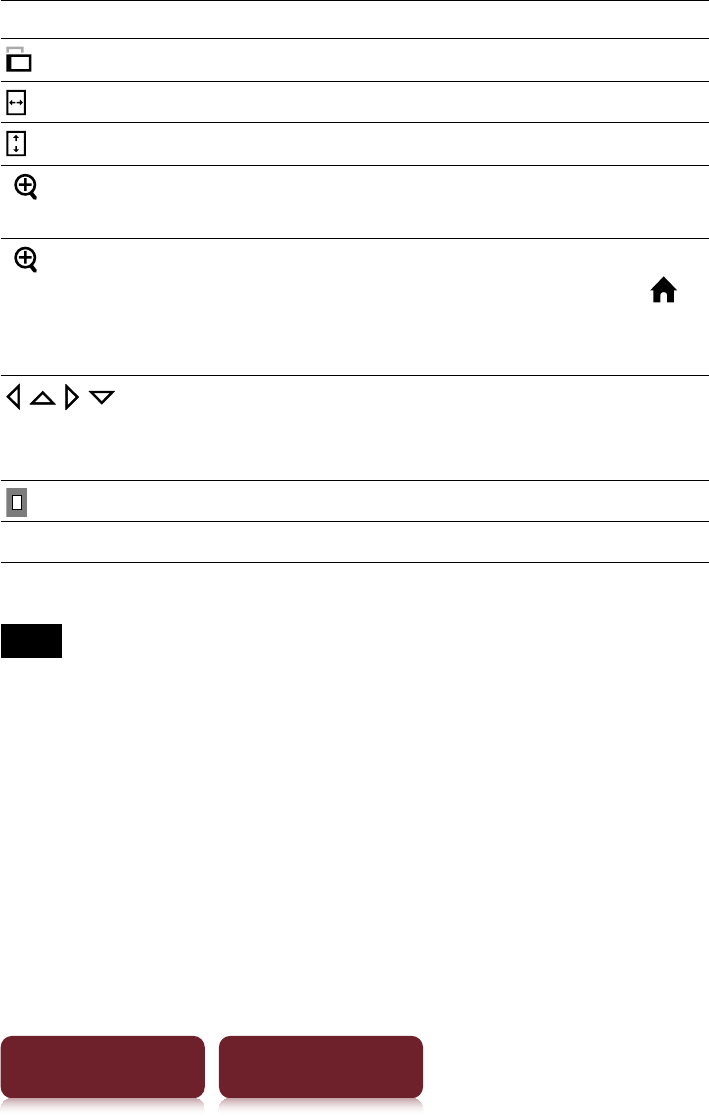
Resizing
72
Table of Contents Index
Using the zoom-in mode
Tap To
Switch the screen orientation.
Fit the page width to the screen width.
Fit the page height to the screen height.
[ Lock] Lock the zoom ratio and the magnified
area. The book can be read as it is.
[ Unlock] Return to the zoom-in mode.
To keep the zoom locked screen, press
to quit. When opening the book next time
the zoom locked screen will be restored.
/ / / * Scroll the page. You can also scroll the page
by dragging or tap on a page where you
want to zoom in.
Check which part on the page is displayed.
ɚReturn to original view.
* Displays when in zoom-in mode.
Note
ˎ
In zoom-in mode, page links are not available.
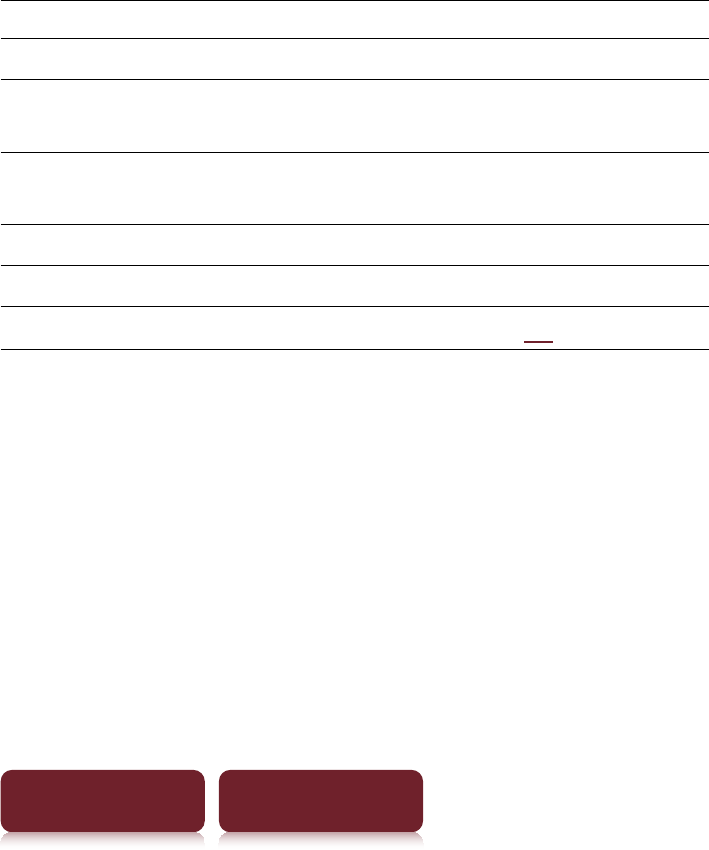
Adjusting Content View
73
Table of Contents Index
Adjusting Content View
A page that is hard to read, such as a scanned or color
converted document, can be made more readable by
adjusting the brightness and contrast.
1Press OPTIONS p tap [Adjust View].
2Tap the desired item from the following.
Item Description
[Original] Displays the page in the original quality.
[Saturated] Improves readability by emphasizing
contrast.
[Details] Backlight compensation; brings up
details in a dark area.
[Brighter] Increases the brightness.
[Darker] Decreases the brightness.
[Custom] Custom setting mode (r53).
3Tap ɚ to apply the setting and exit.
The change will only be stored in the content being
adjusted. Select [Original] when it is necessary to
restore the default setting.
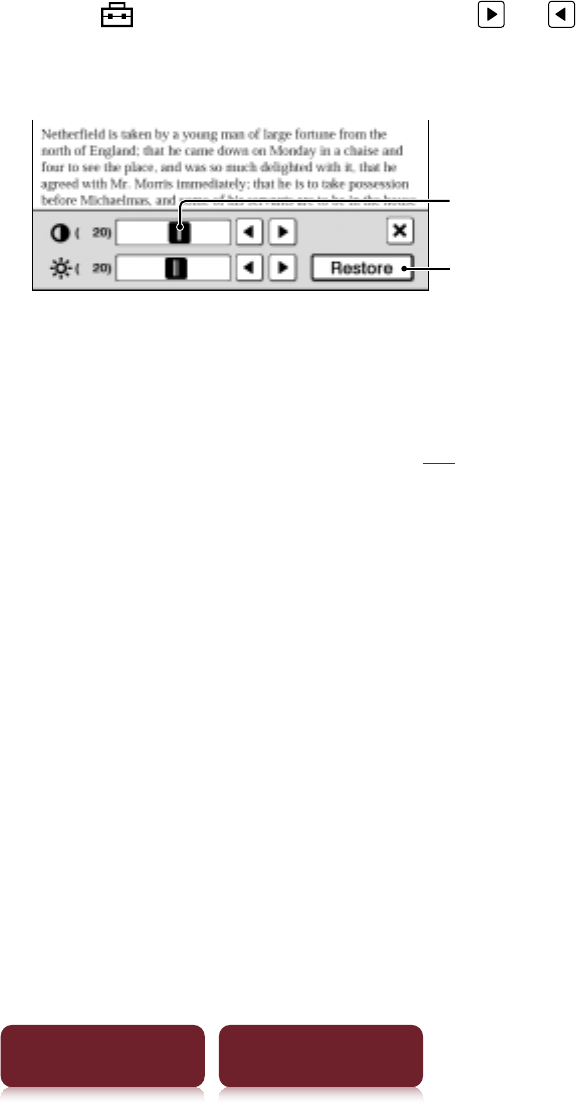
Adjusting Content View
74
Table of Contents Index
Custom setting mode
1Tap p drag the slider, or tap or
repeatedly until the page is adjusted to the
desired brightness and contrast.
Slider
Restores the value of
previous custom settings.
2Tap ɚ to apply the setting and exit.
The change will only be stored in the content being
adjusted. Select [Original] (r52) when it is
necessary to restore the default setting.
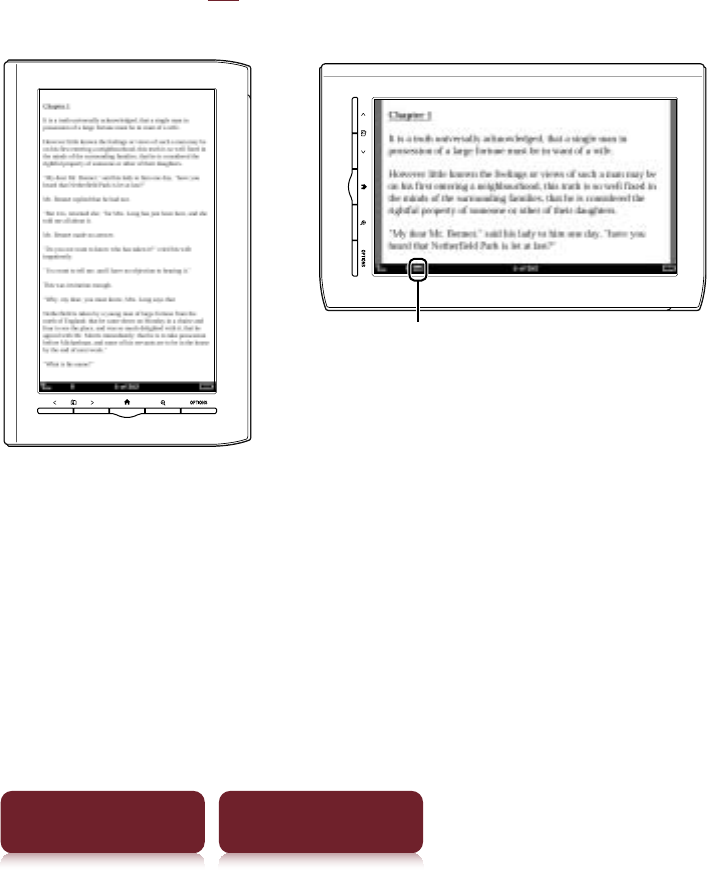
Screen Orientation
75
Table of Contents Index
Screen Orientation
The screen orientation can be switched to either
portrait (vertical) or landscape (horizontal) mode by
selecting [Orientation] in any OPTIONS menu.
To change the direction of screen rotation, see [Screen
Orientation] (r88).
Portrait Landscape
Position indicator
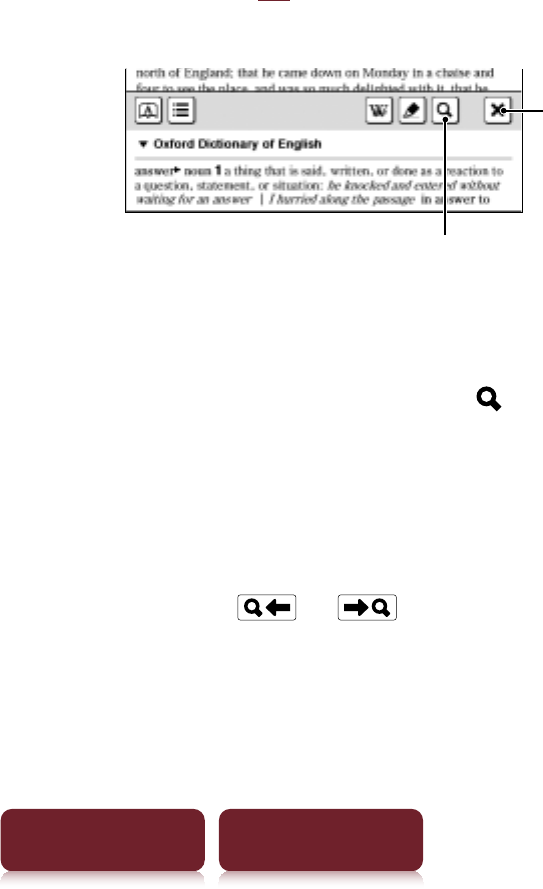
Searching
76
Table of Contents Index
Searching
By selecting a word(s)
ˎ
To select a word, double-tap a desired word at page
view.
ˎ
To select consecutive words, see “Double-tapping
and dragging” (r25).
The following screen will appear.
Search
Quit
ˎ
To cancel, tap ɚ and tap anywhere on the page
view.
ˎ
To search the selected word(s), tap .
The search result screen will appear. The results are
highlighted on the page.
ˎ
To cancel, tap ɚ and quit.
ˎ
To navigate, tap or to move to the
previous/next result.

Searching
77
Table of Contents Index
From the on-screen keyboard
1Press OPTIONS p tap [Search] p input a word
using the on-screen keyboard (r26)p tap
[Search].
The search result screen will appear. The results are
highlighted on the page.
2Tap or to move to the previous/next
result.
To cancel, tap ɚ and quit.
Tip
Before searching, a selected word can be modified.
Double-tap a word p press OPTIONS p tap [Search] p modify
the word in the input area of the on-screen keyboard p tap
[Search].
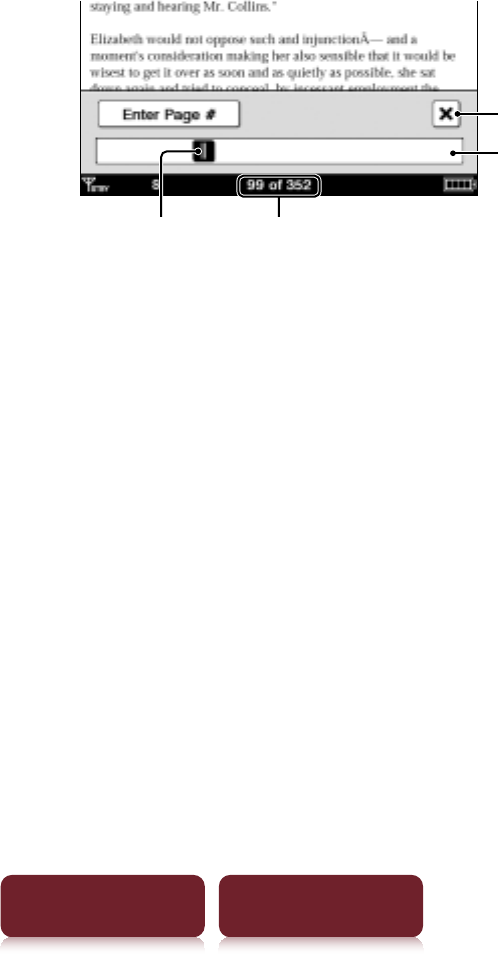
Jumping to a Page
78
Table of Contents Index
Jumping to a Page
By using the slider
Tap the page number shown in the status bar p drag
the slider, or tap a point on the page jump bar.
Slider
Page jump bar
Page number
Quit
Tip
Jumping to a page can be done from the OPTIONS menu.
Press OPTIONS p tap [Go to] p [Select Page].
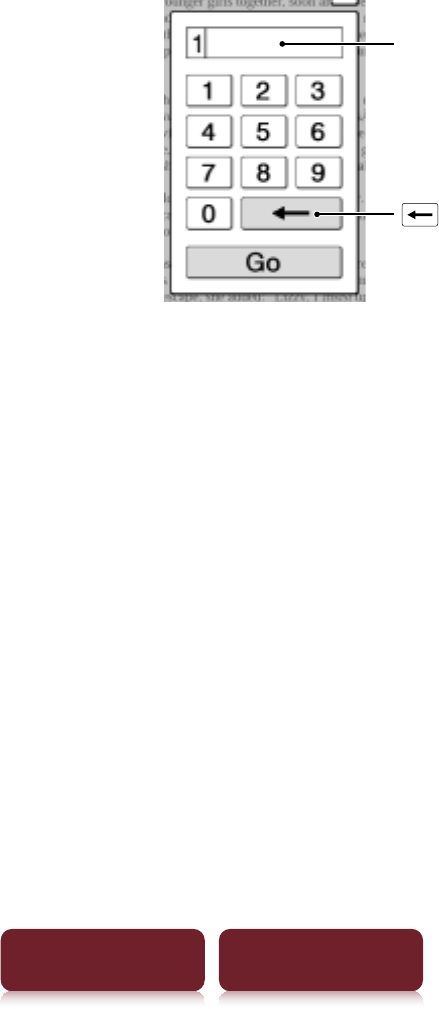
Jumping to a Page
79
Table of Contents Index
By page number
Tap the page number shown in the status bar p [Enter
Page #] p tap the number keys to input a page number
p [Go]. You will jump to the specified page.
Input area
(Delete) key
If the input page number exceeds the number of
pages in the book, the Reader will show the last page.
If 0 is input, the first page will be displayed.

Jumping to a Page
80
Table of Contents Index
By tapping a link
The link appears highlighted on the screen. Tap the
link to jump to the linked page.
Note
If a hyperlink is covered with highlighting, press OPTIONS p
tap [Notes] p [Hide] to hide highlighting.
Returning to the previously displayed page
Press OPTIONS p tap [Go to] p [Previous View].
Jump to viewed pages
Press OPTIONS p tap [Go to] p [History] p
(previous view) or (next view) pɚ.
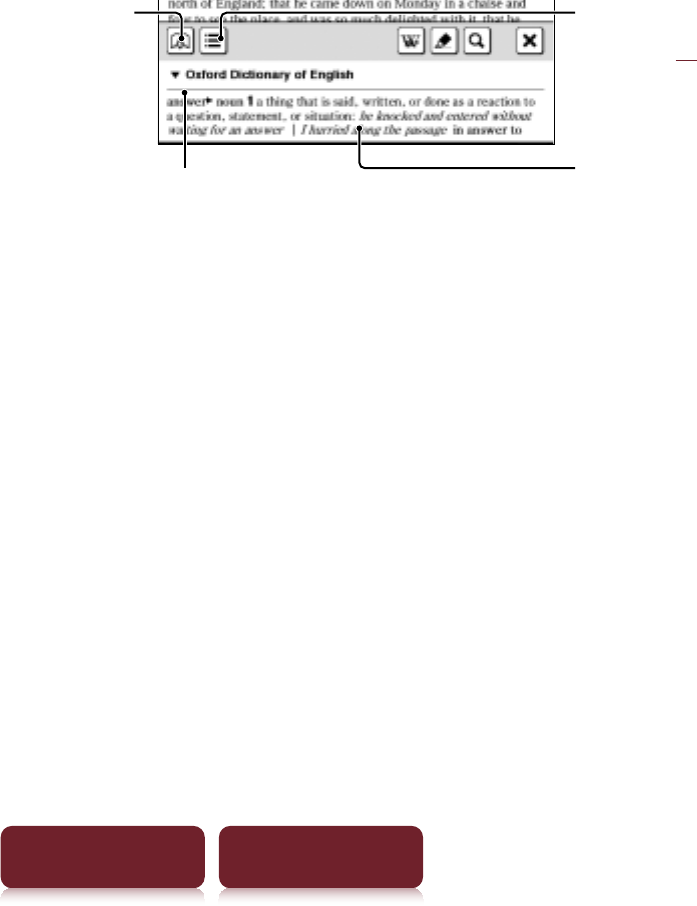
Using Embedded Dictionaries
81
Table of Contents Index
Using Embedded Dictionaries
An instant search for a meaning or translation is
possible with the embedded dictionaries.
1Double-tap a word.
The headline of the word definition is displayed.
Candidates
words (r62)
Definition area
Dictionary
Title of
current
dictionary
Tips
ˎ
Tap è to switch and search in another dictionary.
ˎ
Reader comes with 5 embedded dictionaries.
– 2 English dictionaries
– 3 Translation dictionaries
An English word can be translated to French, German,
Spanish, Italian or Dutch, or vice versa.
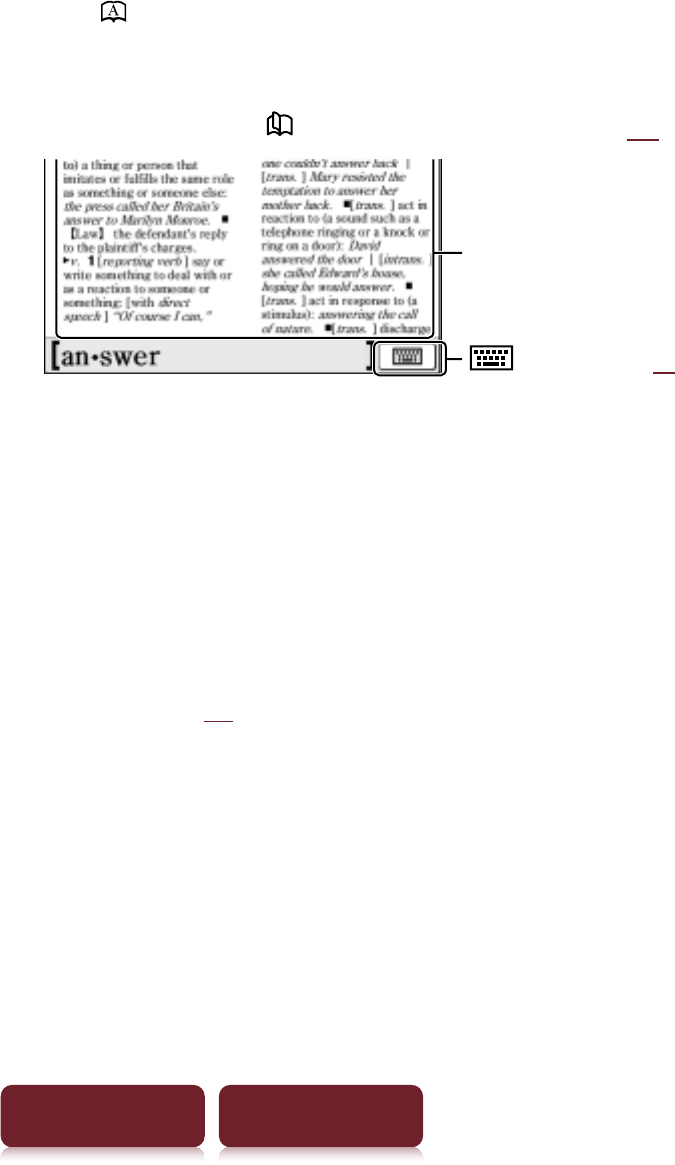
Using Embedded Dictionaries
82
Table of Contents Index
2Tap or the definition area.
The definition is displayed in-full in the dictionary
viewer. To go to the next page, either swipe the
screen or press < > (Page Turn) buttons (r10).
Definition area
(Keyboard) (r62)
Tips
ˎ
Double-tapping a word in the definition area will look up
the selected word in the same dictionary. To return to the
previously viewed definition page, press OPTIONS p tap
[Previous View].
ˎ
From the OPTIONS menu, following functions can be done.
– Changing to another dictionary and searching again.
– Listing previously looked up words in the selected
dictionary (r63).
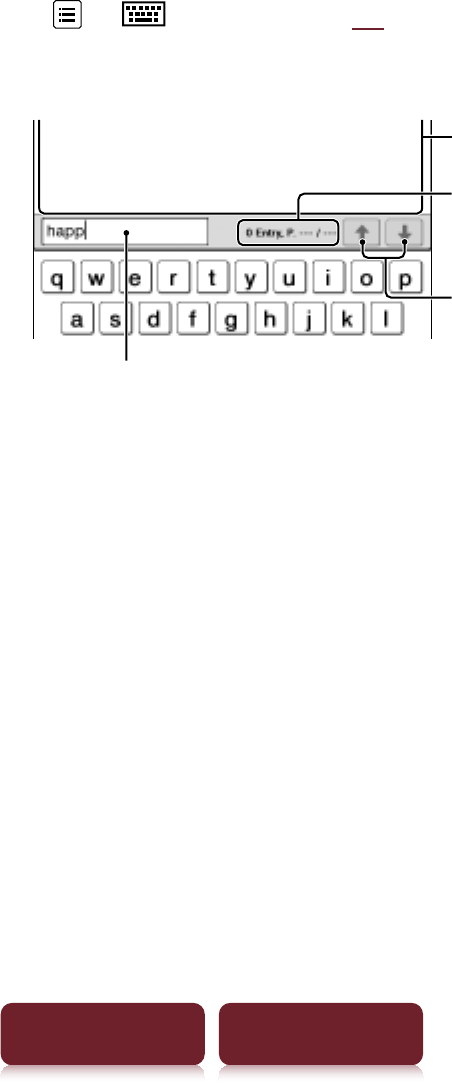
Using Embedded Dictionaries
83
Table of Contents Index
To list words with same head letters as previously
entered words
Tap or (keyboard) r26.
The list of candidate words changes dynamically
whenever the word in the input area is modified.
Listed candidate words
Number of entries and
page number/total pages
Scrolls the page
Input area
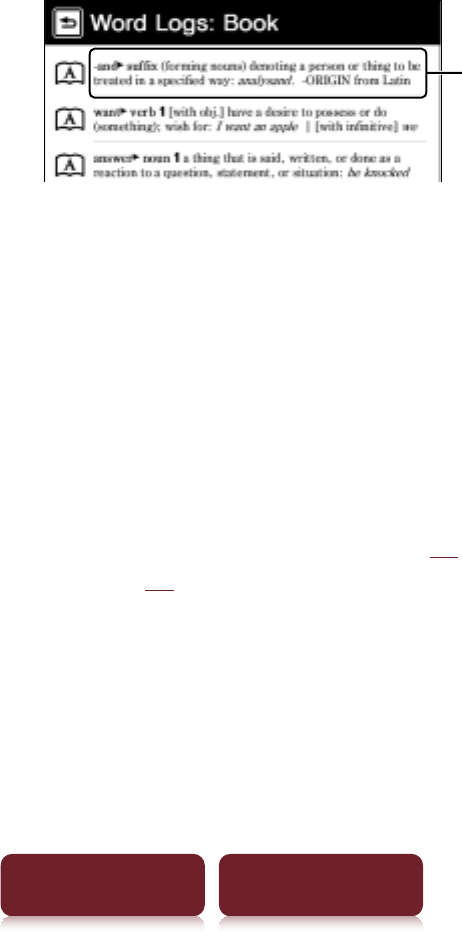
Using Embedded Dictionaries
84
Table of Contents Index
Listing previously looked up words
1At page view, press OPTIONS p tap [Word
Logs: Book].
The looked up words are listed in the order of most
recently looked up.
Word and definition
2Tap a desired word.
To delete word logs
Press OPTIONS p tap [Delete Word Logs] p tap the
check box of each word to be deleted p [Done] p [Yes].
Tip
A list of looked up words within a dictionary can be also
viewed by pressing OPTIONS p tap [Word Logs: Dictionary]
when viewing the definition area (r61) or the candidate
word list (r62).
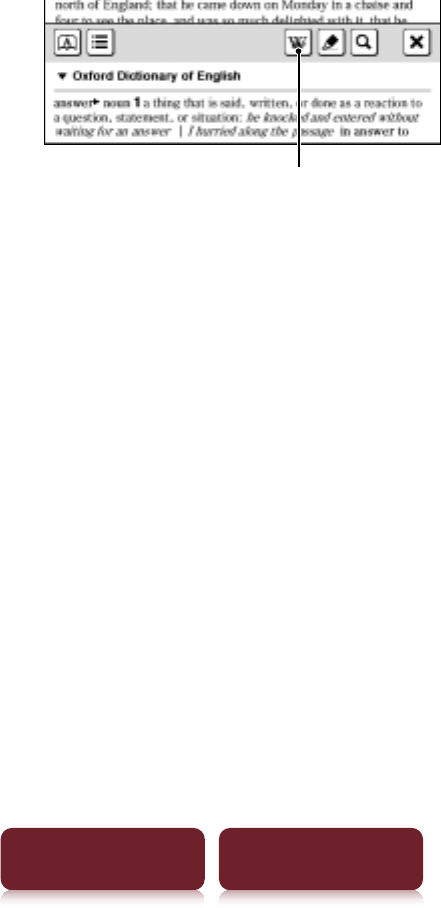
Using Wikipedia
85
Table of Contents Index
Using Wikipedia
A word or text can be searched for a information using
Wikipedia (only when connected to a Wi-Fi network).
1Double-tap a word.
The headline of the word definition is displayed.
Wikipedia
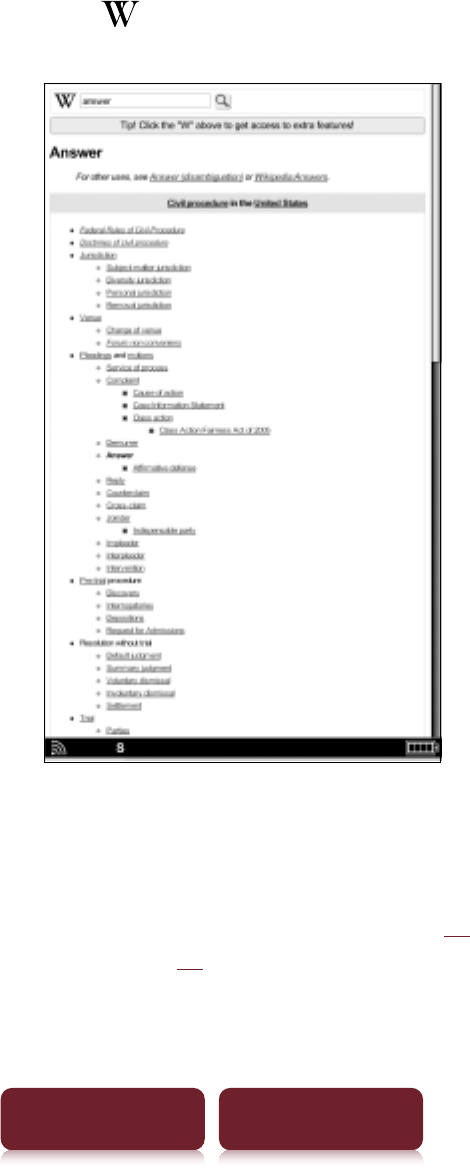
Using Wikipedia
86
Table of Contents Index
2Tap [Wikipedia].
The Wikipedia page appears.
Tips
ˎ
Wikipedia can be used when connecting Wi-Fi network. If
[Continue with Wi-Fi set-up] is displayed, tap [Setting] to
make the Wi-Fi network settings. (rxx).
ˎ
Please see rxx regarding OPTIONS menu.
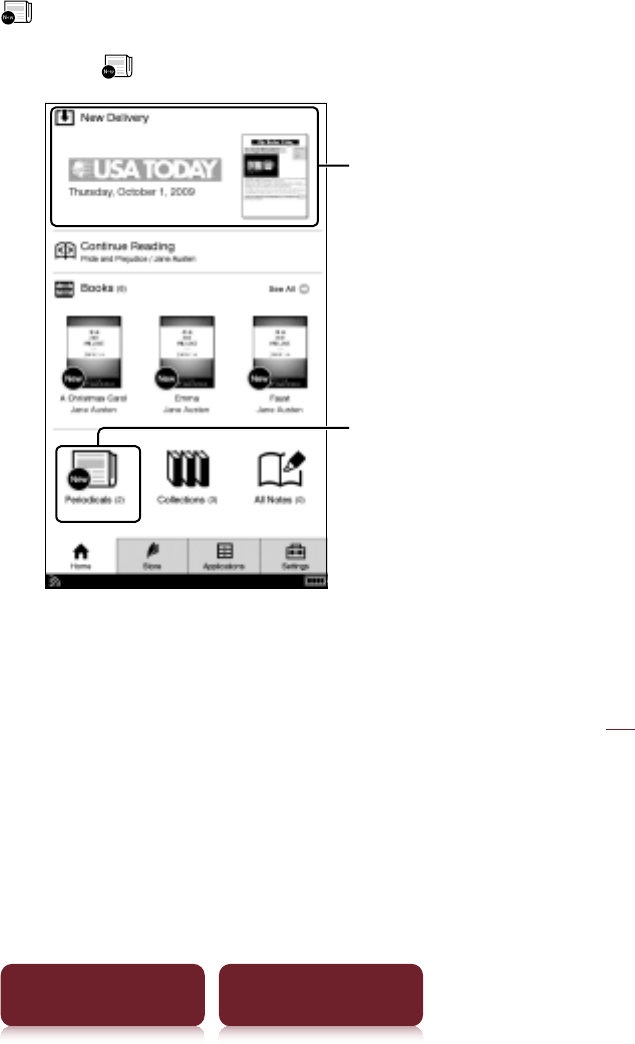
Reading Periodicals
87
Table of Contents Index
Reading Periodicals
You can read newspapers/magazines from
[Periodicals] in the [Home] menu.
1Tap [Periodicals] at [Home] menu.
[New Delivery]:
Most recent delivered issue
[Periodicals]:
Opens the [Periodicals] list
Tip
If you want to read most recent delivered issue, tap [New
Delivery] at [Home] menu and read the issue (r70).
2Tap a desired periodical to go to issue list.
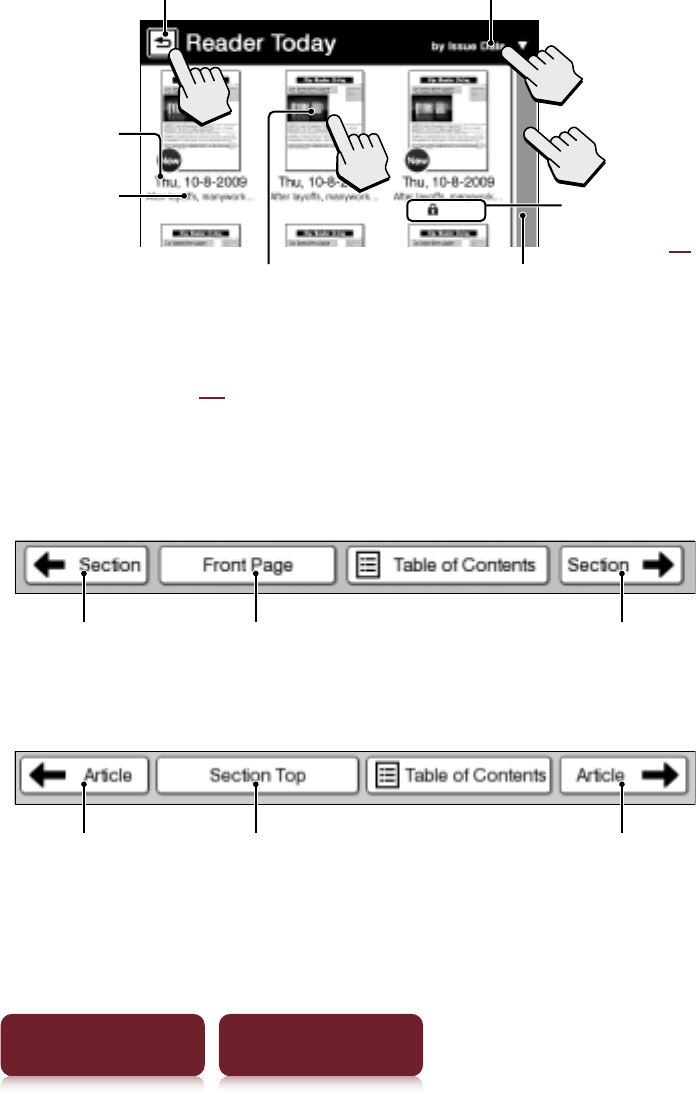
Reading Periodicals
88
Table of Contents Index
3Tap a desired issue in the list.
Issue date
Front page
headline
Scroll bar
Conditional icon
display (r36)
Tap to change sorting orderTap to previous page
Tap to open an issue
Tip
Please see rxx regarding OPTIONS menu.
4Use the navigation bar to read.
Operations on a section
Previous section Return to the first page Next section
Operations on an article
Previous article Return to the first page
of the section
Next article

Reading Periodicals
89
Table of Contents Index
Tips
ˎ
Annotations can be added (r39).
ˎ
Please see rxx regarding OPTIONS menu.
To delete a issue(s)
Tap [Periodicals] at [Home] menu p tap a periodical to
go to issue list p press OPTIONS p tap [Delete Issues].
To delete, refer to the example instructions for deleting
books in “Deleting Content” (rxx).
To protect, refer to the example instructions for
protecting books in “Protecting Content” (rxx).

90
Table of Contents Index
Reading from Memory Stick™ or SD Card
Reading from Memory
Stick™ or SD Card
You can transfer the purchased content on your
computer to a memory card by using Reader Libray.
The content on a memory card can be read by
inserting the memory card with the Reader (rxx).
For details transferring content to a memory card, refer
to Reader Library Help.
Tips
ˎ
If there is not enough free space on the Reader memory,
content on the Reader can be transferred to a memory card
by using Reader Library.
ˎ
You can group desired content on a memory card as a
collection. For details about collections, see rxx or refer to
Reader Library Help.
Note
The Reader cannot transfer content to memory cards
directly. Use Reader Library to transfer content.
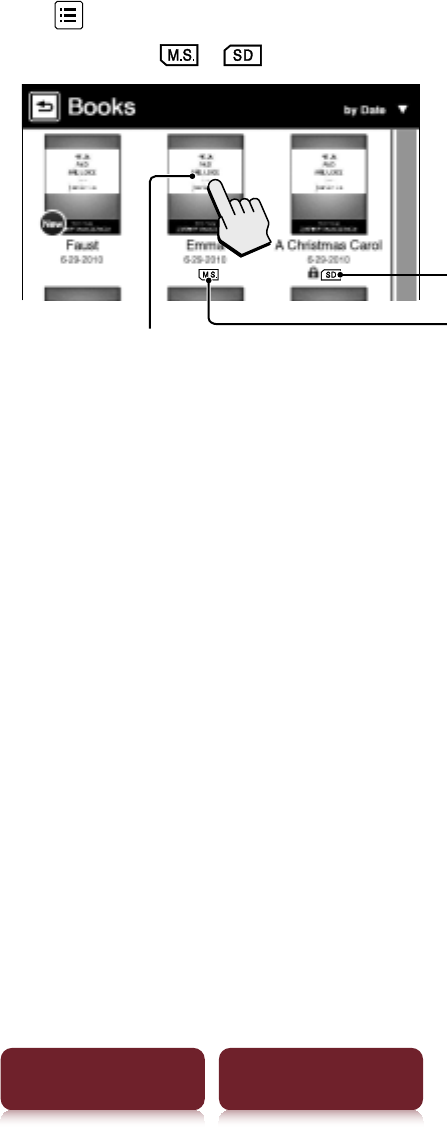
91
Table of Contents Index
Reading from Memory Stick™ or SD Card
Reading books on a memory card
Tap [Books] at [Home] menu to view a book list, Tap
a book with / icon to open.
Tap to open a book Content on Memory Stick
Duo™ media
Content on SD card

Browsing Websites (Open Browser)
92
Table of Contents Index
Browsing Websites (Open
Browser)
Web site can be browsed only when connected to a
Wi-Fi network.
Before accessing a Web site, confirm:
ˎ
The WIRELESS switch is set to ON. (rxx).
ˎ
Check that the [Mobile Network] or [Wi-Fi] is set to
[On] in the [Wireless Controls] setting (rxx)
ˎ
The wireless network is available.
Browsing Web Site
1Tap [Open Browser] under [Applications]
at [Home] menu.
Tips
ˎ
If [Continue with Wi-Fi set-up] is displayed, tap [Setting]
to make the Wi-Fi network settings. (rxx).
ˎ
About [Applications] menu, see (rxx).
2Tap the link of the desired Web site in the
Browse Home page.
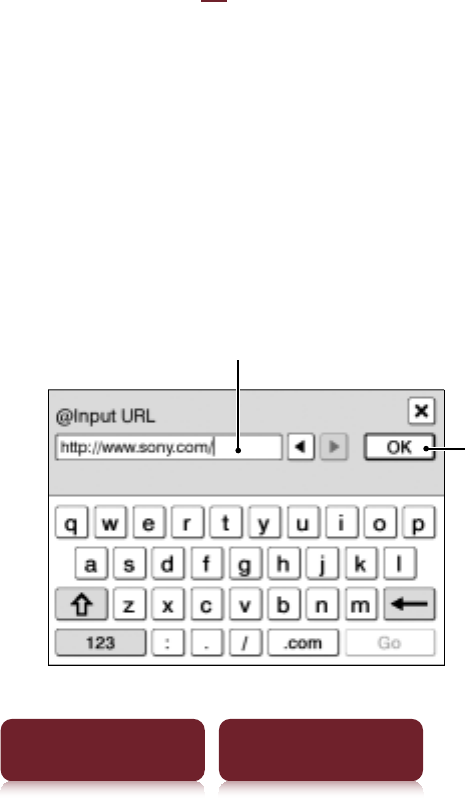
Browsing Websites (Open Browser)
93
Table of Contents Index
To display Web site by selecting Web Bookmarks
1At the Browse Home page or Web site page
view, press OPTIONS.
2Tap [Bookmarks].
3Tap the bookmark of the desired Web site.
Tip
For details on adding Web Bookmarks, see “Registering sites
in bookmark” (rxx).
To display a Web site by inputting its URL directly
1In the Browse Home page or Web site page
view, press OPTIONS.
2Tap [Input URL].
3Input the URL of the desired Web site p tap
[OK].
Input area
OK

Browsing Websites (Open Browser)
94
Table of Contents Index
Registering sites in bookmark
1A Web site page view you want to add to Web
Bookmark, press OPTIONS.
2Tap [Add to Bookmark].
To delete a Web Bookmark
1In the Browse Home page or Web site page
view, press OPTIONS p tap [View Bookmarks].
2Press OPTIONS.
3Tap [Delete Bookmarks].
4Tap the check box of each bookmark to be
deleted.
Tips
ˎ
To delete all bookmarks, press OPTIONS after step 3
above p tap [Select All].
ˎ
To undelete all bookmarks, press OPTIONS after step 3
above p tap [Unselect All].
5Tap [Done] p [OK].

Browsing Websites (Open Browser)
95
Table of Contents Index
To Edit the content of Web Bookmarks
1At Web Bookmarks page view, press OPTIONS.
2Tap [Edit Bookmarks].
3Tap a desired Bookmark p tap an item to edit.
4When the edit is completed, tap [OK].
5Tap [OK].
To delete a Web Bookmark
1In Web Bookmarks page view, press OPTIONS.
2Tap [Delete Bookmarks].
3Tap the check box of each bookmark to be
deleted.
Tips
ˎ
To delete all bookmarks, press OPTIONS after step 3
above p tap [Select All].
ˎ
To undelete all bookmarks, press OPTIONS after step 3
above p tap [Unselect All].
4Tap [Done] p [OK].
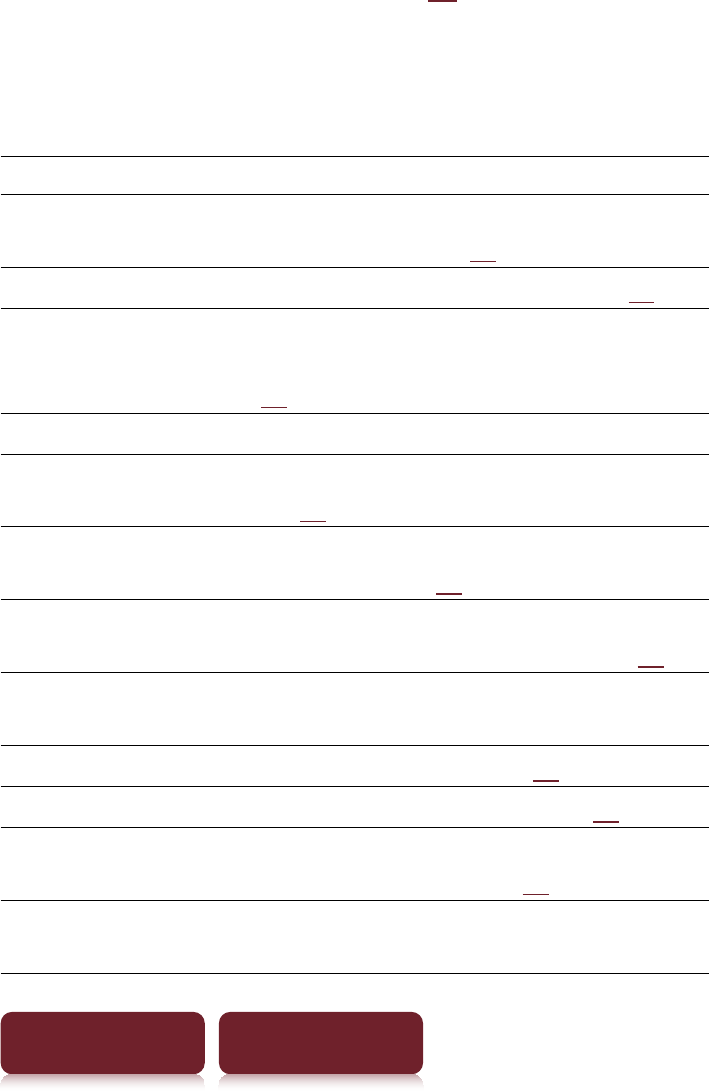
Browsing Websites (Open Browser)
96
Table of Contents Index
OPTIONS menu of Open Browser
Pressing the OPTIONS button (rxx) will display the
menu for related supplementary functions.
The following items are listed in alphabetical order.
When displaying the OPTIONS menu, not all items
listed below will be shown in any given circumstance.
Item Description/Reference page
[Add to bookmark] Adds currently displayed Web site to
the Bookmark (rxx).
[Bookmarks] Displays the Web Bookmarks (rxx).
[Browse Home] Returns to the Browse Home page
while activating the Open Browser (r
xx).
[Continue Reading] Shows the last read page of the content.
[Delete Bookmarks] Deletes the Web Bookmark selected
(rxx).
[Edit Bookmarks] Edits the contents of selected Web
Bookmarks (rxx).
[Input Address] Displays the URL input page while
activating the Open Browser (rxx).
[Legal Information] Displays the Legal Information page
of currently displayed Web site.
[Now Playing] Shows audio player (rxx).
[Resume Playing] Resumes audio playback (rxx).
[Page Info] Displays the information of currently
displayed Web site (rxx).
[Refresh Page] Refresh the display of currently
displayed Web site.

Browsing Websites (Open Browser)
97
Table of Contents Index
Item Description/Reference page
[Stop] XXXXXXXXXX.
[Take Screenshot] Saves the screenshot of the currently
displayed Web site (rXX).
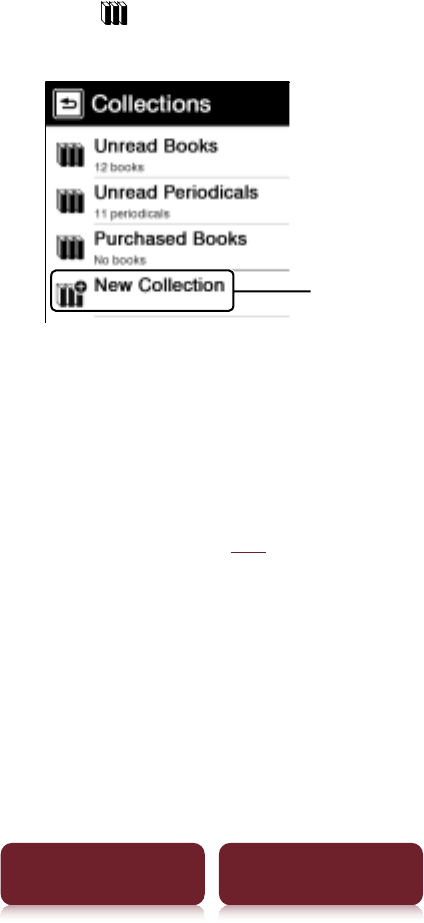
Collections
98
Table of Contents Index
Collections
Creating
You can group desired content in Reader as a
collection.
1Tap [Collections] at [Home] menu p [New
Collection].
[New Collection]
Tip
Press OPTIONS p tap [New Collection] to create a
collection.
2Enter the collection name using the on-screen
keyboard (r26)p tap [OK].
3Tap [Internal Memory], [Memory Stick™] or [SD
Card] to select where you want to create the
collection p tap [OK].
A new collection is created in the [Collections] list.

Collections
99
Table of Contents Index
Tip
You can create/sync a collection by Reader Library. For
details, refer to the Reader Library Help.
To change a collection name
In the [Collections] list, tap the collection p press
OPTIONS p tap [Rename Collection] p enter a new
collection name using the on-screen keyboard p tap
[OK].
Adding contents
From the collections
Note
Only content in the same physical location as the selected
collection can be added.
1Tap [Collections] at [Home] menu p tap a
created collection.
2Press OPTIONS p tap [Add Content] p [Books]
or [Periodicals].
In the periodical list, select a periodical and then
select issues.
3Tap the thumbnail of a desired content p
[Done].

Collections
100
Table of Contents Index
From either the books or issues list
1In the books or issues list, press OPTIONS p tap
[Add to Collection].
2In the collection list, tap a collection you want
to add the content.
3Tap the thumbnail of the desired content p
[Done].
You can check added content in the collection list.
Tip
To select all books or issues, press OPTIONS in the [Add
Books] or [Add Issues] list p tap [Select All].
Deleting a collection
Even if you delete a collection, all contents in the
collection will remain undeleted on the Reader.
1Tap [Collections] at [Home] menu.
2Press OPTIONS p tap [Delete Collections].
3Tap the check box of each collection to be
deleted p [Done] p [Yes].
Tip
Also, you can delete a collection using Reader Library. For
details, refer to the Reader Library Help.

Collections
101
Table of Contents Index
Removing contents
Even if you delete content in a collection, the
corresponding content will remain undeleted on the
Reader.
1Tap [Collections] at [Home] menu p tap a
collection.
2Press OPTIONS p tap [Remove Content].
3Tap the thumbnail of each content to be
deleted p [Done] p [Yes].
Tips
ˎ
To select all contents, press OPTIONS after step 2 above p
tap [Select All].
ˎ
When you delete contents in [Books] or [Periodicals],
corresponding contents are also deleted from relevant
collections.
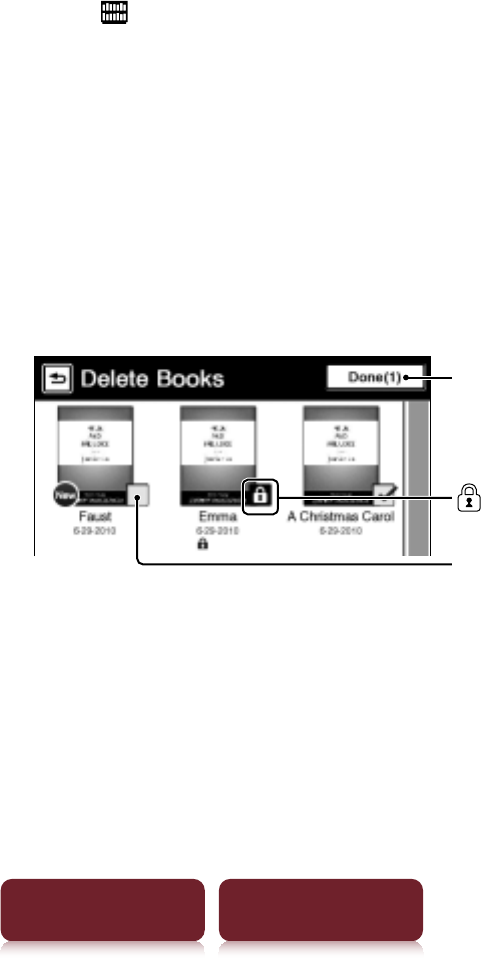
Managing Content
102
Table of Contents Index
Managing Content
Deleting Content
Example: [Books] list
1Tap [Books] p press OPTIONS p tap [Delete
Books].
To delete: tap a book thumbnail with the blank
check box.
To delete all: press OPTIONS p tap [Select All].
To undelete: tap a book thumbnail with a checked
check box.
To unselect all: press OPTIONS p tap [Unselect All].
2Tap [Done] p [Yes].
Selected number of items
(Protect)
Check box
Tip
You can also delete the currently viewed book. Press
OPTIONS in the page view p tap [Delete Book] p [Yes].
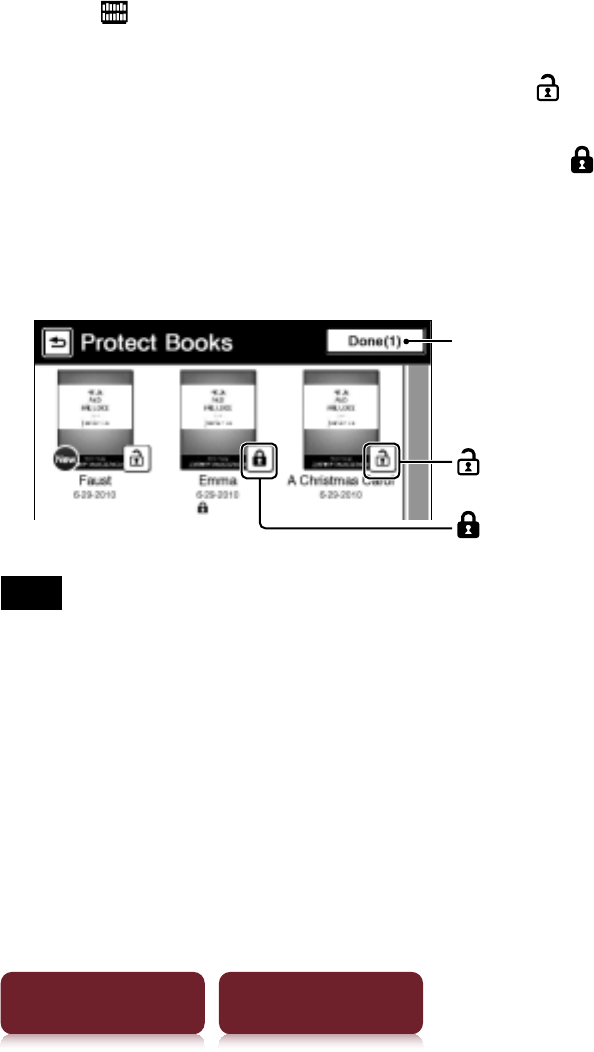
Managing Content
103
Table of Contents Index
Protecting Content
Example: [Books] list
1Tap [Books] p press OPTIONS p tap [Protect
Books].
To protect: tap a book thumbnail with .
To protect all: press OPTIONS p tap [Protect All].
To unprotect: tap a book thumbnail with .
To unprotect all: press OPTIONS p tap [Unprotect
All].
2Tap [Done].
Selected number of items
(Unprotect)
(Protect)
Note
This protection feature works only on the Reader. Protected
content may still be deleted via your computer.
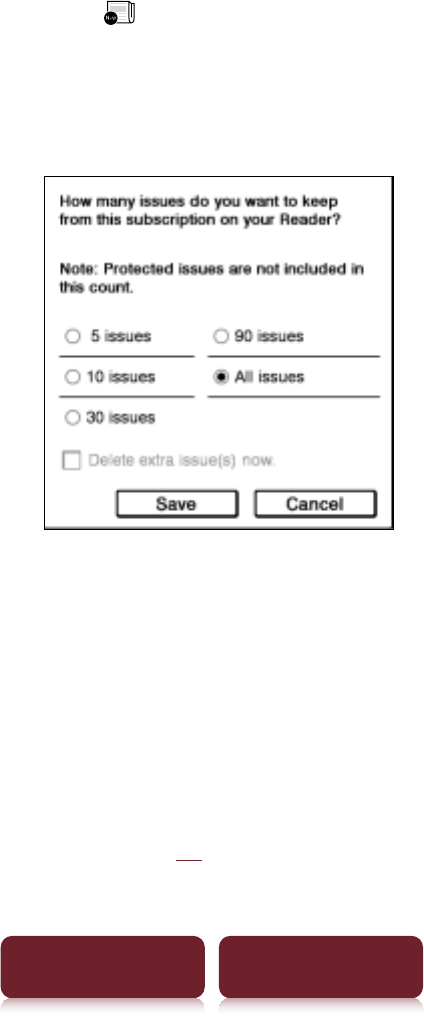
Managing Content
104
Table of Contents Index
Managing periodicals
In the issue list, you can keep only recent issues and
delete previous issues automatically.
1Tap [Periodicals] at [Home] menu p tap a
periodical.
2Press OPTIONS p tap [Manage Subscription].
The management dialog appears.
3Tap the desired setting p [Save]
Tips
ˎ
If you want to delete extra issues immediately, tap
[Delete extra issues now.] p [Save]. In the confirmation
dialog, tap [Yes].
ˎ
If you have issues that you do not want to delete,
protect them using [Protect Issues] in the OPTIONS
menu (rxx).

Managing Content
105
Table of Contents Index
Notes
ˎYou cannot manage periodicals on memory cards via the
Reader.
ˎIf the number of issues in the list is less than your selected
number, [Delete extra issues] will not delete any issues.
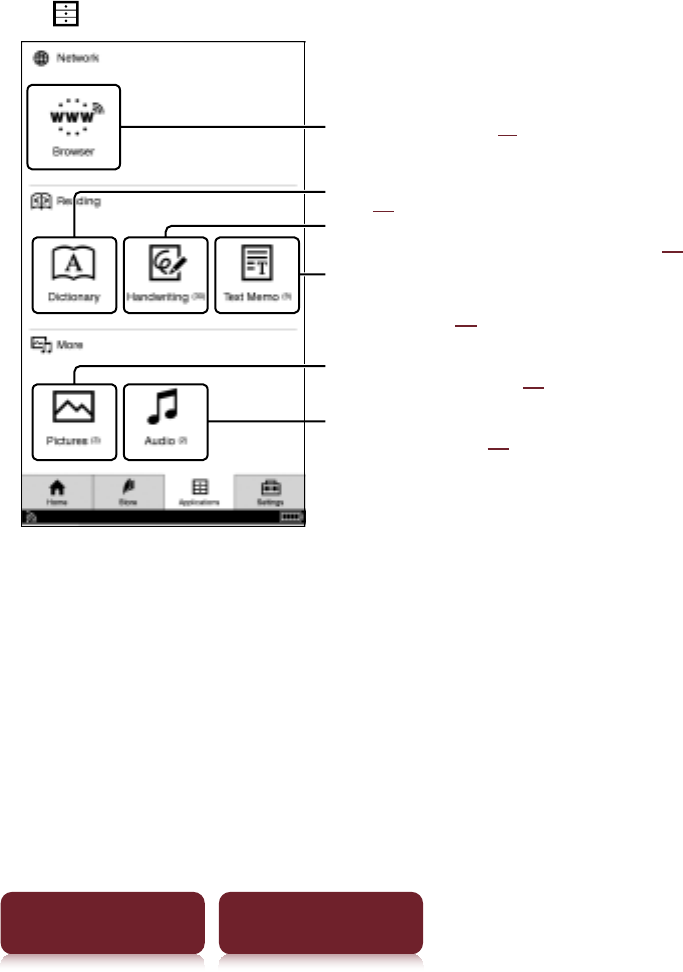
Applications
106
Table of Contents Index
Applications menu
The [Applications] menu provides useful functions,
such as listening to music while reading a book,
creating a text or a handwritten memo, and more.
Tap [Applications] at [Home] menu.
To list all pictures (r83)
To list/create handwritten note(s) (r77)
Audio player (r85)
To create/edit/view text
memo(s) (r80)
To use the currently selected dictionary
(r82)
Open Browser (rxx)

Applications menu
107
Table of Contents Index
Using an embedded dictionary
1Tap [Dictionary] under [Applications] at
[Home] menu.
The name of the currently selected dictionary is
shown at the top of the screen. To switch to another
dictionary, press OPTIONS p tap [Change
Dictionary].
2Input a word using the on-screen keyboard
(r26)p tap a candidate word.
The definition is displayed in-full in the dictionary
viewer (r61).
To list words with same head letters as the inputted
word
Tap (keyboard).
To list previously looked up words
Press OPTIONS p tap [Word Logs: Dictionary]. To delete
word logs, see (r63).
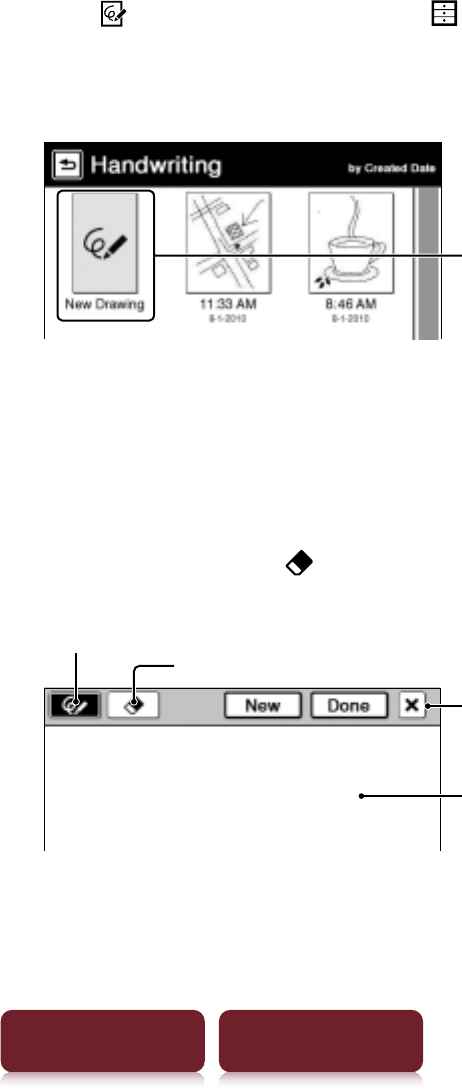
Applications menu
108
Table of Contents Index
Creating drawings
1Tap [Handwriting] under [Applications] at
[Home] menu.
2Tap [New Drawing].
[New Drawing]
Tip
Press OPTIONS p tap [New Drawing] to create a drawing.
3Draw in the drawing area with the supplied
stylus or your finger p tap [Done].
To erase a line, tap p tap or stroke a part of the
line.
Pen
Drawing area
Eraser
Quit

Applications menu
109
Table of Contents Index
Tips
ˎ
If you tap [New], the current drawing is saved, and a new
drawing editor opens.
ˎ
Newly created drawings will be saved only in the internal
memory.
Notes
ˎ
While writing, make sure that you are not touching another
area on the screen – this could affect the notes that you
write with the stylus or your finger.
ˎ
To ensure your notes are correctly saved, do not handwrite
notes too close to the edge of the screen.
ˎ
If you experience difficulties when handwriting or drawing
on your Reader:
– avoid applying excessive pressure to the screen.
– try not to handwrite or draw too quickly.
– the notes functionality is not designed for very detailed
drawings or for writing small characters.
Viewing/editing created drawings
After step 1 (r77), tap a drawing thumbnail to view.
Tap [Edit] and follow step 3 above.

Applications menu
110
Table of Contents Index
To delete/protect a drawing(s)
Tap [Handwriting] under [Applications] at [Home]
menu, press OPTIONS p tap [Delete Drawings] or
[Protect Drawings].
To delete, follow the instruction after tapping [Delete
Books] in “Deleting Content” (r74).
To protect, follow the instruction after tapping [Protect
Books] in “Protecting Content” (r75).
Tip
After step 1 (r77), tap a drawing thumbnail to view and
press OPTIONS p tap [Delete Drawing] to delete the
currently viewed drawing.
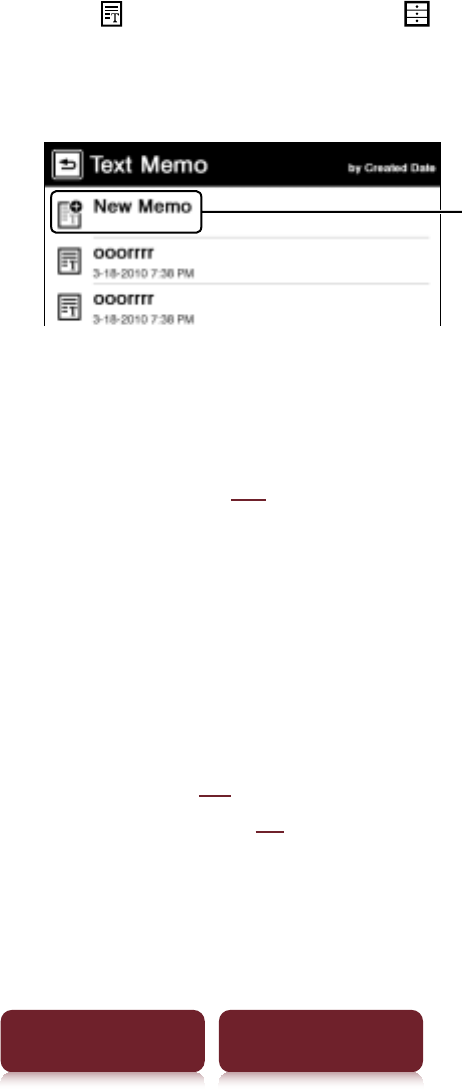
Applications menu
111
Table of Contents Index
Creating text memos
1Tap [Text Memo] under [Applications] at
[Home] menu.
2Tap [New Memo].
[New Memo]
Tip
Press OPTIONS p tap [New Memo] to create a text memo.
3Enter text in the input area using the on-screen
keyboard (r26)p Tap [Done].
Tips
ˎ
If you tap [New], the current text memo is saved, and a new
text memo editor opens.
ˎ
Newly created text memos will be saved only in the
internal memory.
Viewing/editing text memos
After step 1 (r80), tap a memo to view. Tap [Edit] and
follow the step 3 rxx.

Applications menu
112
Table of Contents Index
To delete/protect a text memo in the list
Tap [Text Memo] under [Applications] at [Home]
menu, press OPTIONS p tap [Delete Memos] or
[Protect Memos].
To delete, refer to the example instructions for deleting
books in “Deleting Content” (r74).
To protect, refer to the example instructions for
protecting books in “Protecting Content” (r75).
Tip
After step 1 (r80), tap a memo to view and press OPTIONS
p tap [Delete Memo] to delete the currently viewed memo.

Applications menu
113
Table of Contents Index
Viewing pictures
You can view pictures stored in either internal memory
or a memory card. Also, you can set your favorite
pictures to the standby screen.
1Tap [Pictures] under [Applications] at
[Home] menu.
2Tap a thumbnail of desired picture on the list.
Tips
ˎ
Please see rxx regarding OPTIONS menu.
ˎ
See “Supported File Format” (r121).
ˎ
To transfer pictures to the Reader using Reader Library,
refer to Reader Library Help.
To set slideshow
Press OPTIONS p tap [Slideshow On].
To set the duration of a slideshow, see [Slideshow] of
[Application Preferences] (rxx).

Applications menu
114
Table of Contents Index
To set as a standby screen
In the [Pictures] list, press OPTIONS p [Select Standby
Screen] p tap the thumbnail of candidate picture p tap
[Done].
The [Standby Screen] setting is configured from the
[Settings] menu (r94).
Tip
When two pictures or more have been selected, the
displayed picture is changed every time the Reader enters
the sleep mode (rxx).
To zoom in a picture
Press (rxx) to switch to the zoom-in mode.
Tip
Double-tap where you wish to zoom in further. The double-
tapped area will be shown centered automatically after
zooming in.
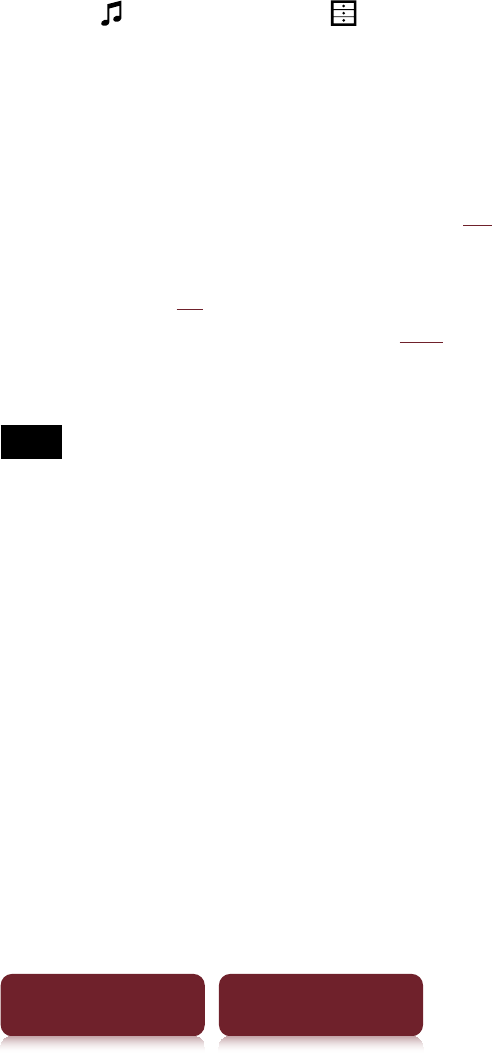
Applications menu
115
Table of Contents Index
Playing audio files
You can enjoy audio files with optional headphones.
1Tap [Audio] under [Applications] at [Home]
menu.
2Tap a desired album to go to the audio list.
3Tap a desired audio file, and play an audio file.
The playback screen appears (rxx).
Tips
ˎ
Please see rxx regarding OPTIONS menu.
ˎ
See “Supported File Formats” (r121).
ˎ
To transfer audio files to the Reader using Reader Library,
refer to Reader Library Help.
Note
ˎ
An album or an audio file with cover art information can
only display its thumbnail in the album list.
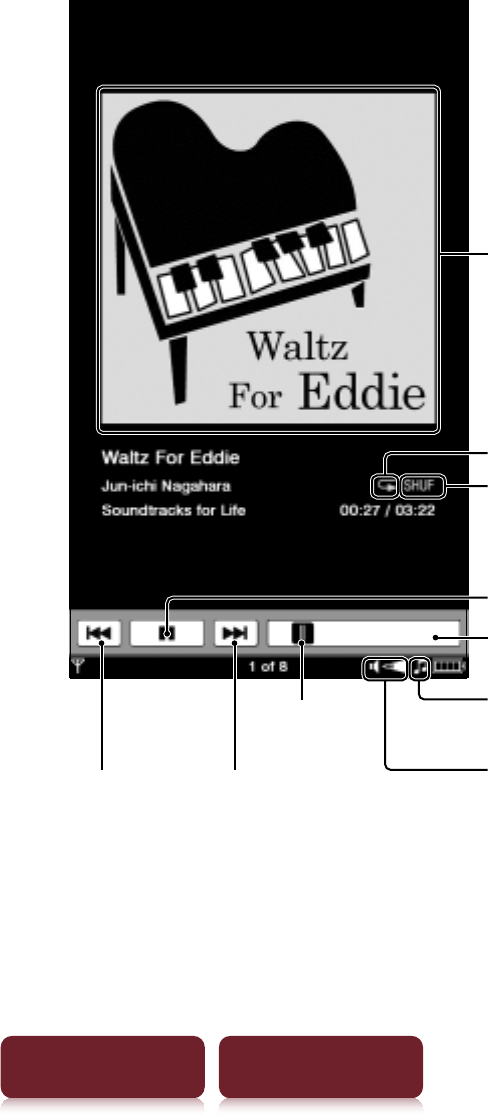
Applications menu
116
Table of Contents Index
Playback screen operations
Cover art
Repeat icon
Shuffle icon
Play/pause
Playback progress bar
Volume indicator
Playback icon appears
during playback
Playback
position
Skip to the
beginning of the
previous (or current
if played more than
3 seconds from the
beginning) audio
file
Skip to the
beginning of the
next audio file
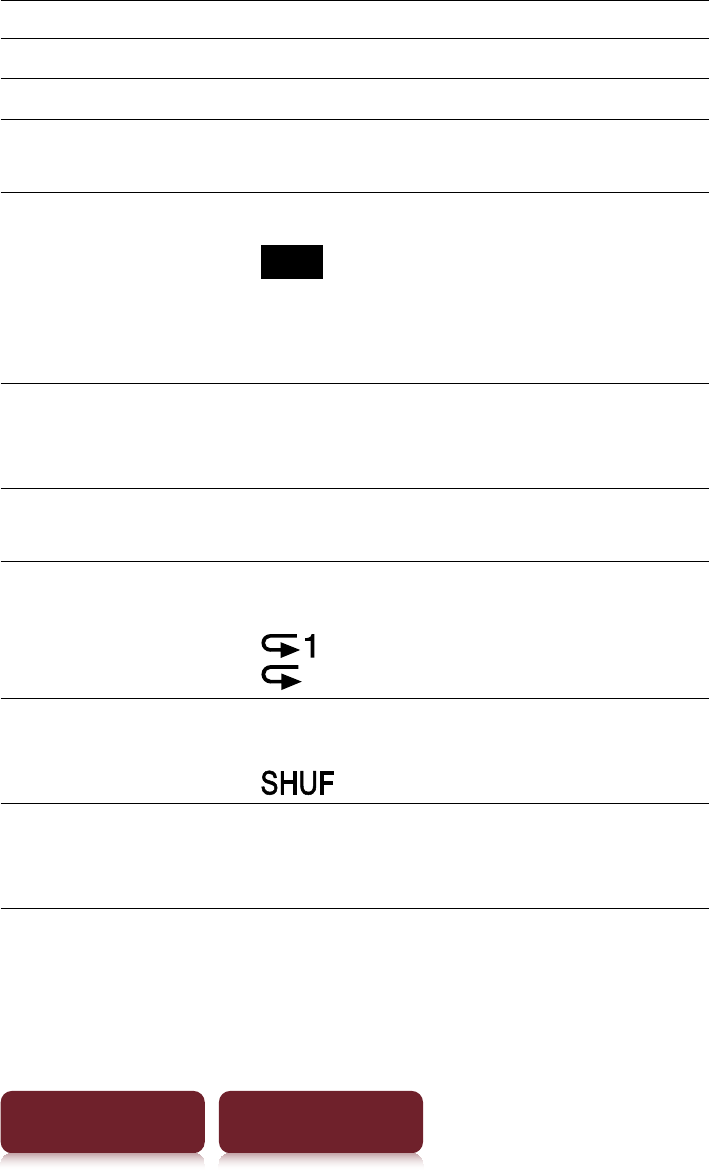
Applications menu
117
Table of Contents Index
To Do this
Pause a song Tap ê.
Resume playback Tap à.
Skip to the previous/
next track
Swipe the playback screen.
Skip to the
beginning of the
previous (or current)
audio file/beginning
of the next audio file
Tap Ã/Ñ.
Note
Skips to the beginning of the current
audio file if played more than 3
seconds from the beginning.
Fast-reverse/
fast-forward an
audio file
Drag the playback position indicator,
or tap on the playback progress bar.
Control the volume Press the volume button. The volume
indicator will appear in the status bar.
Repeat songs Press OPTIONS p tap [Repeat] p tap
[Off], [One Song] or [All Songs].
: Repeat one song
: Repeat all songs in the album
Shuffle songs Press OPTIONS p tap [Shuffle On] or
[Shuffle Off ].
: Shuffle play
Mute playback Press and hold the volume button. To
resume, press the volume button
again.

Settings
118
Table of Contents Index
Changing Settings
Tap [Settings] at [Home] menu.
[General Settings] (r90)
[Date and Time]
[Date and Time Format]
[Page Turn Preference]
[Menu Language]
[Keyboard]
[Screen Orientation]
[Application Preferences] (r91)
[Dictionary]
[Slideshow]
[System Management] (r92)
[Power Management]
[Device Lock]
[Standby Screen]
[Initialization] (r95)
[Restore Defaults]
[Clear Keyboard History]
[Format Memory]

Changing Settings
119
Table of Contents Index
[Wireless Controls] (rxx)
[Wi-Fi Settings] (rxx)
[About]
Displays system and legal information of the Reader.
[Device Shutdown]
Shuts down (power off) the Reader completely.

Changing Settings
120
Table of Contents Index
[General Settings]
[Date and Time]
Tap a field to change.
Input a number by tapping the numeric key pad.
Tap [OK] to apply the change.
Tip
The date and time of your Reader will be automatically
synchronized to your computer by the Reader Library after
connection.
[Date and Time Format]
Tap [Month-Day-Year] or [Day-Month-Year] to select
the date format.
Tap [12 hour] or [24 hour] to select the time format.
Tap [OK] to apply the changes.
[Page Turn Preference]
Sets the swiping direction to turn pages forward.
Swiping to left is default setting.
[Menu Language]
Selects the language of the Reader’s menu and
messages.
[Keyboard]
Selects a preferred on-screen keyboard.

Changing Settings
121
Table of Contents Index
[Screen Orientation]
Sets the direction to rotate when changing from
portrait to landscape mode.
[Application Preferences]
[Dictionary]
Selects a default dictionary to use.
[Slideshow]
Sets the slideshow on/off and its duration up to 60
seconds.
Note
Slideshow may take a longer time to display depending on
the size of picture.

Changing Settings
122
Table of Contents Index
[System Management]
[Power Management]
Power management helps avoid unnecessary battery
consumption.
Power management operates as follows:
ˎ
After 10 minutes of inactivity, the Reader enters the
sleep mode automatically and battery consumption
is minimized.
ˎ
After three* days of inactivity, the Reader
automatically shuts down and stops consuming
battery power.
* If battery power is at a low level, the Reader will shut down
within three days of inactivity.
Note
The Reader does not enter the sleep mode after 10 minutes
of inactivity even if [Power Management] is set to [On],
when:
– connected to a computer using the supplied USB cable
– charging with an AC adapter (PRSA-AC1) (optional)
– playing an audio file or when a slideshow is set

Changing Settings
123
Table of Contents Index
[Device Lock]
Locks the Reader by setting a pass code.
Tap [On] to set a pass code.
Input a 4-digit number by tapping the numeric key
pad.
Tap [OK] to lock the Reader.
To unlock, input the pass code and tap [OK]. Then tap
[Off] to unlock the Reader, and tap [OK].
Notes
ˎ
[0000] is the factory setting.
ˎ
You are recommended to make a note of your password
and keep it in a safe place separate from the Reader.
ˎ
If you forget your password, contact your Sony Customer
Support (r18); however, note that in unlocking your
device, all content on it will be erased.
ˎ
When the [Device Lock] setting is activated, the Reader will
not be recognized by your computer, please set to [Off]
before connecting.
[Standby Screen]
Sets the standby screen during the sleep mode. [Off]
displays nothing in the sleep mode.
ˎ
[Show picture]: Set [On] to show the selected
pictures on the standby screen. For details on setting
the pictures, see “To set as a standby screen” (r84).
ˎ
[Show message]: Set [On] to show messages on the
standby screen.

Changing Settings
124
Table of Contents Index
[Initialization]
[Restore Defaults]
Restores the Reader to its default settings.
You will need to perform the initial settings after
restoring.
[Clear Keyboard History]
Deletes predictive words for the on-screen keyboard.
[Format Memory]
Formats the internal memory of the Reader or an
inserted memory card. Formatting will erase all the
contents in the selected storage.
Note
Before formatting, make sure to backup data you wish to
keep to your computer via Reader Library. Note that
protected content will also be deleted by formatting.

Changing Settings
125
Table of Contents Index
[Wireless Controls]
[Mobile Network]
[Wi-Fi]
Sets mobile network and Wi-Fi to on/off individually.
When setting to [OFF], selected network is always
disabled. [ON] is set by default.
Tap [OK] to apply the change.
Note
Neither [Mobile Network] nor [Wi-Fi] cannot be set to [OFF].
If you want to disconnect from the connection of both
mobile network and Wi-Fi, set the WIRELESS switch to OFF.
[Wireless Standby]
Wireless standby helps avoid unnecessary battery
consumption caused by wireless communication. [ON]
is set by default.
If you do not perform any wireless operations for more
than 10 minutes, the wireless feature automatically
enters standby mode, During standby mode, you can
receive periodicals while minimizing the battery
consumption.
Tap [OK] to apply the change.
Notes
ˎ
Accessing the Reader Store from the wireless standby
mode takes more time than accessing when the Reader is
connected to the wireless network.
ˎ
If you deactivate wireless standby, the Reader retains
wireless connection at all times, resulting in higher battery
consumption.
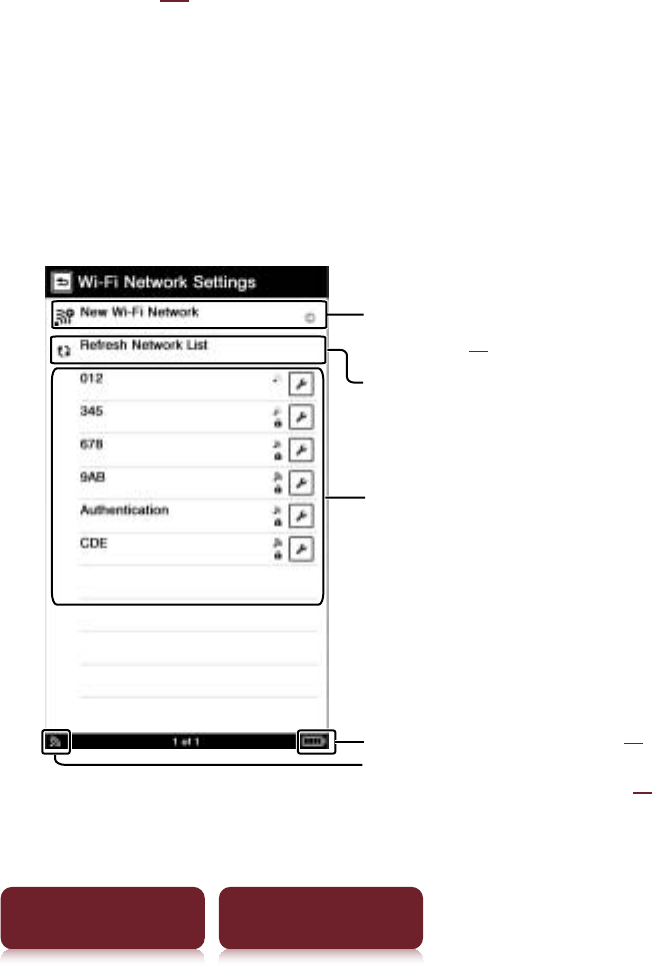
Changing Settings
126
Table of Contents Index
[Wi-Fi Network Settings]
The [Wi-Fi Network Settings] screen can be displayed
from the following two screens.
ˎ
Tap [Continue with Wi-Fi Setup] at [Wi-Fi-Set-up]
screen (rxx).
ˎ
Tap [Wi-Fi Network Settings] at [Settings] menu.
On the [Wi-Fi Network Settings] screen, registered
access points and access points that are installed
within the communication range of the Reader are
displayed in a list.
Tap to register a new access
point (rxx)
Tap to search the surrounding
access point again
Access points list:
Tap to connect an access point
Check the battery status (rxx)
Check the network status (rxx)
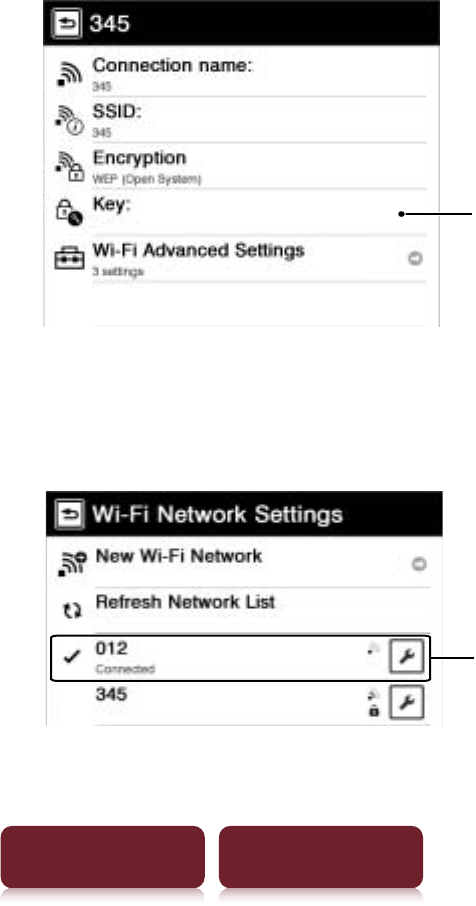
Changing Settings
127
Table of Contents Index
1Tap the access point you want to connect to
from the access points list.
If an encryption key is required, the detailed screen
appears.
When no encryption key is required, the Reader
connects to the selected access point. A check mark
and [Connected] appears to the access point.
Tap to enter the
encryption key
2Tap [Key] p enter the encryption key using the
on-screen keyboard p tap [OK].
The Reader connects to the selected access point.
Connected access point

Changing Settings
128
Table of Contents Index
Tips
ˎ
After registering, you can connect to the access point by
simply selecting it from the [Wi-Fi Network Settings]
screen.
ˎ
If you do not know the WEP key or WPA key for the access
point, refer to the operation guide for the access point, or
consult the administrator of the network or the public
Internet access service provider.
If you cannot connect
Some access points require more detailed settings. See “New
Access Point” (rxx) to set up. If you are not sure about the
settings, ask the person who installed the access point, the
administrator of the Wi-Fi, or the public Internet access
service provider.
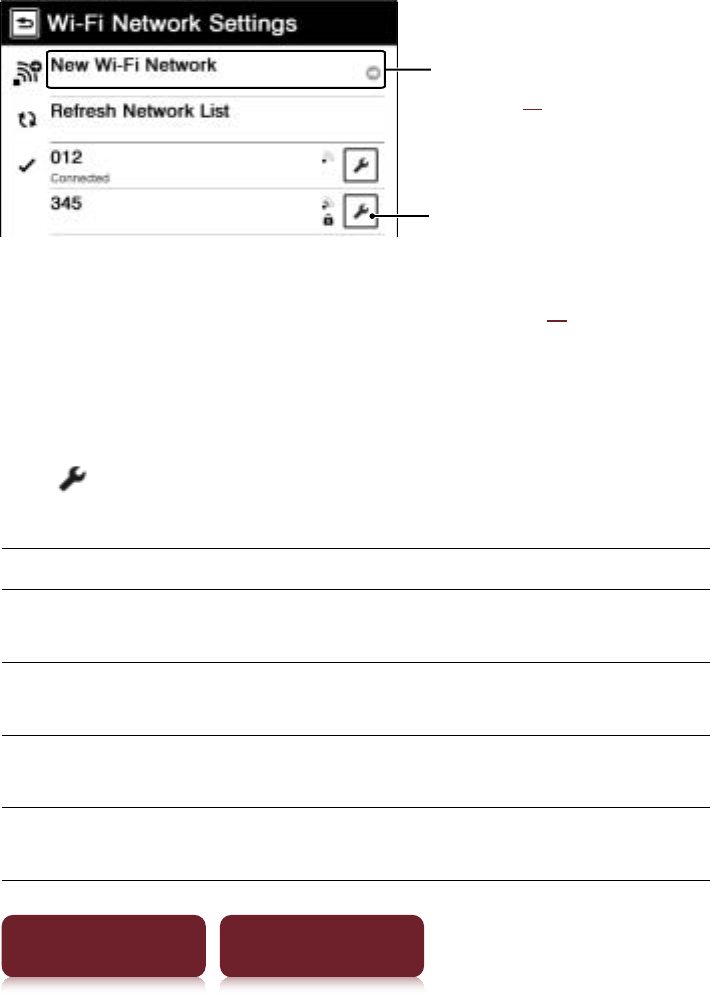
Changing Settings
129
Table of Contents Index
New Access Point
You can register or edit the access points displayed in a
list. The access point not displayed in the access point
list can also be registered.
Tap to display the detailed
screen of the access point to
register or edit the access point
settings (rxx)
Tap to register a new access
point (rxx)
Registering and editing the access point from the
list
Tap of the access point you want to set.
The following items are displayed.
Item Description
[Connection
name:]
Enters the connection name using the
on-screen keyboard p tap [OK].
[SSID:] Enters the SSID of the access point using
the on-screen keyboard p tap [OK].
[Encryption] Tap the encryption method type of the
access point p tap [OK].
[Key:] Enters the encryption key using the on-
screen keyboard p tap [OK].
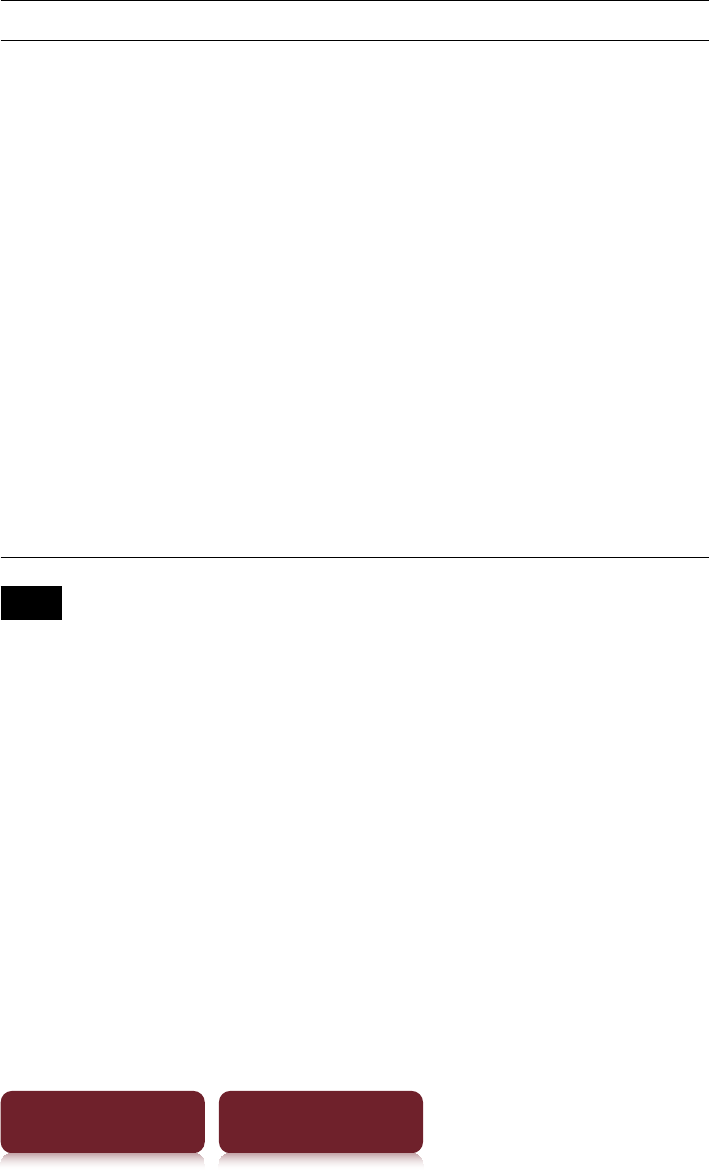
Changing Settings
130
Table of Contents Index
Item Description
[Wi-Fi Advanced
Settings]
[IP Address]: Tap [Auto] to set the IP
address automatically by using DHCP
when the access point supports DHCP.
To set the IP address manually, tap
[Manual] p a field to change. Input a
number by tapping the numeric key
pad p tap [OK].
[DNS]: Enter the IP address of DNS
Server by tapping the numeric key pad
p tap [OK].
[Proxy]: When the Wi-Fi you intend to
connect to does not use a proxy server,
tap [Off]. When using a proxy server,
enter IP address and port number by
tapping the numeric key pad p tap [OK].
Note
When setting the IP address manually, it is necessary to set
[DNS] manually. If the message dialog is displayed when
tapping [Manual], tap [Yes].
When the setting of access point is completed, the
registration complete dialog is displayed.
When connecting the Reader with the access point
that finished being set, tap [Connect]. When not
connecting, tap [Finish]. The [Wi-Fi Network Settings]
screen is displayed.
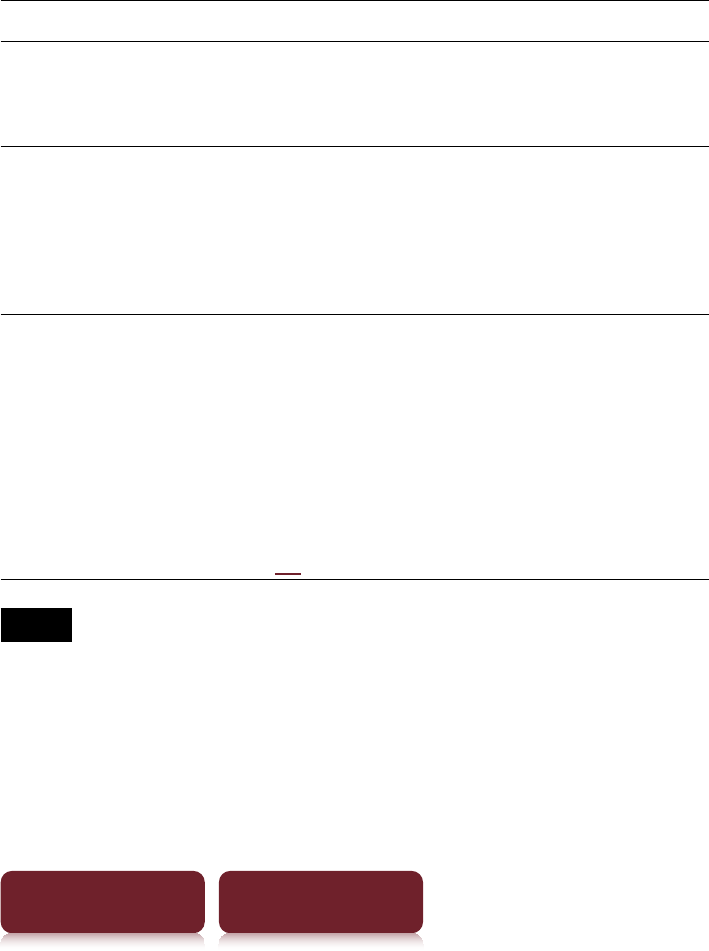
Changing Settings
131
Table of Contents Index
Registering a new access point not displayed in the
list
Tap [New Wi-Fi Network] p tap the desired setting
method.
There are 3 way to register the access point. Set up
following the instructions on the screen.
Item Description
[WPS Push Button] Connects to the WPS-compliant access
point by using the push-button
method.
[WPS PIN Input] Connects to the WPS-compliant access
point using the PIN method. Enter the
PIN code of Reader (an 8-digit number)
by tapping the numeric key pad p tap
[OK].
[Manual Input] Allows you to enter the SSID manually.
When the access point is set to hide the
SSID, use this setting.
Enter the SSID of the access point using
the on-screen keyboard p tap [OK].
When the detailed setting items are
displayed, make the required settings
(rxx).
Notes
ˎ
For information on the WPS settings of your access point,
refer to the operation guide of the access point.
ˎ
After WPS setting for wireless LAN connection between the
player and access point, the access point may become
unconnectable to devices that were previously connected.
For details, refer to the operation guide of the access point.
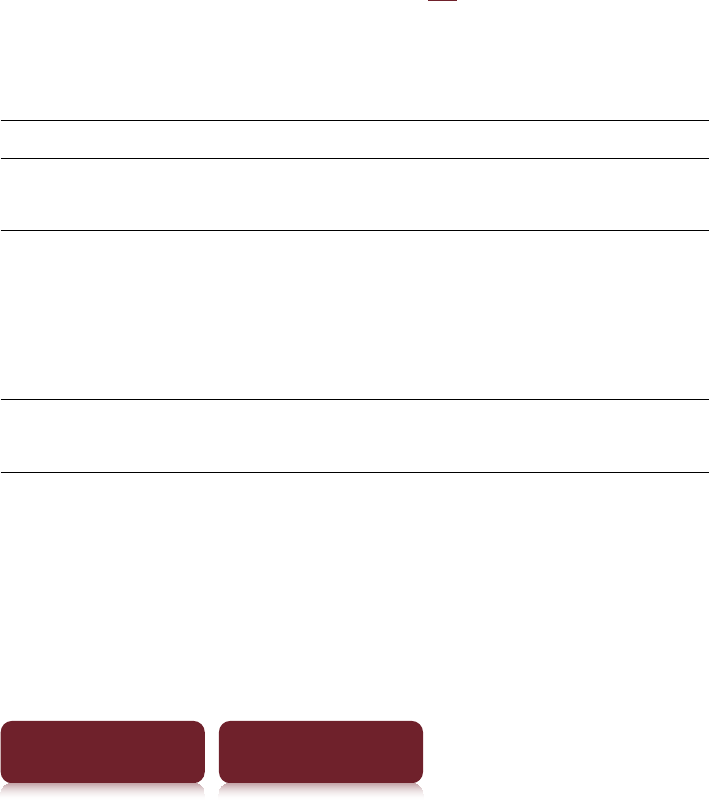
Changing Settings
132
Table of Contents Index
ˎ
For information on the settings of the access point, refer to
the operation guide of the access point, consult the
administrator of the access point, or consult the public
Internet access service provider.
ˎ
You can register up to 32 access points.
ˎ
If you begin the new registration using the Push-Button or
PIN method during connection to a wireless LAN, the
connection will be terminated.
OPTIONS menu of [Wi-Fi Network Settings]
Pressing the OPTIONS button (rxx) will display the
menu for related supplementary functions.
When displaying the OPTIONS menu, not all items
listed below will be shown in any given circumstance.
Item Description/Reference page
[Delete Access
Points]
Deletes the selected access point.
[Change Order] [Move to Top]: Moves up the order of
the selected access point in the list.
[Move to Bottom]: Moves down the
order of the selected access point in
the list.
[Connection
Information]
Displays the connection information
of Wi-Fi network.
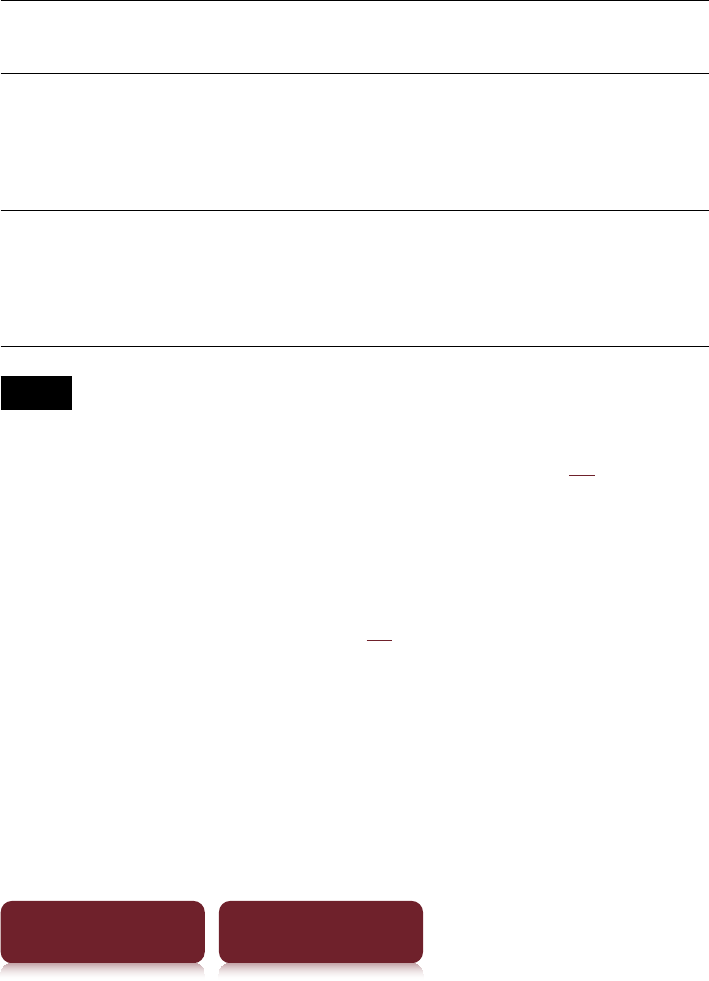
Changing Settings
133
Table of Contents Index
Wi-Fi networks which may be used with Reader
Reader can connect to the following Wi-Fi.
ˎ
Your Home Wi-Fi
ˎ
Your office or school Wi-Fi
ˎ
Public Wi-Di, such as at coffee shops, hotels, or libraries.
Standard IEEE 802.11b
IEEE 802.11g
Security WEP (128 bit/64 bit, Open System
Key)
WPA-PSK (TKIP/AES)
WPA2-PSK (TKIP/AES)
Communication
range
Approx. 50m (160 ft)
(The communication range may vary,
depending on conditions
of use and settings.)
Notes
ˎ
To connect to an access point, the SSID and encryption key
may be required. For the necessary settings (rxx), consult
the person who installed the access point. For the settings
of the access point, refer to the operation guide of the
access point, or consult the manufacturer of the access
point.
ˎ
For the necessary settings (rxx) to connect to a Wi-Fi, ask
the administrator of the network (at office/school) or the
public Internet access service provider.
ˎ
Reader does not support security systems customized in
some access points. For details, refer to the operations
guide for the access point.
ˎ
Reader does not support AOSS (AirStation One-Touch
Secure System).

Changing Settings
134
Table of Contents Index
ˎ
Set the [Wi-Fi] option to [OFF] where the network
connection is restricted or prohibited, such as in a hospital
or in an airplane (rxx).
ˎ
Some public Wi-Fi services require log-in by using the
Internet browser.

Troubleshooting
135
Table of Contents Index
Troubleshooting
If the Reader does not function as expected, try the
following steps to resolve the issue.
1Reset the Reader by pressing the RESET hole
(r10) with a small pin or clip p slide the power
switch to restart the Reader.
The content and settings stored on the Reader are
not affected by resetting.
Notes
ˎ
The bookmarks, highlights, handwritten memos, or the
setting information may be deleted by resetting.
ˎ
The screen will not change after pressing the RESET
hole. Slide the power switch to restart the Reader.
ˎ
Do not push the RESET hole with a breakable point,
such as the graphite of a mechanical pencil. It causes
the RESET hole to be blocked.
2Check the symptoms list (r97).
3If it is an issue regarding Reader Library, check
for information in Reader Library Help.
4Look for information on the support Web sites
(r18).

Troubleshooting
136
Table of Contents Index
Symptoms
Power
Battery cannot charge.
qCharge the battery within the temperature range of 41°F
to 95°F (5°C to 35°C) (r19).
Battery life seems short.
qThe operating temperature is below 41°F (5°C). This is due
to the battery characteristics and not a malfunction.
qThe Reader is discharged automatically even when not in
use for a prolonged period. It is recommended that you
charge the Reader again before turning on the Reader.
qThe battery was not been given enough time to charge
fully. Charge the Reader until the charge/busy indicator
turns off. (The battery icon does not indicate remaining
battery power during charging.)
qBy sliding the power switch, the Reader enters standby
mode in which the battery power is consumed slightly. To
minimize battery consumption, before entering the sleep
mode, slide and hold the power switch for more than 3
seconds to shut down the Reader.
q in the status bar indicates the Reader is playing a track
which consumes the battery power. Go to the playback
screen and pause playback if necessary.
qWhen you are out of the network coverage area for a
while, slide the WIRELESS switch to OFF (rxx). Battery
life can be extended by turning off the wireless feature.

Troubleshooting
137
Table of Contents Index
The Reader cannot turn on.
qMoisture condensation may have occurred. Wait for a few
hours and then turn on the Reader.
qBattery power has been fully depleted. Charge the
Reader by connecting to the computer via the supplied
USB cable (r12).
Screen
Display takes a long time to appear.
qIn a cold place such as outdoors, it may take time for the
display to appear. This is due to the display characteristics
and not a malfunction.
qIt may take a few moments for the Reader start-up screen
to appear after a reset or shutdown.
The screen is frozen.
qReset the Reader by pressing the RESET hole. Then, slide
the power switch to turn on the Reader again (r8).
Touch operation is not effective.
qIf condensation occurs in the touch screen, or dust
attaches to the touch screen, it may cause a malfunction.
For details, see “On Cleaning” (rxx).
qIf any objects are placed on the touch screen, it may
cause a malfunction. When not in use, leave the Reader in
sleep mode, or shut it down.
A page in the Reader Store is not displayed properly.
qThe wireless connection may have been interrupted.
Make sure the WIRELESS switch is set to “ON” and a
wireless network is available (rxx), then refresh the
page using [Refresh Page] in the OPTIONS menu (rxx).

Troubleshooting
138
Table of Contents Index
Wireless feature
You cannot access the Reader Store.
qYou are out of the network coverage area. To check the
wireless status, see the wireless status icon in the status
bar (rxx).
You cannot find a purchased book on the Reader.
qThe wireless connection may have been interrupted
while you were downloading the book. Go to the [My
Account] page in the Reader Store to re-download the
book.
You have received the latest periodical
qThe Reader may have been outside the network coverage
area when the issue was delivered. Go to the [My
Account] page in the Reader Store to re-download the
past issue(s).
Tip
If you cannot find a solution from the above, go to [Help and
Support] from the OPTIONSn menu in the Reader Store (rxx).

Troubleshooting
139
Table of Contents Index
Reading contents
A book cannot be read.
qIf the book has an expiration date, confirm whether the
book has already been expired (r37).
A book that has been transferred from your computer cannot be read.
qEither the Reader, your computer, or both may not have
been authorized. Via Reader Library, go to the [My
Account] page in the Reader Store and authorize the
Reader and your computer.
qYou may have tried to read the content owned by
another user. The content owned by another user may
not have been authorized.
qThe authorization data may have been damaged as a
result of shutting down while reading a content. De-
authorize your computer and the Reader, then authorize
again via Reader Library. Refer to Reader Library Help for
further information.
qThe book may be protected by unsupported digital rights
management. Check the book source for compatibility.
qThe book may contain an unsupported file format. Check
the file format compatibility (r121).
[Continue Reading] does not work, or bookmarks are missing.
qIf the file status has changed (such as in the following
cases), data on [Continue Reading] or notes may be
deleted.
ˎ
A Text/RTF/PDF file is edited.
ˎ
A book purchased with an authorized Reader is read on
another de-authorized Reader by memory card transfer.

Troubleshooting
140
Table of Contents Index
You cannot find a transferred book.
qProtected content on the Reader can be deleted if it is
deleted from your computer after being connected. It is
recommended to manage content using Reader Library.
qBooks being transferred to the Reader by synchronization
are deleted automatically if the same books are deleted
in Reader Library before synchronization. For details, refer
to Reader Library Help.
qDo not delete folders or files from any of the “database”
folder in the Reader. The content or notes may be
deleted.
Playing audio files
An audio file cannot play back.
qAudio files that are not supported by the Reader cannot
be played. For details on supported audio files, see
“Supported File Formats” (r121).
Sound output is not audible.
qIncrease the volume if it is set to low (r11).
qIf sound is not output through headphones, make sure
the headphone plug is firmly inserted in the headphone
jack (r11).
Viewing pictures
A picture cannot be displayed.
qPicture files that are not supported by the Reader cannot
be viewed. For details on supported picture files, see
“Supported File Formats” (r121).
qA large file size of picture may not be displayable, and its
file will not appear in the list. Delete the picture file using
Reader Library.

Troubleshooting
141
Table of Contents Index
Connection to the computer
The Reader cannot be operated.
qThe Reader cannot be operated when connected to a
computer via USB.
Reader cannot charge by your computer
qIf [Charging stopped] is displayed on the screen, check
the conditions to charge the Reader again (rxx). If
charging the Reader by connecting to your computer,
make sure your computer is powered on.
The Reader cannot be recognized by your computer.
qA USB hub or USB extension cable is used for the
connection. Connection via an extension cable or USB
hub is not guaranteed. Connect the USB cable directly to
the computer.
qDisconnect the USB cable from the Reader, then
reconnect it after a while.
qIf the Reader is locked, it will not be recognized by your
computer , set [Device Lock] to [Off] (r93).
qWhile the Reader is connected to a computer, do not turn
on, restart, wake up from sleep mode, or shut down the
computer. These operations may influence the Reader
unrecognizable by the computer. Disconnect the Reader
from the computer before performing these operations.
qUse the supplied USB cable.
qThere may be a malfunction with the USB port on your
computer. Connect the supplied USB cable to another
port on the computer.
qIt may take a while for the software to be recognized by
the computer. Wait for a moment.
qIf none of the above solves the problem, press the RESET
hole of the Reader (r96), turn on the Reader again, and
then reconnect the supplied USB cable.

Troubleshooting
142
Table of Contents Index
Content cannot be transferred to the Reader from your computer.
qThere is not enough free space on the Reader memory.
Check [About] (r89) for free space on internal memory,
then delete unnecessary data.
qThe Reader is not authorized. Authorize the Reader using
Reader Library. Refer to “Authorizing Your Computer and
the Reader Device for eBook Stores” in Reader Library
Help.
Reader Library does not recognize the Reader.
qDisconnect the USB cable from the Reader, then
reconnect it.
The Reader becomes unstable while connected to a computer.
qA USB hub or USB extension cable is used for the
connection. Connection via an extension cable or USB
hub is not guaranteed. Connect the USB cable directly to
the computer.
Memory Card
Content on a memory card cannot be read/played/viewed on the
Reader.
qCheck that the memory card is inserted in the media slot
in the correct direction (r9).
qCheck to see that you are using a memory card that is
supported by the Reader (r114).
qClean the terminal area of the memory card gently with a
soft cloth if it is dirty (r114).
qThe Reader is not authorized, refer to “Authorizing Your
Computer and the Reader Device for eBook Stores” in
Reader Library Help.

Troubleshooting
143
Table of Contents Index
qWhen inserting the memory card into the Reader, it may
take time for the Reader to recognize the content files in
the memory card especially if the number of the content
files stored on the memory card is large.
Content cannot be transferred to a memory card.
qUnlock the erasure prevention switch if it is locked.
qThere is not enough free space on the memory card.
Check [About] (r89) for free space on the memory card,
then delete unnecessary data (r74).
qThe Reader cannot transfer content to memory cards
directly. Use Reader Library to transfer content.
A memory card cannot be recognized on the Reader or Reader
Library.
qIf a memory card is formatted by your computer, it may
become unusable on the Reader and Reader Library.
When formatting a memory card, format it using the
Reader (r95).
Content on a memory card cannot be deleted.
qUnlock the erasure prevention switch if it is locked.
qUncheck the read-only attribute of content from your
computer.
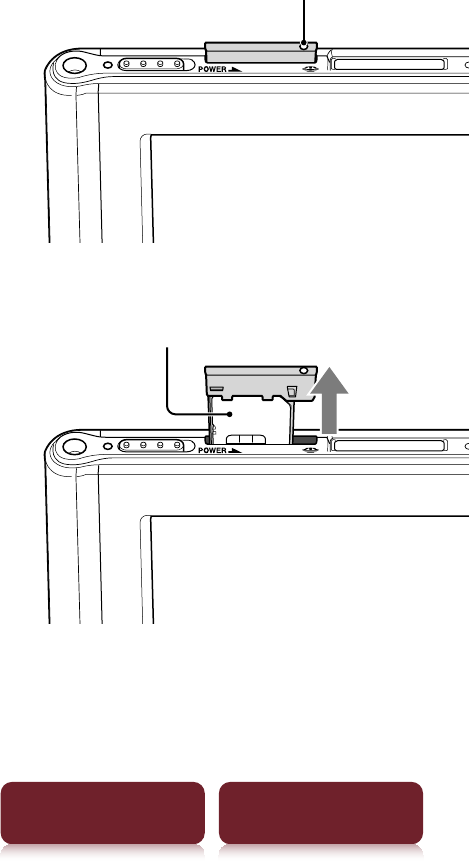
Troubleshooting
144
Table of Contents Index
SIM card
If the following message is displayed: “Your SIM card is not
recognized. Please shut down your Reader, re-insert your SIM card
and turn your Reader back on. ”
qRe-insert a SIM card according to the following
procedure.
1Press the hole of SIM card with a small pin or clip.
Hole of a SIM card
2Pull out the SIM card from the Reader.
SIM card
3Insert a SIM card to the Reader again.

Appendix
145
Table of Contents Index
Precautions
Reader Disposal Reference
The built-in rechargeable battery of the Reader is recyclable. Do not remove the
battery yourself, consult Sony Support Center (r18).
Disposal of Old Electrical & Electronic Equipment
(Applicable in the European Union and other European countries
with separate collection systems)
This symbol on the product or on its packaging indicates that this
product shall not be treated as household waste. Instead it shall be
handed over to the applicable collection point for the recycling of
electrical and electronic equipment. By ensuring this product is
disposed of correctly, you will help prevent potential negative
consequences for the environment and human health, which could
otherwise be caused by inappropriate waste handling of this product. The recycling
of materials will help to conserve natural resources. For more detailed information
about recycling of this product, please contact your local Civic Office, your household
waste disposal service or the shop where you purchased the product. Applicable
accessories: AC Adapter (PRSA-AC1)

Precautions
146
Table of Contents Index
Disposal of waste batteries (applicable in the European Union and
other European countries with separate collection systems)
This symbol on the battery or on the packaging indicates that the
battery provided with this product shall not be treated as
household waste. On certain batteries this symbol might be used
in combination with a chemical symbol. The chemical symbols for
mercury (Hg) or lead (Pb) are added if the battery contains more
than 0.0005% mercury or 0.004% lead.
By ensuring these batteries are disposed of correctly, you will help prevent
potentially negative consequences for the environment and human health which
could otherwise be caused by inappropriate waste handling of the battery. The
recycling of the materials will help to conserve natural resources.
In case of products that for safety, performance or data integrity reasons require a
permanent connection with an incorporated battery, this battery should be replaced
by qualified service staff only.
To ensure that the battery will be treated properly, hand over the product at end-of-
life to the applicable collection point for the recycling of electrical and electronic
equipment.
For all other batteries, please view the section on how to remove the battery from the
product safely. Hand the battery over to the applicable collection point for the
recycling of waste batteries.
For more detailed information about recycling of this product or battery, please
contact your local Civic Office, your household waste disposal service or the shop
where you purchased the product.

Precautions
147
Table of Contents Index
Notice for customers: the following information is only applicable to equipment sold
in countries applying EU directives
The manufacturer of this product is Sony Corporation, 1-7-1 Konan, Minato-ku, Tokyo,
108-0075 Japan. The Authorized Representative for EMC and product safety is Sony
Deutschland GmbH, Hedelfinger Strasse 61, 70327 Stuttgart, Germany.
For any service or guarantee matters please refer to the addresses given in separate
service or guarantee documents.
FCC Compliance Statement:
The following FCC statement applies only to the version of this model manufactured
for sale in the USA.
Other versions may not comply with FCC technical regulations.
NOTE: This equipment has been tested and found to comply with the limits for a Class
B digital device, pursuant to Part 15 of the FCC Rules. These limits are designed to
provide reasonable protection against harmful interference in a residential
installation. This equipment generates, uses and can radiate radio frequency energy
and, if not installed and used in accordance with the instructions, may cause harmful
interference to radio communications.
However, there is no guarantee that interference will not occur in a particular
installation. If this equipment does cause harmful interference to radio or television
reception, which can be determined by turning the equipment off and on, the user is
encouraged to try to correct the interference by one or more of the following
measures:
– Reorient or relocate the receiving antenna.
– Increase the separation between the equipment and receiver.
– Connect the equipment into an outlet on a circuit different from that to which the
receiver is connected.
– Consult the dealer or an experienced radio/TV technician for help.
You are cautioned that any changes or modifications not expressly approved in this
manual could void your authority to operate this equipment.
FCC Radiation Exposure Statement:
This equipment complies with FCC radiation exposure limits set forth for an
uncontrolled environment. This device is designed for hand-held operation only. This
transmitter must not be co-located or operating in conjunction with any other
antenna or transmitter except those transmitters that are factory installed.

Precautions
148
Table of Contents Index
If you have any questions about this product:
Visit:
www.sony.com/readersupport
Contact:
Sony “Digital Book Reader” Customer Support at
1-(866)-962-7669
Write:
Sony Customer Information Service Center
12451 Gateway Blvd., Fort Myers, FL 33913
Declaration of Conformity
Trade Name: SONY
Model No.: PRS-950
Responsible Party: Sony Electronics Inc.
Address: 16530 Via Esprillo, San Diego, CA 92127 U.S.A.
Telephone Number: 858-942-2230
This device complies with Part 15 of the FCC Rules. Operation is subject to the
following two conditions: (1) this device may not cause harmful interference, and
(2) this device must accept any interference received, including interference that
may cause undesired operation.
For customers in the USA and Canada
RECYCLING LITHIUM-ION BATTERIES
Lithium-ion batteries are recyclable.
You can help preserve our environment by returning your used
rechargeable batteries to the collection and recycling location nearest
you. For more information regarding recycling of rechargeable
batteries, call toll free 1-800-822-8837, or visit http://www.rbrc.org/.
Caution: Do not handle damaged or leaking Lithium-ion batteries.

Precautions
149
Table of Contents Index
Safety Information
ˎA SIM card is factory installed. If you take it out, the wireless feature becomes
unavailable.
ˎUse the supplied AC adapter (PRSA-AC1) only. Do not use other AC adapter.
ˎRecorded content is limited to private use only. Use of the content beyond this
limit requires permission of the copyright holders.
ˎSony is not responsible for incomplete recording/downloading or damaged data
due to problems of the Reader or computer.
ˎBe sure not to short-circuit the terminals of the Reader with metallic objects.
ˎIf part of the device that generates heat contacts your skin for a prolonged period,
you may suffer from symptom of burn, such as redness, swelling, even if
temperature is moderate. Avoid prolonged contact, especially if you have sensitive
skin.
ˎReplacement or repair for concerning damage and the crack which are in the midst
of using is not covered by warranty.
ˎPlease do not drop, do not add excessive power.
ˎNever subject the Reader to extremes of light, temperature, moisture or vibration.
ˎNever wrap the Reader in anything when it is being used with the AC adapter. Heat
build-up in the Reader may cause malfunction or damage.
ˎDo not put any heavy object on top of the Reader or apply a strong shock to the
Reader. It may cause a malfunction or damage.
ˎDo not leave the Reader on an unstable surface.
ˎDo not expose the Reader to water. The Reader is not waterproof.
ˎRemember to follow the precautions below.
− Be careful not to drop the Reader into a sink or other container filled with water.
− Do not use the Reader in humid locations or bad weather, such as in the rain or
snow.
− Do not get the Reader wet.
If you touch the Reader with wet hands, or put the Reader in a damp article of
clothing, the Reader may get wet and this may cause a malfunction.
ˎThe screen is delicate and subject to cracking. Handle the Reader with care.
ˎDo not poke people using the supplied stylus.
ˎDo not treat or use the supplied stylus roughly, such as bending it, or scratching
the touch screen with it.
ˎUse the supplied stylus only for touch screen operations.
ˎDo not use the stylus if it is damaged or deformed.
ˎDo not put any cards such as cash cards or credit cards with magnetic coding near
the magnet stored in the Reader. Otherwise, your cards may become impaired due
to the magnetic effect.
ˎIf any objects are placed on the touch screen, it may cause a malfunction. When
not in use, leave Reader in sleep mode, or shut it down.
On heat build-up
Heat may build up in the Reader while charging, or if it is used for an extended period

Precautions
150
Table of Contents Index
of time.
On the headphone
Road Safety
Do not use headphones while driving, cycling, or operating any motorized vehicle. It
may create a traffic hazard and is illegal in many areas. It can also be potentially
dangerous to play at a high volume while walking, especially at pedestrian crossings.
You should exercise extreme caution or discontinue use in potentially hazardous
situations.
Preventing hearing damage
Avoid using the headphones at a high volume. Hearing experts advise against
continuous, loud and extended play. If you experience a ringing in your ears, reduce
the volume or discontinue use.
Caring for others
Keep the volume at a moderate level. This will allow you to hear outside sounds and
to be considerate to the people around you.
Warning
If lightning occurs while you are using the Reader, take off the headphones
immediately.

Precautions
151
Table of Contents Index
On the wireless feature
ˎSONY provides wireless connectivity at no additional cost to you for certain
activities in connection with the content service provided by SONY. You may be
charged a fee for wireless connectivity for your use of other wireless services on
your product, such as web browsing, should those services be available. You will be
notified of the current fees for such services through the content service.
SONY reserves the right to discontinue wireless connectivity at any time or to
otherwise change the terms of service for wireless connectivity at any time,
including but not limited to the amount and terms applicable for wireless
connectivity charges. SONY reserves the right to limit the number and size of data
files that may be transferred using the wireless connectivity.
You agree that you will only use the wireless connectivity provided by SONY in
connection with the content service that SONY provides for your product. You may
not use the wireless connectivity for any other purpose.
Your use of the wireless connectivity may be limited if your product is located in
any area without applicable wireless service coverage, and you may not be able to
use some or all of the wireless services, including the content service. SONY is not
responsible for the unavailability of wireless connectivity or any interruptions of
wireless service.
ˎWireless connectivity is only available in the USA, within the service coverage area.
Connectivity may vary.
ˎTurn off the wireless feature outside the USA. Do not use wireless feature in other
countries.
ˎTurn off the wireless feature when you are in a location in which radio
communications are prohibited. When you are in such a location, you must obtain
permission from the appropriate authorities before enabling the wireless feature of
this device.
ˎTurn off the wireless feature in health care facilities where any regulations posted
in such areas instruct you to do so. Hospitals or health care facilities may be using
equipment that could be effected by radio frequency (RF) energy which is
generated by wireless communication.
ˎFederal Aviation Administration (FAA) and Federal Communications Commission
(FCC) regulations prohibit using the radio of wireless devices while in the air. Turn
off the wireless feature before boarding an aircraft.
ˎDo not use your Reader near medical equipment without first obtaining
permission to do so.
ˎIf you use any personal medical device, consult the manufacturer of your device to
determine whether it may be affected by RF energy.
On software
ˎCopyright laws prohibit reproducing the software or the manual accompanying it
in whole or in part, or renting the software without the permission of the copyright
holder.
ˎIn no event will SONY be liable for any financial damage, or loss of profits,
including claims made by third parties, arising out of the use of the software

Precautions
152
Table of Contents Index
supplied with this Reader.
ˎThe software provided with this Reader cannot be used with equipment other than
that which is so designated.
ˎPlease note that, due to continued efforts to improve quality, software
specifications may be changed without notice.
ˎOperation of this Reader with software other than that provided is not covered by
the warranty.
ˎDepending on the types of the text and characters, the text shown on the Reader
Library may not be displayed properly on device. This is due to:
− The capacity of the Reader.
− The Reader is not functioning normally.
− Content information is written in the language or the character that is not
supported by the Reader.
ˎThe ability to display the languages on your Reader Library will depend on the OS
installed on your computer. For better results, please ensure that the installed OS is
compatible with the desired language you want to display.
− We do not guarantee all the languages will be able to be displayed properly on
your Reader Library.
− User-created characters and some special characters may not be displayed.
ˎExplanations in this manual assume that you are familiar with the basic operations
of Windows or Mac OS. For details on the use of your computer and operating
system, please refer to the respective manuals.
ˎBy updating the Reader device software, you can ensure your Reader has the latest
features. The latest software updates can be performed from the update menu on
Reader Library Help – “Check for Updates”.
About Pre-loaded Contents
Sample content is pre-installed in the Reader so that you can try them out right away.
The pre-installed sample content is for the purpose of trial reading, viewing and
listening.
Note
ˎIf you delete pre-installed sample content, you cannot restore it, and Sony will not supply any
replacement content.
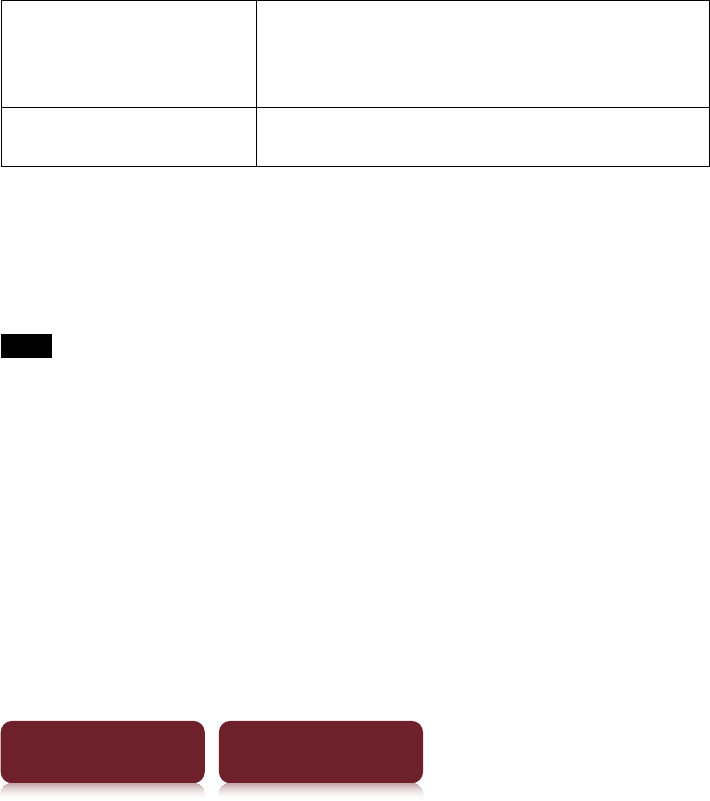
Precautions
153
Table of Contents Index
On cleaning
ˎClean of the Reader with a soft cloth, such as a cleaning cloth for eyeglasses.
ˎIf of the Reader becomes very dirty, clean it with a soft cloth slightly moistened
with water or a mild detergent solution.
ˎDo not use any type of abrasive pad, scouring powder, or solvent, such as alcohol
or benzene, as it may mar the finish of the case.
ˎIn order not to get wet to the water, paying attention.
ˎClean the headphone plug periodically.
ˎTapping or dragging on the touch screen using a dirty stylus may damage the
surface. Wipe the stylus with a dry cloth when it gets dirty.
Notes on memory cards
Remove the memory slot protective card before inserting a memory card (optional).
You can use the following memory cards with the Reader.
Memory Stick Duo™ media Memory Stick Duo™
Memory Stick PRO Duo™
Memory Stick PRO-HG Duo™
Memory Stick Micro™
SD Card SD Card
SDHC Card
About Memory Stick Duo™ media
Memory Stick Duo™ is a compact-size IC recording media with a large capacity. It has
been designed not only for exchanging/sharing digital data among
Memory Stick Duo™ compliant products, but also for serving as a removable external
storage media that can save data.
Notes
ˎSony’s Memory Stick Duo™ media of up to 32 GB has been tested to work with the Reader. But the
proper operation on all types of the Memory Stick Duo™ media is not guaranteed.
ˎSD card of up to 32 GB has been tested to work with the Reader; however, not all SD cards are
guaranteed to work.
ˎThe M2™ Duo-size adapter must be attached to use Memory Stick Micro™ media in a slot for
Memory Stick Duo™ media.
ˎThe file system incorporated in the Memory Stick™ limits the capacity of a file to be transferred to
less than 4GB.
ˎData over 123MB cannot be recorded in a single session.
ˎStandard-size Memory Stick™ media cannot be used on this product
ˎThe maximum number of songs that can be recorded in the Memory Stick PRO™ media is 65535.
About SD card
SD card complies with compact memory card standard and is commonly used as a
storage media for digital still cameras.

Precautions
154
Table of Contents Index
Notes on handling memory cards
ˎInsert into the correct slot with the card’s label side up until it clicks into place.
ˎThe Reader does not comply with the following:
− MagicGate™ standard*.
− copyright protection of SD cards.
* MagicGate™ is the collective name of content protection technologies
developed by Sony.
ˎYou cannot record or delete data stored in a memory card when its erasure
prevention switch is locked.
ˎKeep a memory card in its case when you carry or store it.
ˎDo not touch the connector of a memory card with bare hands or metallic objects.
ˎDo not bend, drop, or subject a memory card to excessive shock.
ˎDo not disassemble or modify a memory card.
ˎDo not allow a memory card to get wet.
ˎAvoid the following to prevent data damage. Sony does not provide any guarantee
for damaged data.
− Do not remove a memory card or turn off the Reader while reading or writing
data.
− Do not operate the Reader in the location where static charge or electrical noise
is present.
ˎDo not use a label other than the dedicated one in the label area.
ˎDo not use or store the Reader in a location subject to:
− extreme high temperature, such as in a sun-heated car.
− direct sunlight.
− high humidity or places with corrosive substances.
ˎDo not insert an incompatible memory card, as it may cause malfunction.
ˎDo not use a deformed memory card or adapter.
ˎIf you attempt to insert Memory Stick Micro™ media without attaching to an M2™
Duo-size adapter, it may become jammed.
ˎDo not remove a memory card from the media slot while data on the memory card
is being edited. Otherwise, edited data will not be saved.
ˎKeep both memory cards and adapter out of reach of small children, to avoid
accidental swallowing.
ˎIf a format process is executed, all the files, even including write-protected image
files, will be deleted.
ˎWe recommend that important data be backed up. If you change or erase a folder
name via PC, or move file to a folder other than “database”, there is a possibility that
data recorded in a memory card might be lost or become unplayable by this
product.
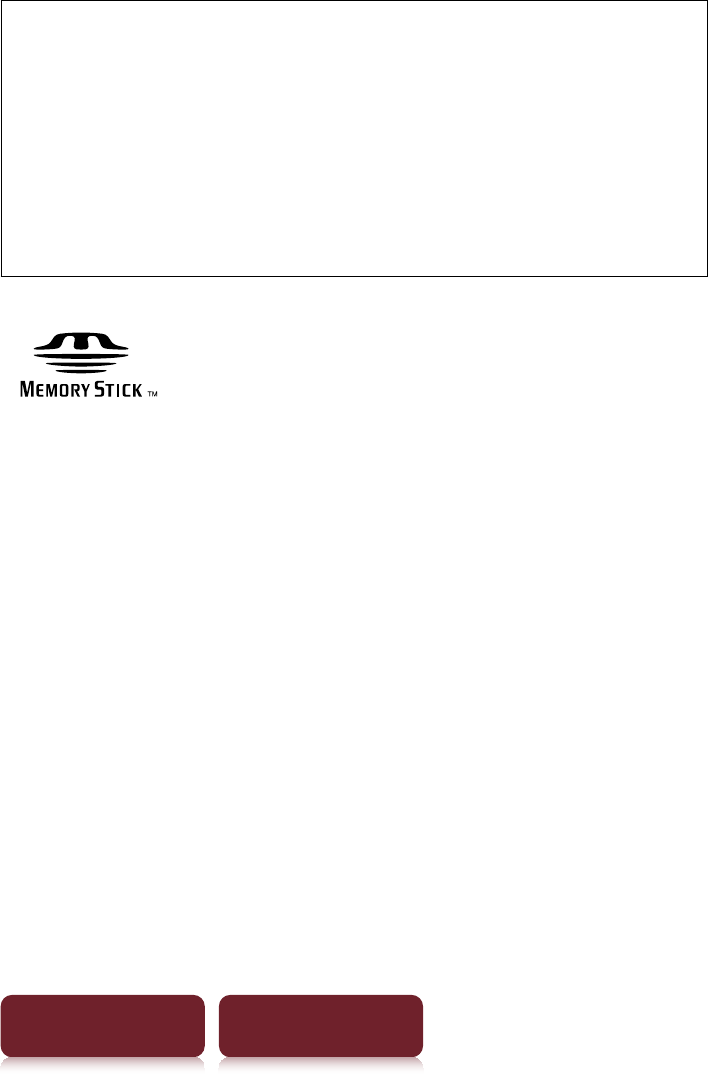
Precautions
155
Table of Contents Index
Copyright Notice
The contents of each book pre-loaded on this product are copyrighted works,
edited with the cooperation of the publisher.
Copyright laws prohibit copying the data of this product or the contents of this
manual (illustrations, related documents, etc.) in whole or in part without the
permission of the copyright holder. Additionally, use of the data of this product or
the contents of this manual is not allowed without Sony’s permission except for
personal use.
Besides individually enjoying, it is against the copyright law to use any audio or
picture you recorded without prior consent of the copyright holder. Accordingly,
Memory Stick™ media with content protected image or data can be only used
within the law.
ˎSony, the Sony logo, “BBeB”, “Reader”, “Reader Daily Edition” and their logos are
either trademarks or registered trademarks of Sony Corporation.
ˎ
, “Memory Stick”, “Memory Stick PRO Duo”, “Memory Stick PRO-HG
Duo”, “Memory Stick Duo”, “Memory Stick Micro”, “M2”, “MagicGate” and their logos
are trademarks of Sony Corporation.
ˎBitstream is a registered trademark, and Dutch, Font Fusion, and Swiss are
trademarks, of Bitstream Inc.
ˎMicrosoft, Windows, Windows Vista and Windows Media are trademarks or
registered trademarks of Microsoft Corporation in the United States and / or other
countries.
ˎMacintosh and Mac OS are trademarks of Apple Inc., registered in the U.S. and
other countries.
ˎThis PRS-950 contains Adobe® Reader® Mobile software under license from Adobe
Systems Incorporated, Copyright © 1995-2009 Adobe Systems Incorporated. All
rights reserved. Adobe and Reader are trademarks of Adobe Systems Incorporated.
ˎMPEG Layer-3 audio coding technology and patents licensed from Fraunhofer IIS
and Thomson.
ˎThis product includes software developed by the OpenSSL Project for use in the
OpenSSL Toolkit. (http://www.openssl.org/) Copyright© 1998-2008 The OpenSSL
Project. All rights reserved. This product includes cryptographic software written
by Eric Young (eay@cryptsoft.com). This product includes software written by Tim
Hudson (tjh@cryptsoft.com). For details on OpenSSL License, refer to “END USER
LICENSE AGREEMENT” in [About] at [Settings] menu on the Reader.
All other system names and product names appearing in this document are the
registered trademarks or trademarks of their respective owners. Further, the
trademark ™ and registered trademark ® symbols are not indicated throughout this

Copyright Notice
156
Table of Contents Index
document.
Program ©2010 Sony Corporation
Documentation ©2010 Sony Corporation

Copyright Notice
157
Table of Contents Index
GNU GENERAL PUBLIC LICENSE
This product contains the following software covered by the GNU General Public
License (hereinafter referred to as “GPL”) and/or GNU Lesser General Public License
(hereinafter referred to as “LGPL”).
You may obtain, alter, and redistribute the source code of these software products.
busybox
dosfstools
freetype
intiscripts
kernel
linux-kernel-headers
make
MAKEDEV
modules
mtd
nandboot
procps
procps
sourceryg++
tar
udev
util-linux
For the terms and conditions concerning GPL and LGPL, please refer to below.
The source code for these software products is available on Sony’s website. To
download, please visit the following URL: http://www.sony.net/Products/Linux/
Please note that Sony accepts no inquiries concerning the content of the source
code.
For details on GNU GENERAL PUBLIC LICENSE, refer to “END USER LICENSE
AGREEMENT” in [About] at [Settings] menu on the Reader.

Supported File Formats
158
Table of Contents Index
Supported File Formats
The following file formats can be managed within
Reader Library and transferred to your Reader.
Book
ˎ
EPUB file (.epub file extension)
EPUB (OPS version 2.0) supported
ˎ
PDF file (.pdf file extension)
Support is based on the PDF 1.6 specification.
ˎ
BBeB (.lrf or .lrx file extension)
ˎ
Text file (.txt file extension)
ˎ
RTF file (.rtf file extension)
ˎ
Word file (.doc or .docx file extension)*
* In case of using Windows, you need Microsoft Word
installed on your computer. Word files will be automatically
converted to RTF files by Reader Library during transfer to
your Reader or a compatible memory card.
Audio
ˎ
MP3 file (.mp3 file extension)
The following specifications should be met in order
to import an MP3 file.
– Bit rate: 32 to 320 kbps
– Sampling frequency: 22.05, 44.1 kHz
– File must be unsecured.
ˎ
AAC file (.mp4, .m4a, .mov, or .qt file extension)
The following specifications should be met in order
to import an AAC file.
– Bit rate: 40 to 320 kbps
– Sampling frequency: 24.0, 44.1, 48.0 kHz
– File must be unsecured.

Supported File Formats
159
Table of Contents Index
Picture
ˎ
JPEG file (.jpg or .jpeg file extension)
ˎ
GIF file (.gif file extension)*
ˎ
PNG file (.png file extension)
ˎ
BMP file (.bmp file extension)
* For an animation GIF file, only the first frame will be shown.
Note
A large file size of picture may not be displayable, and its file
will not appear in the list. Delete the picture file using Reader
Library.

System requirements
160
Table of Contents Index
System Requirements
Reader Library will work with the following operating
systems.
OS Description
Microsoft Windows 7
(32/64 bit)
Windows 7 Starter
Windows 7 Home Basic
Windows 7 Home Premium
Windows 7 Professional
Windows 7 Ultimate
Microsoft Windows
Vista (32/64 bit)
Windows Vista Home Basic with
Service Pack 2 or later
Windows Vista Home Premium with
Service Pack 2 or later
Windows Vista Business with Service
Pack 2 or later
Windows Vista Ultimate with Service
Pack 2 or later
Microsoft Windows
XP (32 bit only)
Microsoft Windows XP Home Edition
with Service Pack 3 or later
Windows XP Professional with Service
Pack 3 or later
Windows XP Media Center Edition
2004 & 2005 with Service Pack 3 or
later
Apple Macintosh
(32 bit only)
Mac OS X version 10.6.3 or later
Mac OS X version 10.5.8 or later
Mac OS X version 10.4.11 or later

System requirements
161
Table of Contents Index
CPU Windows: 800 MHz Celeron class
processor or better
Macintosh: Intel, PowerPC G3, G4 or
G5 processor
RAM 128 MB or more (minimum 512 MB
for Windows 7, Windows Vista)
Free space on hard
disc
Windows: 100 MB or more
Macintosh: 60 MB or more
Depending on the content amount,
more space may be required.
Monitor High Color or more, 1024 × 768 pixels
or more (True Color, 1280 × 1024
pixels, or more recommended)
Other devices USB port (High-Speed USB
Compatible), pointing device such as
mouse or track pad
ˎ
Internet connection (broadband recommended, some fees
may apply) is also required on your computer.
ˎ
Reader Library is not supported by the following
environments:
– An operating system other than those included above
– Personally built computer or operating system
– Multi-boot environment
– Multi-monitor environment
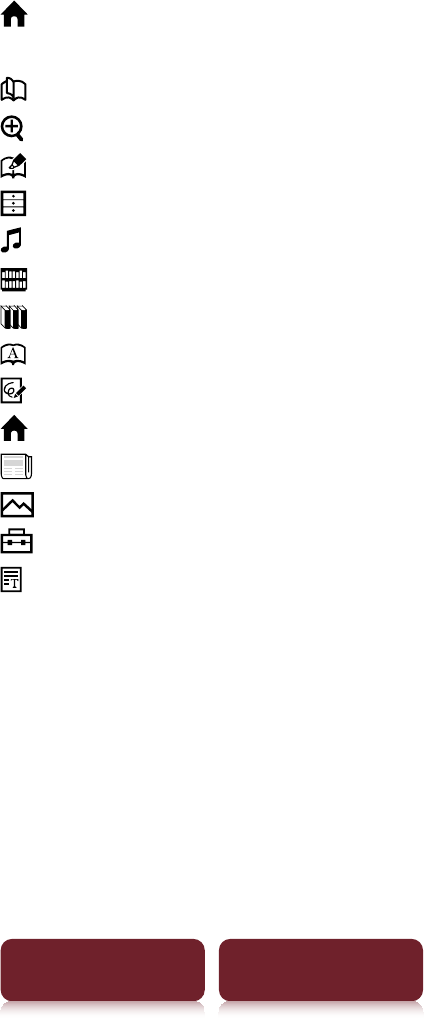
Index
162
Table of Contents Index
Index
Symbols
(Home) button.........10, 29
OPTIONS button ...........10, 31
(Page Turn) buttons.......10
(Size) button.......10, 47, 84
[All Notes] ..................29, 46
[Applications] ...........29, 76
[Audio] .........................76, 85
[Books]........................29, 36
[Collections]..............29, 68
[Dictionary]................76, 82
[Handwriting]...........76, 77
[Home]...............................29
[Periodicals]..............29, 65
[Pictures]...................76, 83
[Settings]...................29, 88
[Text Memo]...............76, 80
[2-Column Split]...................48
[3-Column Split]...................48
A
About the User Guide........22
Adding a note.......................42
Adding contents..................70
Adjusting Content View ....52
All Notes...........................29, 46
Annotation.............................39
Appendix............................. 106
Applications ..........................76
Applications menu..............76
Audio ............................. 85, 122
[About] ....................................89
[Add] .................................31, 69
[Add Bookmark].............31,39
[Add to Collection].......31, 71
[Adjust View] ..................31, 52
[Applications Preference]
.........................................88, 91
B
Basic Operation....................22
Battery status.................13, 30
Bookmarking ........................39
Books .......................................36
[Brighter].................................52
[Books] list..............................36
Conditional icon.............37
Sort...............................36, 34
[Search]..............................34
[Sort]...................................34
[View] .................................34
C
Changing a page mode ....48
Changing dictionary
..................................31, 60, 91

Index
163
Table of Contents Index
Charge/Busy indicator
........................................... 8, 12
Charging the Reader..........12
Battery status...................13
Charge/Busy indicator
...................................... 8, 12
Status indicators during
charging .........................13
USB connector .........11, 12
Changing Settings ..............88
Collections ......................29, 68
Conditional icon ..................37
Copyright Notice .............. 117
Creating a collection ..........68
Creating drawings...............77
Creating text memos .........80
[Change Dictionary] ....31, 61
[Clear Keyboard History]
.........................................89, 95
[Continue Reading].............31
[Create/Edit] ...................33, 41
[Custom] ..........................52, 53
D
Default settings....................95
[Restore Defaults]....89, 95
Deleting a collection..........72
Deleting Content.................74
Dictionary.................60, 82, 91
Changing dictionary
.............................31, 60, 91
[Word Logs: Dictionary]
....................................35, 64
Drawing ....................41, 42, 77
[Darker] ...................................52
[Date and Time]....................90
[Date and Time Format] ....90
[Delete Audio].......................32
[Delete Book] .................31, 74
[Delete Books] ...............31, 74
[Delete Collections] .....31, 72
[Delete Drawing] ..........31, 79
[Delete Drawings].........31, 79
[Delete Issue] ........................31
[Delete Issues].......................32
[Delete Memo]...............31, 81
[Delete Memos].............32, 81
[Delete Notes].......................32
[Delete Pictures]...................32
[Delete Word Logs] ......32, 64
[Details]...................................52
[Device Lock]..................88, 93
[Device Shutdown] .............90
[Dictionary]............................91
E
eBook store............................17

Index
164
Table of Contents Index
F
Features .................................... 4
Finding a Note......................44
Annotation .......................39
Icons and types of note
in the [Notes] list .........45
Finding the notes in all
contents ..............................46
[Format Memory] .........89, 95
[Full Page]...............................48
G
Getting Started....................... 8
GNU GENERAL PUBLIC
LICENSE............................. 119
[General Settings].........88, 90
[Go to]........................32, 57, 59
[History]......................32, 59
[Previous View].........32, 59
[Select Page] .............32, 57
[Table of Contents]........32
H
Handwriting .....41, 42, 76, 77
Finding a Note.................44
[Notes]..................33, 41, 44
Handwriting a note.............41
Headphone jack...................13
Highlighting words.............40
Holes for cover attachment
................................................11
Home Menu...........................29
How to Get eBooks .............17
[Hide]/[Show]........................33
[History] ..................................32
I
Icons and types of note in
the [Notes] list...................45
Issues.................................66, 71
[Info].........................................32
[Initialization].................89, 95
J
Jumping to a Page ..............57
Link...............................22, 59
[Go to] ..................32, 57, 59
[Previous View].........32, 59
[Select Page] .............32, 57
K
[Keyboard] ......................88, 91
L
Link ....................................22, 59
Listing previously looked up
words....................................63
[List]...................................33, 44

Index
165
Table of Contents Index
M
Magazines.......................29, 65
Memory card access
indicator ................................ 9
Media slot................................. 9
Memory card..................9, 113
Memory Stick PRO Duo™
.........................................9, 113
Memory Stick PRO Duo™
slot........................................... 9
[Margin Cut] ..........................48
[Menu Language]................90
N
Newspapers....................29, 65
Note............................39, 42, 44
Annotation .......................39
Bookmarking...................39
Drawing......................41, 42
Finding a Note.................44
Handwriting a note .......41
Highlighting words .......40
[Notes]..................33, 41, 44
[New Collection] ...........33, 68
[New Drawing] ..............33, 77
[New Memo]...................33, 80
[Notes].......................33, 41, 44
[Create/Edit]..............33, 41
[Hide]/[Show] ..................33
[List] .............................33, 44
[Now Playing]................33, 86
O
On-screen keyboard...........26
[Clear Keyboard History]
....................................89, 95
[Keyboard].................88, 91
Operation at book page....38
OPTIONS Menu ....................29
[Orientation]...................33, 54
[Original]..........................48, 52
P
Parts and Controls................. 8
Periodicals.......................29, 65
Pictures.............................76, 83
Slideshow............34, 83, 91
Standby screen
.............................34, 84, 94
Supported file format
........................................ 120
Zooming in................49, 84
[Select Standby Screen]
....................................34, 84
[Slideshow On]/
[Slideshow Off] .....34, 83
[Slideshow]................88, 91
[Standby Screen].....88, 94
Playing audio files ...............85

Index
166
Table of Contents Index
Power saving Tips................14
Power management....88, 92
Charging the Reader.....12
Power saving Tips...........14
Power switch...................... 8
Standby screen
.............................34, 88, 94
[Device Shutdown]........89
Power switch........................... 8
Charging the Reader.....12
Standby screen
.............................34, 84, 94
[Device Shutdown]........89
Precautions......................... 106
Protecting Content .............75
Conditional icon ............37
[Page Mode] ..........................44
[Page Turn Preference].......90
[Power Management]
.........................................88, 92
[Previous View]
...........................32, 33, 59, 62
[Protect Audio] .....................33
[Protect Books] ..............33, 75
[Protect Drawings] .......33, 79
[Protect Issues] .....................33
[Protect Memos] ...........33, 81
[Protect Pictures] .................33
R
Reader Library ......................13
Reading Books......................36
Reading Content..................36
Reading Periodicals ............65
Removing contents ............78
Repeat ..............................34, 87
Reset.........................................96
RESET hole ......................11, 96
Resizing...................................47
[Remove Bookmark]....34, 38
[Remove Content]........34, 73
[Rename Collection]....34, 69
[Repeat]............................34, 87
[Resume Playing]..........34, 87
[Restore Defaults].........89, 95
[Return to List]......................34
S
Screen Orientation..............55
Zoom-in mode................51
[Orientation] .............33, 55
[Screen Orientation]
....................................88, 90
SD card .............................9, 114
SD Card slot ............................. 9
Searching ........................34, 55
Searching for notes within
a book ..................................44

Index
167
Table of Contents Index
Settings ...................................88
Shuffle ..............................34, 87
Slideshow.................34, 83, 91
Sort ....................................34, 36
Specifications........................19
Standby screen.......34, 84, 94
Status bar ...............................30
Status indicators during
charging ..............................13
Stylus.......................................... 9
Support...................................18
Supported file format ..... 121
Symptoms..............................97
System requirements...... 123
[Saturated] .............................52
[Screen Orientation]....33, 54
[Search] ............................34, 55
[Select All]/[Unselect All]
................................................74
[Select Page]...................32, 57
[Select Standby Screen]
.........................................34, 84
[Settings] menu.............29, 88
[Shuffle On]/[Shuffle Off ]
.........................................34, 87
[Slideshow On]/
[Slideshow Off] ..........34, 83
[Slideshow] ............................91
[Sort] ........................................34
[Standby Screen] ..........88, 94
[System Management]
.........................................88, 92
T
Text Memo ......................76, 80
On-screen keyboard......26
Touch screen ..................10, 23
Troubleshooting ..................96
[Table of Contents] .............32
U
USB connector...............11, 12
Useful Features....................... 4
Using an Embedded
Dictionaries .................60, 82
V
Viewing pictures..................83
Volume button..............11, 87
[View].......................................34
W
[Word Logs: Book]........35, 63
[Word Logs: Dictionary] ....35
[Word Logs: Periodicals]....35
Z
Zooming in .....................50, 84